#here's what it taught me about B2B sales
Explore tagged Tumblr posts
Text

#mega man battle network#mega man battle network meme#mmbn#mega man#battle network#mega man meme#rockman.exe#rockman meme#rockman#megaman#megaman meme#megaman.exe#hikari netto#netto hikari#lan hikari#b2b#b2b sales#here's what it taught me about B2B sales#LinkedIn#TEDx Talk#ted talks#WWW#capcom#nintendo#gameboy advance#gameboy#enzan ijuuin#mayl sakurai#sakurai meiru#maylu sakurai
16 notes
·
View notes
Text
A Step-by-Step Technique for B2B Pillar Pages
New Post has been published on http://tiptopreview.com/a-step-by-step-strategy-for-b2b-pillar-pages/
A Step-by-Step Technique for B2B Pillar Pages
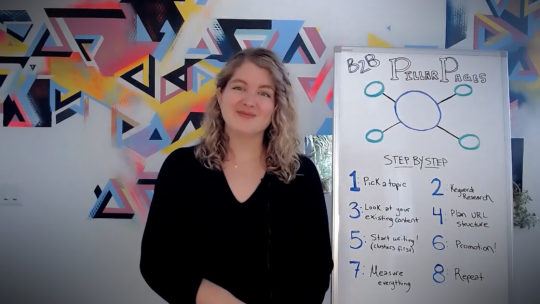
The writer’s views are solely his or her personal (excluding the unlikely occasion of hypnosis) and should not all the time mirror the views of Moz.
B2B corporations are actually centered on the center of the gross sales funnel. They have nice e-books, a lot of good knowledge printed, however they have a tendency to neglect the top-of-the-funnel content material. That kind of content material is definitely essential to B2B success, because it permits your potential clients to be taught extra about your model.
An effective way for B2B corporations to fill this hole is by creating pillar pages. To assist get you began, in immediately’s Whiteboard Friday, visitor host Carly Schoonhoven of Obility walks you thru a easy technique for using pillar pages in your web site. Take pleasure in!
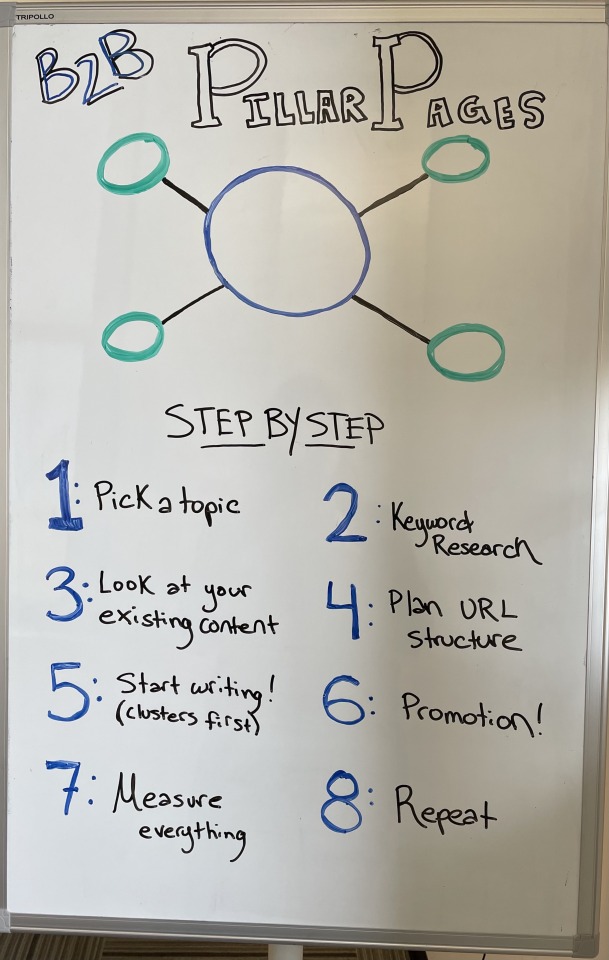
Click on on the whiteboard picture above to open a bigger model in a brand new tab!
Video Transcription
Good day and welcome to a different version of Whiteboard Friday. My identify is Carly Schoonhoven, and I am a senior search engine marketing supervisor right here at Obility. We’re a digital marketing company centered on B2B in stunning Portland, Oregon.
Now one of many largest struggles I discover that B2B corporations have, when engaged on a content material technique, is easy methods to create content material that is capable of successfully rank for these top-of-funnel, increased search quantity, extra conversational queries. Numerous instances B2B corporations are actually centered on mid-funnel. They have nice e-books, a lot of good knowledge content material, however they have a tendency to neglect the top-of-the-funnel content material.
Nevertheless, that kind of content material is so necessary as a result of it permits in your potential clients to carry out self-discovery and actually be taught extra about your model, be taught extra concerning the trade you are in earlier than they’re able to take a extra significant step, like filling out a kind or requesting a demo. So one nice content material technique for a B2B firm is making a pillar web page.
What are pillar pages?
Pillar pages, you might need heard them known as hub and spoke content material or umbrella content material, however no matter you wish to name it, it is basically the identical factor. So the concept is that you simply begin together with your pillar web page. So that is one massive piece of content material that is actually optimized for one very broad subject that is actually related to your enterprise.
Then it internally hyperlinks out to your cluster pages, that are focused at these longer tail, secondary key phrases and actually well-optimized to reply the questions that your clients could have. It is so necessary that you simply’re linking again from the cluster pages to the pillar web page and from the pillar web page out to your clusters.
Once more, this has a number of advantages. One which your clients are capable of navigate to this content material and get their questions answered themselves. Then, on the identical time, it is nice for search engine marketing as a result of it is really easy for Google to inform what this content material is about because it’s all internally linked to one another and it is all centered on one particular subject. So if this feels like one thing for you, I will stroll you thru step-by-step easy methods to go about making a pillar content material technique.
1. Choose a subject
So Step 1, in fact, is it’s important to choose a subject. So there are a pair belongings you need to bear in mind if you’re doing this, one in all which is that you really want it to be broad however not too broad. So clearly it needs to be considerably broad since you want to have the ability to discover sufficient secondary key phrases that even have search quantity that it is price your time placing the work in.
But when it is too broad, it should be actually tough to create one piece of content material that covers every thing it’s essential cowl on this content material. So, for instance, a pillar web page about search engine marketing as a complete, that may be somewhat bit too broad. There’s lots of stuff you are going to must cowl, and it should be actually tough to rank for lots of these key phrases. However one thing like search engine marketing content material technique, that is somewhat bit extra centered, there’s nonetheless lots of potential there.
You may speak about ideating content material for B2B. You may speak about on-site optimization. So one thing that’s undoubtedly broad, has a lot of key phrases, however not so broad you are biting off greater than you may chew.
2. Key phrase analysis
So talking of key phrases, clearly it’s important to do key phrase analysis. That is search engine marketing.
It is so necessary. So you can begin with that one subject, however then you really want to broaden your record of key phrases to search out all of these secondary key phrases that you simply wish to embrace. Moz’s Key phrase Explorer is a superb instrument for this since you’re capable of put in your subject after which it can generate all of these associated key phrases for you, together with issues like search quantity and key phrase problem. I additionally love that you may filter down to only the key phrases which can be questions, as a result of once more it is so necessary to just remember to’re answering your potential clients’ questions in your content material.
three. Take a look at your present content material
So you have obtained your record, you have obtained your key phrases, however do not forget to have a look at your present content material as nicely. So you are going to be placing lots of work in. Discover methods it can save you your self time. Possibly you may have some content material buried in your weblog or buried in your useful resource part that you may repurpose and embrace as a part of this technique. Positively be sure you’re not neglecting content material that you have already got.
four. Plan URL construction
Up subsequent, planning your construction. So you are going to be creating an ideal new piece of content material. You’ll want to know the place you are going to put it. You may simply hyperlink to it in your high navigation, or perhaps you simply wish to characteristic it in your sources part. However one factor to bear in mind is that you simply wish to be sure that your cluster pages are in a subfolder of your pillar web page.
5. Begin writing (clusters first)
All proper, Step 5, begin writing. You truly get to begin placing these items collectively. So finally, what would you like them to appear to be? Now ideally, in your major pillar web page, what you need is to have type of simply an introductory part speaking concerning the subject space as a complete, however actually this web page serves as that hub that hyperlinks out to all your different secondary pages.
So that you wish to make it very easy to navigate. You wish to be sure you’re together with a lot of mid-funnel CTAs inside that content material, as a result of finally that is that hub piece of content material the place everybody goes to navigate to from these cluster pages. So begin together with your intro after which have a pleasant desk of contents after which somewhat header for every of your cluster pages with somewhat little bit of a abstract, however then that finally hyperlinks out to these cluster pages so that somebody can go to that web page in the event that they actually wish to be taught extra and get extra in depth into that subject.
So far as your cluster pages, that is the place you actually wish to get in depth, spend lots of time placing your content material collectively and be sure you’re masking it. I believe that the question-and-answer format is a very good method for such a content material as a result of it actually helps you optimize for featured snippets or for the individuals additionally ask characteristic. So that you wish to just remember to’re placing your query within the header, after which summarize the reply to that query in about 40 to 50 phrases should you’re optimizing for a snippet.
6. Promotion
All proper. Quantity 6 is promotion. So you have created your content material. You’ve got discovered the place to place it. You’ve got printed it. You probably did all of this work. You wish to make certain individuals see it.
So put it on the market internally. Ensure you’re sharing it in your social media. Share it together with your workforce. However then additionally flex your hyperlink constructing expertise and attain out to anybody in your trade who you assume would profit from this content material or be keen to share it as nicely.
7. Measure every thing
Quantity 7 is measure. So, in fact, you set all this work in and also you wish to see how does it do. Did it carry out nicely?
So you could have your record of key phrases, so use Moz to trace your key phrase rankings. Have a look to see if there are new key phrases you were not anticipating to rank for. Clearly, key phrases are tremendous necessary. Additionally, have a look at Google Analytics. Try your touchdown web page report. Are you getting natural site visitors? Are individuals truly changing?
See what you may be taught from that, if it’s essential make tweaks, swap out your CTAs. Simply be sure you’re measuring and you do not let this content material go to waste. You are bringing on this new site visitors. Ensure you’re changing these individuals.
eight. Repeat
Step eight, repeat. So upon getting the method down, do it once more. Discover different matters which can be actually related to your trade you may create a pillar web page about.
If you do, inform me about it. I actually hope that this was useful for you, and I hope you go on the market and create some pillar content material. So thanks a lot.
Video transcription by Speechpad.com
Tweet your questions and feedback about pillar pages utilizing #MozBlog!
Source link
0 notes
Video
youtube
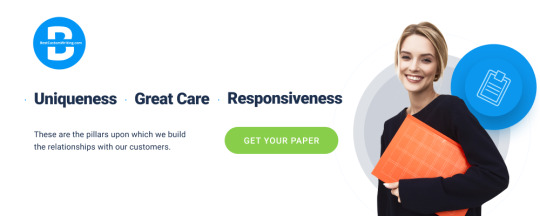
paper writer
About me
27 Best Freelance White Paper Writers For Hire In September 2020
27 Best Freelance White Paper Writers For Hire In September 2020 Get all the essential components throughout that you would be placing in your own CV when you were seeking to get employed for a high-worth position. Ok, so I mentioned this above, but issues this essential are value repeating. Most importantly, and to reiterate above, be honest and clear. Investors can inform if you’re hiding behind false statements and overselling through hyperbole. In order to augment sales leads, you have to consider out-of-the-box concepts. It is better to decide on a mix of assorted methods and see what works on your specific model. Myriad content material is out there on the internet, but what makes your content stand out among the many sea of information is a catchy title. This is people buying into people, so make them learn like folks. Think of this part as micro resumes for every member of the project and write it as such. Since Ripple and Ethereum ran profitable ICO campaigns back in 2013 and 2014 respectively, ICOs have turn out to be the de facto fundraising mechanism for Blockchain firms. Unfortunately, there isn’t a clearly stated or protected process for what Blockchain companies ought to do with their ICO income, resulting in an trade of fraudulent ICOs. The most recent case of this wasthe arrest of Centra’s two founders. Jeremy spent 20 years as a B2B writer, creating publications concentrating on the personal equity and fast development business sectors before launching Equinet Media in 2009. Unauthorized use and/or duplication of this material with out categorical and written permission from this weblog’s author and/or proprietor is strictly prohibited. Striking this stability is necessary, and in some circumstances blockchain startups favor to create two documents to accommodate the technicalities and legal requirements. More recently there was a movement away from ICOs to TGEs – Token Generation Events. This has coincided with a transfer away from pure utility token utilization to the inclusion of safety tokens which can confer rights to the holder, similar to voting rights or operate similar to firm shares. As against a coin ‘offering’, these coins are generated with a selected purpose and their worth is derived from a tradable asset. Subsequently, this does imply that safety tokens are liable to the SEC in the US, and different monetary governmental agencies around the world. Excerpts and hyperlinks could also be used, offered that full and clear credit is given to EOS Surfaces and EOScu Blog with appropriate and specific direction to the unique content. Either to assist them do their job better, to help them perceive a classy know-how or to help them solve a difficult problem. In turn, this helps set up your company as a trusted adviser and reputable provider of your specific services or products. It is essentially the most seen part of your content material and the first thing to be noticed by the reader. The content material produced at Writing Metier will only be shared with the one that hired us for our providers. Under no circumstances will your content material be used wherever else. Synthesis of the results and transition towards the business plan. The 7th and final step is the synthesis of all the information gathered, a transition phase that will permit you to get began on your financial plan and the drafting of your business plan . Our team determines what sort of emails get opened the most depending on the wording, graphics, timing and even color scheme. We educate our complete staff on new concepts and take time to train them on updates, helping them to maneuver in the best course. The distribution strategy holds equal importance to that of high quality content material. Through the course of the document, the reader is taught to understand a difficulty and remedy an recognized drawback via the lens and opinion of your brand or enterprise. You will also wish to beautify the paper, creating graphics that may spotlight the copy and do the content justice. A high tip is to pick key quote and figures, and pull them out from the textual content to be highlighted. The reader’s eyes might be drawn right here and these points will take advantage of enduring impact on them. Here is the place you should define your marketing plans, what shall be invested in this area and what you hope to achieve with it. Transparency and slightly bit of earnest are extremely necessary in getting folks on your side. Well, in case your readers can’t see the necessity for your answer within the first place, everything else in your document is an absolute waste of time. If the documentation is too closely technical you run the risk of alienating your audience, and if it’s not technical sufficient, it will really feel flimsy and as if there’s not sufficient meat to support the skeleton. Operating from a spot of selling & sales alignment wherein marketing takes over the responsibility of nurturing of leads before passing them on to the sales group helps in optimizing the conversions. Marketing & sales endeavors must be aligned & shouldn’t be operating in silos.
0 notes
Video
youtube

professional writing services
About me
Only Professional Writers For You On Supremedissertations Com
Only Professional Writers For You On Supremedissertations Com A-Writer stands its floor as probably the greatest faculty essay writing companies within the industry. In over a decade of expertise, we established an impeccable reputation amongst students from all around the world. Our reasonably priced costs make the service even more engaging. Writer’s block is having an excessive amount of time on your arms. If you've a restricted period of time to write down, you just sit down and do it. You may not write well every day, but you can at all times edit a bad web page. In consequence, the members of my household by no means pay the slightest consideration to my being a writing man — they make all of the noise and fuss they want to. Perhaps most importantly, write for an viewers of one — your self. Write the story you need to inform and want to learn. It’s inconceivable to know what others need so don’t waste time attempting to guess. Just write concerning the issues that get beneath your skin and keep you up at night time. When it pulled out of the driveway and left me with out anyone to take care of, that was the moment my writing day began, and it ended when the varsity bus got here again. She works with medium and enormous organizations on messaging, branding and communicating with target audiences. Her out-of-the-field pondering and enterprise savvy assist organizations stand out from the gang. Be positive to follow Megan on Twitter beneath the name “TellYourTale”. Megan can be a published author, writing the guide a hundred+ Activities for Houston Kids. Many leaders really feel their business is so distinctive that they can’t leave the writing to somebody exterior their business. This is somebody who is skilled in writing tutorial content as much as the best requirements. They will use their intellect, data, and creativity to tailor the proper paper for you. As a working mom, my working time was constrained. On the other hand, I’m immensely grateful to my family for normalizing my life, for making it a requirement that I end my day in some unspecified time in the future and go and make dinner. My kids have taught me every thing about life and concerning the sort of person I want to be on the earth. It’s also true to say that being a writer has made me a better mother. Think about it — when you have been blocked in college and needed to write a paper, didn’t it always manage to repair itself the night earlier than the paper was due? Megan F. Salch has 20 years of promoting and communications experience. Senate in addition to for a software program firm, Arthur Andersen and research firm APQC, Megan launched Tell Your Tale in 2005 to assist organizations talk often and intentionally. That’s a healthy thing, to set work aside and make dinner and eat it. It’s wholesome to have these folks in my life who assist me to carry on a civilized routine. And also to have these individuals in my life who join me to the broader world and the future. A writer who waits for perfect conditions under which to work will die without placing a word on paper. The director of her personal copywriting firm, Gill writes B2B and B2C content material for SMEs and digital advertising agencies. She has a background in performing arts and writes conversational, direct sales copy for companies on a range of subjects. Thus, administration usually holds onto writing assignments that get put on the back burner. However, a fantastic author can interview an expert by telephone and then write the piece for the consumer’s review.
0 notes
Video
youtube

professional writing service
About me
Creative Writer
Creative Writer We satisfaction ourselves on delivering high-notch content material. To assist this, each content material writer accepted onto our platform should move a quiz and writing sample. Constant Content allow you to find, rent, and manage professional freelance writers. We work with hundreds of talented writers, they usually’re ready to go to work for you. Perhaps most importantly, write for an audience of 1 — yourself. Write the story you have to inform and want to learn. It’s inconceivable to know what others need so don’t waste time trying to guess. Just write in regards to the issues that get under your pores and skin and maintain you up at night time. When it pulled out of the driveway and left me with out anybody to take care of, that was the second my writing day started, and it ended when the varsity bus got here again. As a working mother, my working time was constrained. On the other hand, I’m immensely grateful to my family for normalizing my life, for making it a requirement that I end my day in some unspecified time in the future and go and make dinner. That’s a wholesome factor, to set work apart and make dinner and eat it. It’s healthy to have these folks in my life who help me to hold on a civilized routine. The content material of mentioned papers is unique and passes plagiarism checkers. A good number of autobiographies and memoirs of very famous, important people are ghostwritten. These people get the writing credit, and the ghostwriter gets paid. Those are the basics of a very traditional course of. Some consider it unethical for college students to hire skilled ghostwriters for his or her essays and different classwork. In reality I’d argue that professional writers are a useful software on the disposal of students with entry. The director of her own copywriting agency, Gill writes B2B and B2C content for SMEs and digital advertising businesses. She has a background in performing arts and writes conversational, direct sales copy for businesses on a spread of topics. So, whether you want weblog writers to create content material for the company weblog, copy writers to craft touchdown web page copy, or an e book author to place collectively a protracted-form useful resource, we’ve received you lined. We work with a variety of freelance content writers, specializing in different niches and content material varieties. A skilled author will work with you to find out one of the best methods to succeed in your target audience online. Notice what number of wonderful writers begin writing within the morning? They work on their targets before the remainder of the day will get uncontrolled. They aren’t questioning once they’re going to write down and so they aren’t battling to “fit it in” amongst their daily activities because they are doing crucial factor first. Writing for digital channels doesn’t cease with internet pages and blogs. Think concerning the character constraints on Twitter, LinkedIn, Facebook, Instagram and the numerous other social channels. Being in a position to write concisely and successfully is a ability that usually is developed after years of apply. In our quick-paced world, the proper word alternative results in engagement with prospects and prospects, whereas the word selection that’s not fairly proper means a submit rapidly will get handed over. I actually have met so many individuals who say they've got a book in them, however they've never written a word. To be a writer — this will seem trite, I understand — you must actually write. You have to write down every day, and you have to write whether you feel prefer it or not. They typically get trapped by over-rationalization, when simply sticking to the information is what is needed to get the point throughout. This process of interview and write is, in fact, how reporters write their articles. They sometimes aren’t experts at the matter however are authorities at culling together details, asking questions that dig into the small print and writing a tale that brings every little thing together. And additionally to have these folks in my life who connect me to the wider world and the longer term. My youngsters have taught me everything about life and about the sort of particular person I wish to be in the world. It’s also true to say that being a author has made me a greater mother. Paying a reliable, credible, clever author to ghostwrite your school papers is defending your funding. PEN America is a company of writers and their allies, and that solidarity is rarely extra important than throughout a global disaster such as we face within the coronavirus pandemic. PEN America is expanding its lengthy-standing Writers’ Emergency Fund as a part of our efforts to assist the literary neighborhood at a time when the well being and livelihoods of so many are at risk.
0 notes
Text
30 Lessons After 30 Million SEO Visitors

As you can see from the screenshot above, I’ve driven 30 million visitors to my website from SEO.
Technically it’s more, but who’s counting.
What’s funny, though, is I barely look at my traffic, even as Google continually rolls out algorithm updates.
I know that sounds contradictory because if you are an SEO, why wouldn’t you obsess about traffic, right?
Well, it’s because I’ve learned some hard lessons over the year… mainly because I’ve made a lot of mistakes.
So today, I wanted to share them with you so that you can learn from my mistakes… so here goes:
Lesson #1: Don’t obsess over rankings, obsess over conversions
I used to check my rankings every single day. Literally.
On top of that, I would log into Google Analytics 4 to 5 times a day and continually check my traffic.
That’s all I cared about back in the day… boosting my organic traffic.
But here is the thing: As my rankings and traffic went up over the years, my revenue didn’t go up proportionally.
For example, during one quarter in 2017, my SEO traffic went up 39.52%, but my revenue from SEO went up only 4.29%.
I quickly learned that traffic isn’t everything. If you can’t convert the traffic into revenue it doesn’t matter.
That taught me that you need to focus on the right keywords that drive conversions and continually optimize your site for conversions.
An easy first step for you to take is to install Crazy Egg and run a heatmap to see where people click so you adjust your design and copy to get more sales.

Lesson #2: The easiest way to grow your SEO traffic is international expansion
You already know that I get a lot of SEO traffic, but do you know what country drives most of my traffic?
If you guessed United States, you are wrong.
Brazil is my most popular region, followed by India.
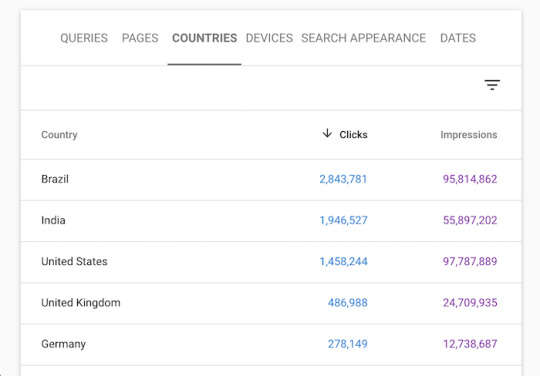
International SEO is the easiest way to expand and grow your traffic. Here are a few posts that you should read before you expand your SEO globally:
How to create a global SEO strategy
Fundamentals of international SEO
How to correctly setup your site for international SEO
How to profitably expand your SEO globally
Lesson #3: Keywords are very, very, very, very important
When I used to write my content, I didn’t obsess about the keywords when I should have.
My team actually proved me wrong on this.
I used to focus on writing content for humans and didn’t worry about search engines. My team, on the other hand, obsesses about keywords.
Just look at the growth of our traffic in Brazil because of our obsession with the right keywords.

One simple thing I do before writing that has really helped is I head over to Ubersuggest and type in a few of the keywords that I want to go after.
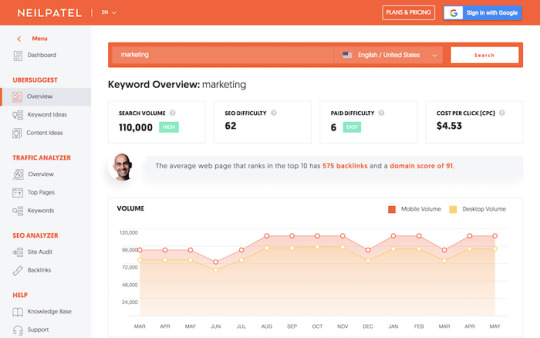
Once it loads, you’ll see a report like the one above. I want you to then click on “Keyword Ideas” in the left-hand navigation.
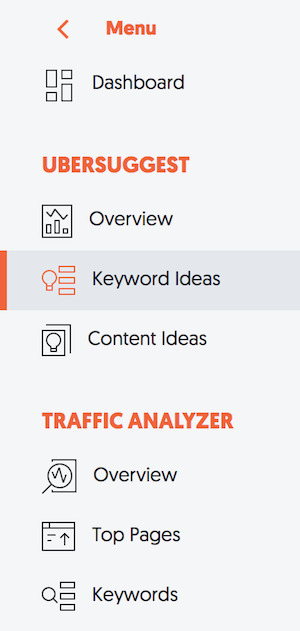
You’ll see a report that contains a list of keywords that you could potentially be targeting.
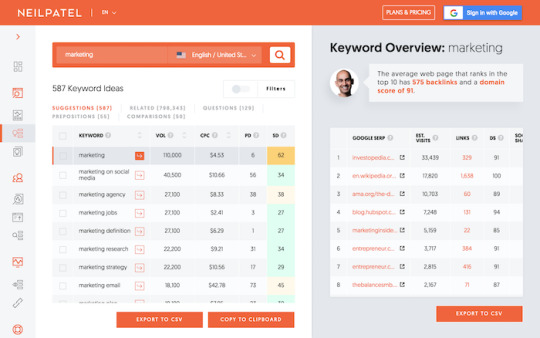
Make sure you click on the “Related” tab, as well as “Questions” and “Comparisons” … scroll through the list. You’ll see hundreds of keywords. Pick all of the ones that are relevant and ideally have a high cost per click (CPC). These are the keywords that’ll not only drive traffic but revenue as well.
Whenever I write a blog post, I go through this step. Every single time.
Lesson #4: AMP pages can drive more SEO traffic
AMP pages load faster on mobile devices than non-AMP pages.
If you aren’t familiar with the AMP framework, read this.
What most people won’t tell you about AMP pages is that:
In regions like the United States, Canada, and the United Kingdom, countries with decent Internet infrastructure, you won’t see much of an increase in traffic.
In regions with poor Internet infrastructure, like Brazil, you’ll see a 10 to 15% lift in mobile SEO traffic by having AMP pages.
AMP pages don’t convert visitors into customers as well as normal responsive web design. So, you’ll have to work on testing your AMP pages so you can boost your conversion rates.
Lesson #5: SEO will never convert as well as paid ads
When I started off with SEO, I would run projections on how much the traffic would make me.
But the numbers were always off, even if I was able to get the rankings.
Here’s the main reason: If you are bidding on terms like auto insurance through ads, you can drive people to a landing page that looks like this:
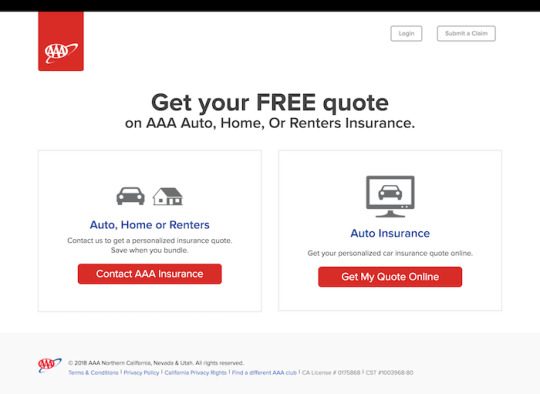
But if you want to rank organically, you’ll have to do it through content. So, your page that ranks well will look more like this and convert less…

It doesn’t mean SEO is bad. In reality, it’s much cheaper in the long run than paid ads and will produce a better ROI. But don’t just assume that if you get 100 visitors from paid ads and 3 purchases that you’ll have the same conversion rate with your SEO traffic.
Chances are it will be significantly lower by maybe 2 or 3x, but because SEO is cheaper, it will be much more profitable.
Lesson #6: Remarketing is one of the best ways to generate an ROI from SEO
If you get a ton of traffic from SEO, there is a simple strategy you can implement to boost your conversions.
Remarket everyone on Facebook, Google, and YouTube.
That way people come to your site, read your content, and build trust with you and your brand.
Then you remarket them throughout the web with ads that prompt your products or services and send them to a landing page that will drive sales.
I’ve been doing this for years, just look at my old remarketing ad…

For the regions I use remarketing in, it is responsible for 46% of my leads.
Lesson #7: Don’t forget to update your old content
I publish one new blog post a week. I’m working on increasing this as I get more time, but for now, it is one a week.
Can you guess how many blog posts I update on a daily basis? Technically it is 0 (me at least), but my team focuses on updating at least 3 old blog posts per day. That’s roughly 90 a month.
Once you have a few hundred pages, make sure you focus on updating your old content or else your traffic will quickly drop.
You can use this content decay tool to see which posts you should update first.
This will help you continually grow your SEO traffic instead of hitting plateaus or seeing your traffic take massive drops.
Lesson #8: Don’t forget to optimize your title tags
One of the easiest ways to grow your rankings is to optimize your title tags.
If you can write persuasive copy and get more clicks, you’ll quickly move up on Google.
In Brazil, we spend more time doing this than we do in the United States.
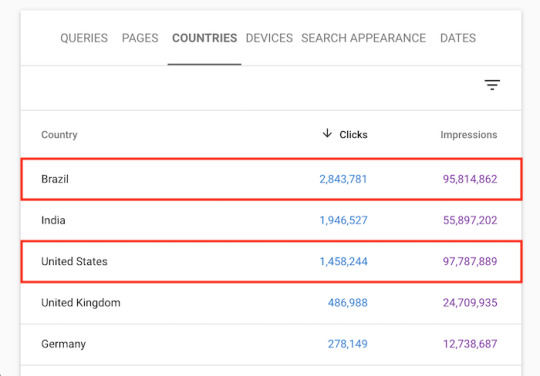
We get a similar amount of impressions in Brazil, but we have more people focusing on improving our title tags and testing. Hence, we get 95% more SEO traffic in Brazil.
If you want tips on boosting your clicks, check out this article.
Another simple hack is to use the “Content Ideas” report in Ubersuggest.
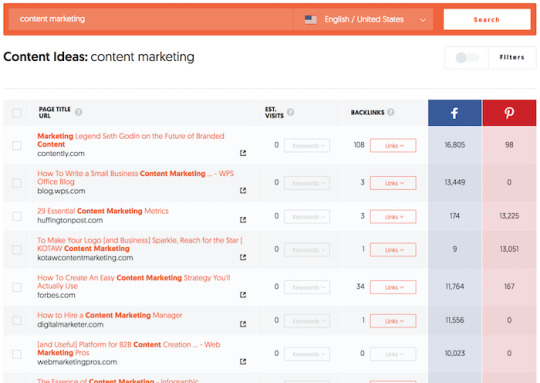
On the right side of that report, you can see social share counts from Facebook and Pinterest. And on the left side, you see titles of articles.
Typically, if people like a title they share it more. So, look for titles that have a lot of shares as it will give you ideas on what you can use on your website to get more clicks and boost your rankings.
Lesson #9: Don’t put dates in your URL
I used to put dates in my URLs like:
Neilpatel.com/2017/12/title-of-post/
This causes search engines to assume that your content is related to a specific date. And after that date gets old, search engines assume your content is irrelevant and outdated.
The moment I removed the date from my URLs, I grew my SEO traffic by 58% in 30 days.
youtube
If you have dates in your URL, make sure you 301 redirect your old URLs to your new ones once you make that change, or else your rankings will drop.
Lesson #10: Don’t be afraid to use popups
Don’t you hate popups? Well, who doesn’t?
But people use them because they work.
The majority of your pages that will rank are blog-related content. And blog posts tend to drive fewer direct conversions because people are on your site to read the content.
In order to maximize your conversions from SEO, you should consider using exit popups so you can convert more of those visitors into customers as they leave.
When you leave this site in most cases, you’ll see a popup that looks like:

And it drives you to this quiz, which allows me to convert SEO visitors into customers.
You can easily copy me by using Hello Bar. It works for all industries including B2B and ecommerce and even lead generation sites.
Lesson #11: Brand queries affect rankings
Everyone talks about how you need links to boost rankings.
But very few people talk about brand queries.
As Google’s ex-CEO and ex-head of web spam both emphasized how brands are important.

One of the big reasons for my growth in SEO traffic is the growth in my brand. I’ve seen a direct correlation in which the more people who find me from my name, the more SEO traffic I get.
Just look at my brand growth over time:
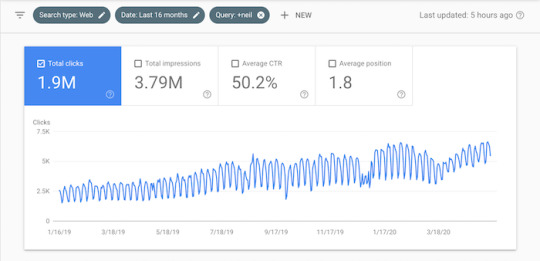
I’ve received over 1.9 million visitors over the last 16 months from people typing in variations of my name in Google.
Lesson #12: Don’t waste your money on paid links
I’ve been doing SEO since I was 16 years old. That’s a long time…
When I started off as a kid, I dabbled in paid links and I used to dominate Google for terms like online casino, online poker, web hosting, auto insurance, and even credit cards.
And I was making a killing off of affiliate income from these sites.
But it was all short lived.
Why?
Because I bought links. And eventually Google penalized all of those sites.
If I never purchased links, those sites would have taken longer to rank, but they would have been around today, and I would have generated more income overall.
Don’t buy links, it’s bad and shortsighted.
Lesson #13: Guest post to build a brand, not to build links
I already covered the importance of branding above.
A great way to build your brand and indirectly boost your SEO traffic is through guest posting.
But don’t use guest posting to build links.
Most sites that offer guest posts, nofollow them (which they should), and Google is smart enough to know what a guest post is, hence they ignore guest post links from sites like Forbes.
It’s pretty easy to spot a guest post for both a human and algorithm…
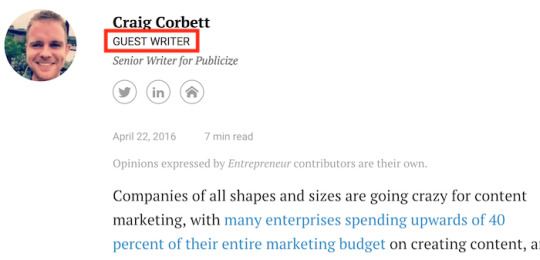
But if you are using it to build a brand, great. Focus on the content quality and not links.
Lesson #14: Don’t forget to interlink
Do you know what some of my highest ranked pages are?
The ones that are interlinked.
It takes anywhere from 6 months to a year for many of the interlinks to kick in, but it is still effective none-the-less.
Every time I wrote content, I used to make sure I link out to my older pieces of content when it made sense. But I made a big mistake… I wasn’t going into my older pieces of content and then adding links to my newer pieces of content.
That one change was game-changing for me. It took time to see the results but it worked exceptionally well.
It’s how I rank high for terms like “email marketing”.

Lesson #15: Google isn’t the only game in town
Although Google is the most popular search engine, it isn’t the only one you need to focus on.
Did you know that YouTube is the second most popular search engine?
Even Bing gets a lot of traffic.
If you want to rank high on Bing, follow this.
Or if you prefer video, watch this:
youtube
As for YouTube, this guide will teach you YouTube SEO. It works really well, just look at my YouTube SEO traffic:
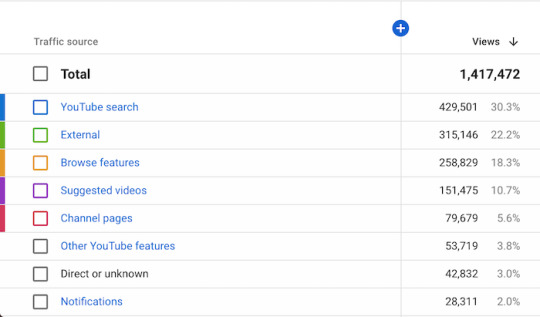
Over the last 28 days, I received 429,501 video views through YouTube SEO.
Lesson #16: Speed is everything
The faster your server and the more optimized your site, the more traffic you’ll get.
Years ago, my friend Otis added more servers to his site GoodReads.
Within a month, his SEO traffic went up over 20%.
Speed is part of Google’s algorithm, so optimize it for both web and mobile.
A quick way to see your site’s speed is to enter your URL here.
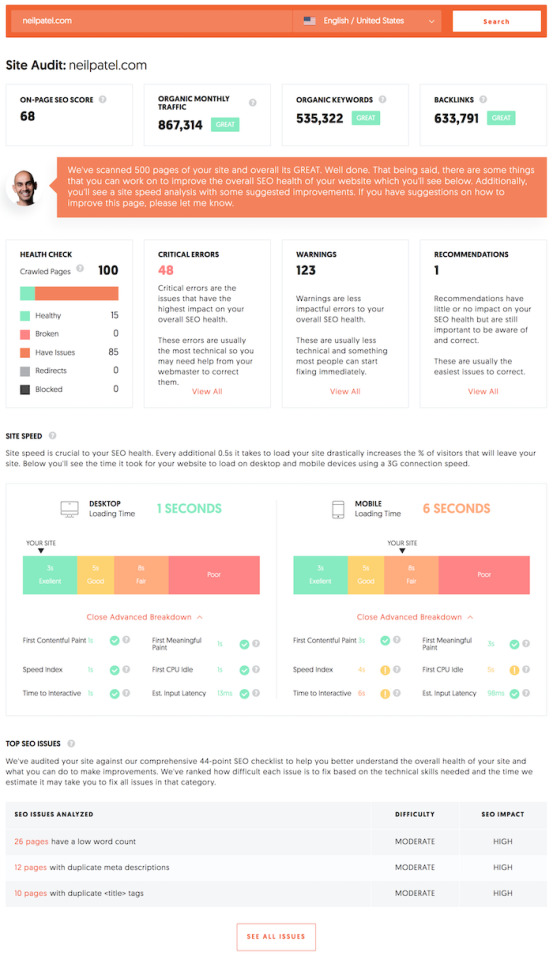
You’ll see a report that breaks down your mobile and desktop load times as well as what you can do to improve them.
Lesson #17: Quality over quantity
SEO used to be a game of quantity over quality.
That isn’t the case anymore. With over a billion blogs, Google has its fair share of sites to choose from.
Just look at About.com. Eventually they renamed it Dotdash and changed their strategy.

They took all of their About.com content and moved it over to 6 vertical based sites and deleted 900,000 pages of junk content.
This grew their traffic and revenue by a whopping 140%.
Focus on writing high-quality content. It’s why I blog less and try to make my content amazing.
Lesson #18: Tools are better than content marketing
I used to focus all of my energy on content marketing because it drove a lot of links and SEO traffic.
But over time, I realized that creating free tools builds more natural links than anything else I have ever tested.
Just look at Ubersuggest. I spent years creating it and look at how many links it has generated…
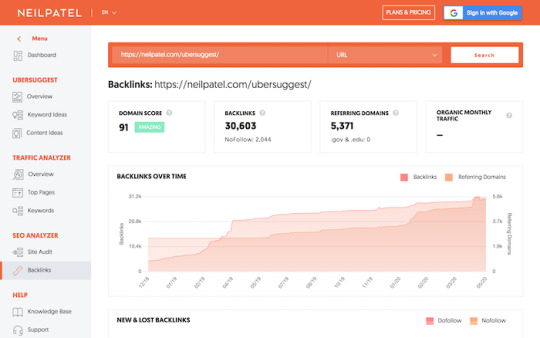
30,603 backlinks! That’s a lot of links.
If you don’t have the resources to build a custom tool like me, you can always start with buying a white label tool from Code Canyon for $10 or $20. They literally have tools for almost all industries.
Lesson #19: Don’t rely only on SEO
When I first got started in SEO, all I could think about was SEO.
To me, it was the best marketing channel out there because it allowed me to compete with large companies.
Even to this day, I still love SEO more than any other channel.
But it doesn’t stop me from leveraging other marketing channels.
See, years ago you could build a business off of one marketing channel.
Yelp was built through SEO. Dropbox through social media referrals. Facebook through email invites…
Those days don’t exist anymore. You can’t just build your traffic from one channel.
Although you should do SEO, you should also try paid ads, social media marketing, email marketing, push notifications, and anything else that comes out.
Diversify your traffic sources and don’t just rely solely on SEO.
Lesson #20: People love linking to data
Spending money and time to gather your own unique data is an easy way to build links.
Check out my posts on content marketing trends and social media trends.
I’ve added tons of unique data, stats, and charts to each of those posts.
The end result? Extra backlinks. 🙂
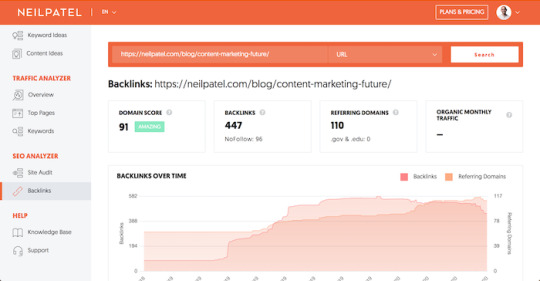
The content marketing trends post received 447 backlinks.
If you don’t have the time to gather custom data you can always find someone on Upwork to help you out.
Lesson #21: Don’t forget about Infographics
One of my favorite SEO strategies that still works well today is infographics.
I have tons of them on the NeilPatel.com blog.
I didn’t start off with infographics here… I used to do them on my old blog Quick Sprout and KISSmetrics.
Here’s an interesting stat for you when I used to crank out infographics on KISSmetrics.
Within a two-year period, from 2010 to 2012, 47 infographics generated 2,512,596 visitors and 41,142 backlinks from 3,741 unique domains. They also generated 41,359 tweets and 20,859 likes.
If you don’t have money to hire a designer, you can use Infogram or Canva to create one on your own.
Lesson #22: Google doesn’t penalize for duplicate content
You don’t want to post tons of duplicate content on your site as it’s not the best user experience, but keep in mind that Google doesn’t penalize you for duplication.
They may not just rank the duplicate content as well.
So, if you spend all of this time producing amazing, unique content, why not publish it FIRST on your own website.
Then after a few hours or days if you want to be safe, take that exact content and publish it on Facebook, LinkedIn, and anywhere else that will accept your content.
Literally, take all of the words and paste them onto those social channels.
It will get you extra awareness and branding. Plus, the content should already be indexed on your site, so Google knows it came from your first… and I doubt you care if the duplicated version on LinkedIn ranks. That’s still great branding.
In other words, don’t be afraid to repurpose your content even if it causes duplication.
Just look at this post, for example. I’m also repurposing it into a 4-part podcast series.
Lesson #23: Don’t recreate the wheel
I used to spend hours a week doing keyword research trying to figure out what new terms to rank for.
Eventually, I figured out an easier and better way to find new content topics and keywords to go after.
Go to Ubersuggest, type in your competitor’s domain name and hit search.
In the left-hand navigation click on Top Pages.
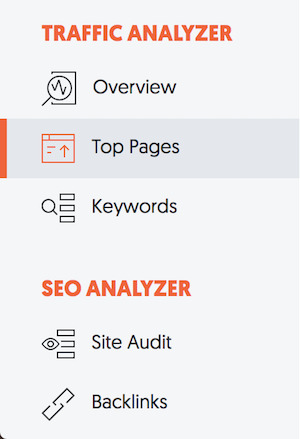
You’ll see a report that shows you all of the popular pages on your competition’s website. This will give you ideas for the type of pages you should create on your website.

Then I want you to click “View All” under Est. Visits (estimated visits). This will show you all of the keywords that drive traffic to that page.

You now have a list of topics and keywords for each topic to go after.
Lesson #24: Don’t pick a generic domain name
Remember how in Lesson 11 I talked about brand queries and how they helped rankings?
After I learned that, I decided to go buy exact match domain names where the domain name was the keyword.
That way I would get lots of brand queries without trying.
Well, there’s an issue… even if you rank high, what you’ll find is you will have a low click-through rate in most cases.
If you have a low click-through rate, it tells Google your brand isn’t strong and people don’t prefer it, which can hurt your ranking.
So instead of focusing on exact match domains, unless you have millions to spend on branding like Hotels.com, focus on building a memorable brand.
youtube
Pick something that is unique, easy to spell, and easy to remember.
Lesson #25: Learn from blackhat SEOs, but don’t go over to the dark side
Blackhat SEOs come up with some interesting data and experiments.
Many of them don’t work for long, but they are interesting none-the-less.
Although I don’t recommend practicing blackhat SEO, I do recommend following them.
The easiest way you can learn from them is by reading Blackhat World.
People there share some interesting insights, especially every time there is a major Google algorithm update.
Again, I don’t recommend practicing blackhat SEO, but following them may help you uncover “white hat” techniques that can increase your rankings. Not everything they do is bad… many of them use legitimate tactics as well.
Lesson #26: Short URLs rank better than long ones
My URLs used to be the title of my blog post.
For example, with this post I would have used this URL in the past…
Neilpatel.com/blog/30-lessons-after-30-million-seo-visitors/
Eventually I switched to short URLs.
Google just prefers them. And I’ve seen it firsthand. That’s why I use short ones now.
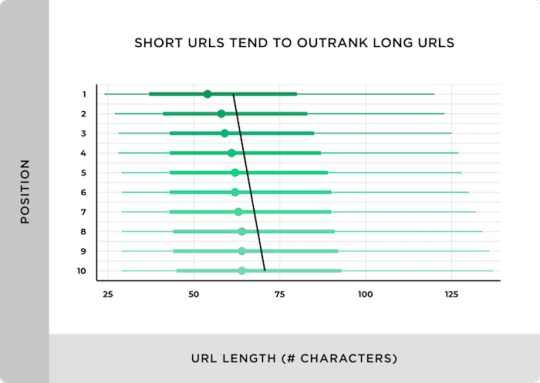
URLs at position #1 are on average 9.2 characters shorter than URLs that rank in position #10. So, keep them short.
Lesson #27: The power’s in the list
If you want your content to rank high on Google, you need more people to see it.
Whether it is from social shares, or from push notifications or email blasts… the more people that see your content, the more engagement it will get, and the more people that will link to it.
I used to do a ton of manual outreach every time I published a new blog post and I would email people asking them to link to me.
And it works, it’s just time consuming and a pain.
These days, I have a better strategy… send out an email blast every time I publish a new post.

I can now get anywhere from 20,000 to 50,000 clicks per email I send out.
Now of course you won’t get that from day one as it took me years to build up my email list.
But you can start today by collecting emails. You can easily do that through Hello Bar.
And as your list grows, so will the clicks to your blog and the number of links you get, which in turn will increase your rankings.
Lesson #28: Don’t let your foot off the peddle
This was one of the hardest lessons I learned.
It’s exhausting to continually blog and do your own SEO. Sometimes you just want a break.
With my old blog, Quick Sprout, I used to publish 12 blog posts a month and I did that consistently for 3 years.
One day I decided that I wanted to stop for a month. So, I took a 30-day break.
Guess what happened to my traffic?
It tanked by 32%.
So, then I started blogging again. And guessed what happened to my traffic after I started blogging?
It didn’t come right back.
It took me 3 months to get back to where I was.
When things are working for you, don’t slow down. Keep pushing harder, even if you are exhausted. Because the moment you stop, you’ll drop, and it is a lot of work to get back to where you were.
Lesson #29: The best SEO advice comes from conferences
The best SEO advice I have ever learned over the years has come from conferences.
And no, I don’t mean by sitting in on the sessions, although you can learn from those too.
The best SEO secrets and advice I learned came from networking. When you go to these conferences, hundreds if not thousands of other SEOs are there. And when you go to the bar after hours and mingle with people, you’ll quickly pick stuff up.
You’ll be shocked at what people tell you. It’s how I learned a lot of the good tactics that I still use today.
Lesson #30: Never stop learning
This one may sound obvious but when things are going well, people get complacent.
Google makes on average 3,234 updates per year and that count has been increasing over time.
Just think about that for a bit… that’s roughly 9 algorithm updates per day.
Because they are changing so quickly, you won’t survive if you don’t stay up to date.
Yes, the ideal strategy is to do what’s best for your users or visitors as in the long run, Google wants to promote those sites, but it doesn’t mean that you can ignore the changes happening in the industry.
Read all of the SEO blogs out there, attend conferences as I mentioned above… experiment on test sites… push yourself to be better.
That drive of always improving and always wanting to learn more has helped me tremendously. It’s one of the reasons for my growth in rankings over the years.
Conclusion
There are a lot of lessons that you will learn as your rankings grow and as you spend more time on SEO.
But hopefully, you don’t have to waste time and go through the same mistakes I made. You don’t want to learn these lessons the hard way.
That’s why I decided to share them. I want to save you the time and help you achieve your traffic goals faster.
Which SEO lessons have you learned?
The post 30 Lessons After 30 Million SEO Visitors appeared first on Neil Patel.
30 Lessons After 30 Million SEO Visitors Publicado primeiro em https://neilpatel.com
0 notes
Text
30 Lessons After 30 Million SEO Visitors
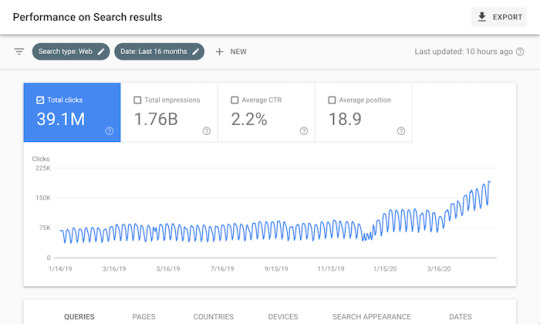
As you can see from the screenshot above, I’ve driven 30 million visitors to my website from SEO.
Technically it’s more, but who’s counting.
What’s funny, though, is I barely look at my traffic, even as Google continually rolls out algorithm updates.
I know that sounds contradictory because if you are an SEO, why wouldn’t you obsess about traffic, right?
Well, it’s because I’ve learned some hard lessons over the year… mainly because I’ve made a lot of mistakes.
So today, I wanted to share them with you so that you can learn from my mistakes… so here goes:
Lesson #1: Don’t obsess over rankings, obsess over conversions
I used to check my rankings every single day. Literally.
On top of that, I would log into Google Analytics 4 to 5 times a day and continually check my traffic.
That’s all I cared about back in the day… boosting my organic traffic.
But here is the thing: As my rankings and traffic went up over the years, my revenue didn’t go up proportionally.
For example, during one quarter in 2017, my SEO traffic went up 39.52%, but my revenue from SEO went up only 4.29%.
I quickly learned that traffic isn’t everything. If you can’t convert the traffic into revenue it doesn’t matter.
That taught me that you need to focus on the right keywords that drive conversions and continually optimize your site for conversions.
An easy first step for you to take is to install Crazy Egg and run a heatmap to see where people click so you adjust your design and copy to get more sales.

Lesson #2: The easiest way to grow your SEO traffic is international expansion
You already know that I get a lot of SEO traffic, but do you know what country drives most of my traffic?
If you guessed United States, you are wrong.
Brazil is my most popular region, followed by India.
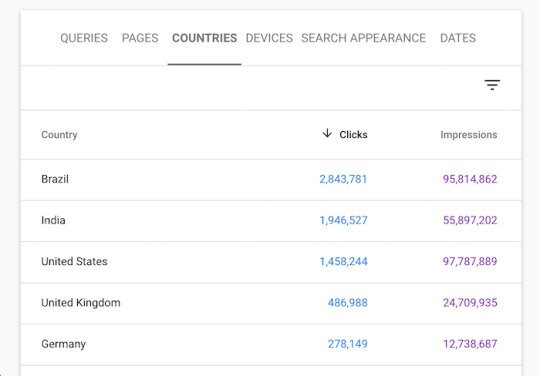
International SEO is the easiest way to expand and grow your traffic. Here are a few posts that you should read before you expand your SEO globally:
How to create a global SEO strategy
Fundamentals of international SEO
How to correctly setup your site for international SEO
How to profitably expand your SEO globally
Lesson #3: Keywords are very, very, very, very important
When I used to write my content, I didn’t obsess about the keywords when I should have.
My team actually proved me wrong on this.
I used to focus on writing content for humans and didn’t worry about search engines. My team, on the other hand, obsesses about keywords.
Just look at the growth of our traffic in Brazil because of our obsession with the right keywords.
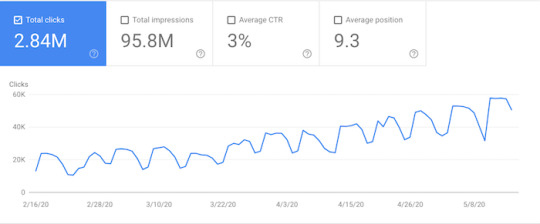
One simple thing I do before writing that has really helped is I head over to Ubersuggest and type in a few of the keywords that I want to go after.
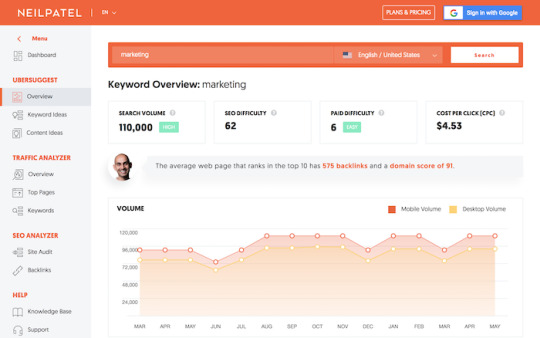
Once it loads, you’ll see a report like the one above. I want you to then click on “Keyword Ideas” in the left-hand navigation.
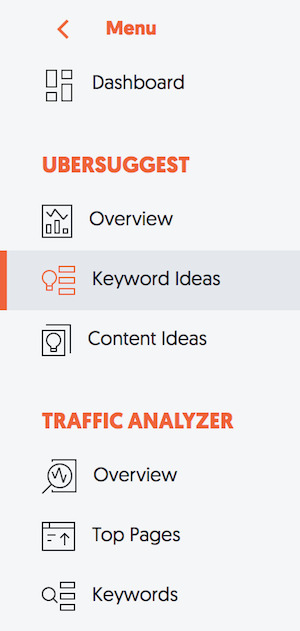
You’ll see a report that contains a list of keywords that you could potentially be targeting.
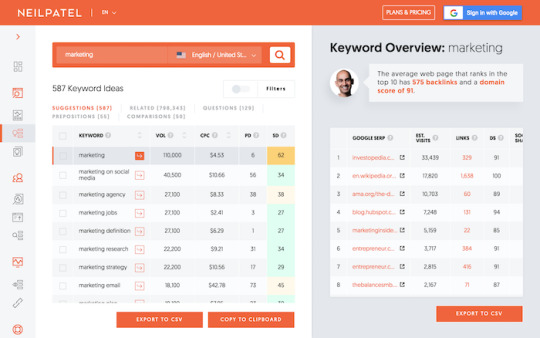
Make sure you click on the “Related” tab, as well as “Questions” and “Comparisons” … scroll through the list. You’ll see hundreds of keywords. Pick all of the ones that are relevant and ideally have a high cost per click (CPC). These are the keywords that’ll not only drive traffic but revenue as well.
Whenever I write a blog post, I go through this step. Every single time.
Lesson #4: AMP pages can drive more SEO traffic
AMP pages load faster on mobile devices than non-AMP pages.
If you aren’t familiar with the AMP framework, read this.
What most people won’t tell you about AMP pages is that:
In regions like the United States, Canada, and the United Kingdom, countries with decent Internet infrastructure, you won’t see much of an increase in traffic.
In regions with poor Internet infrastructure, like Brazil, you’ll see a 10 to 15% lift in mobile SEO traffic by having AMP pages.
AMP pages don’t convert visitors into customers as well as normal responsive web design. So, you’ll have to work on testing your AMP pages so you can boost your conversion rates.
Lesson #5: SEO will never convert as well as paid ads
When I started off with SEO, I would run projections on how much the traffic would make me.
But the numbers were always off, even if I was able to get the rankings.
Here’s the main reason: If you are bidding on terms like auto insurance through ads, you can drive people to a landing page that looks like this:
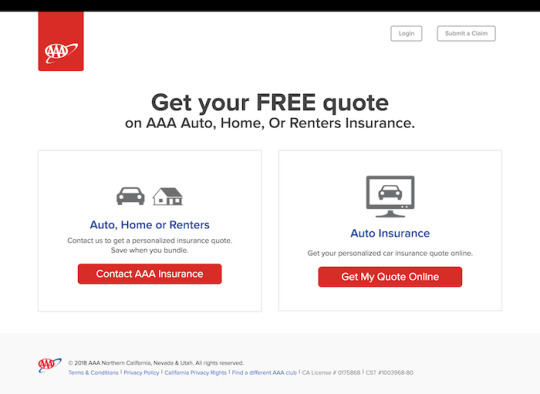
But if you want to rank organically, you’ll have to do it through content. So, your page that ranks well will look more like this and convert less…
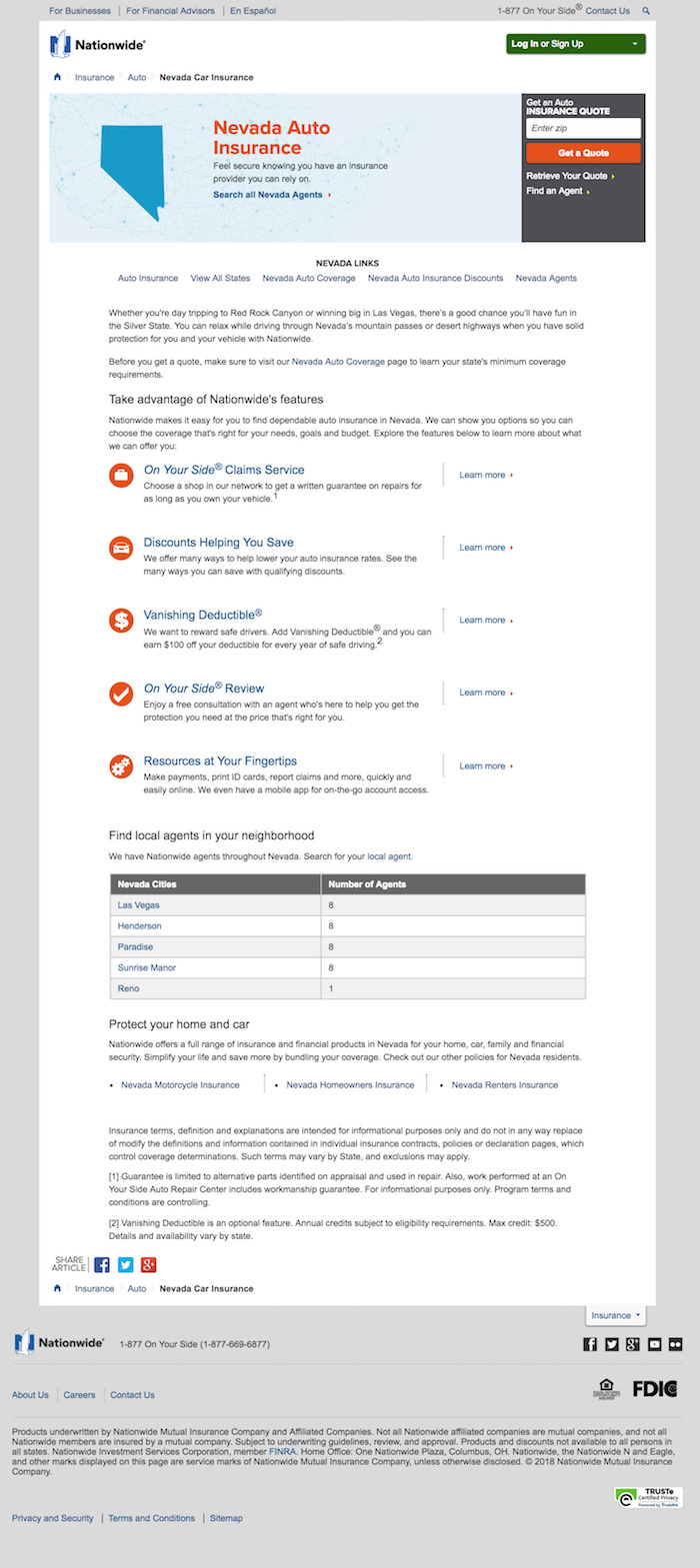
It doesn’t mean SEO is bad. In reality, it’s much cheaper in the long run than paid ads and will produce a better ROI. But don’t just assume that if you get 100 visitors from paid ads and 3 purchases that you’ll have the same conversion rate with your SEO traffic.
Chances are it will be significantly lower by maybe 2 or 3x, but because SEO is cheaper, it will be much more profitable.
Lesson #6: Remarketing is one of the best ways to generate an ROI from SEO
If you get a ton of traffic from SEO, there is a simple strategy you can implement to boost your conversions.
Remarket everyone on Facebook, Google, and YouTube.
That way people come to your site, read your content, and build trust with you and your brand.
Then you remarket them throughout the web with ads that prompt your products or services and send them to a landing page that will drive sales.
I’ve been doing this for years, just look at my old remarketing ad…

For the regions I use remarketing in, it is responsible for 46% of my leads.
Lesson #7: Don’t forget to update your old content
I publish one new blog post a week. I’m working on increasing this as I get more time, but for now, it is one a week.
Can you guess how many blog posts I update on a daily basis? Technically it is 0 (me at least), but my team focuses on updating at least 3 old blog posts per day. That’s roughly 90 a month.
Once you have a few hundred pages, make sure you focus on updating your old content or else your traffic will quickly drop.
You can use this content decay tool to see which posts you should update first.
This will help you continually grow your SEO traffic instead of hitting plateaus or seeing your traffic take massive drops.
Lesson #8: Don’t forget to optimize your title tags
One of the easiest ways to grow your rankings is to optimize your title tags.
If you can write persuasive copy and get more clicks, you’ll quickly move up on Google.
In Brazil, we spend more time doing this than we do in the United States.

We get a similar amount of impressions in Brazil, but we have more people focusing on improving our title tags and testing. Hence, we get 95% more SEO traffic in Brazil.
If you want tips on boosting your clicks, check out this article.
Another simple hack is to use the “Content Ideas” report in Ubersuggest.

On the right side of that report, you can see social share counts from Facebook and Pinterest. And on the left side, you see titles of articles.
Typically, if people like a title they share it more. So, look for titles that have a lot of shares as it will give you ideas on what you can use on your website to get more clicks and boost your rankings.
Lesson #9: Don’t put dates in your URL
I used to put dates in my URLs like:
Neilpatel.com/2017/12/title-of-post/
This causes search engines to assume that your content is related to a specific date. And after that date gets old, search engines assume your content is irrelevant and outdated.
The moment I removed the date from my URLs, I grew my SEO traffic by 58% in 30 days.
If you have dates in your URL, make sure you 301 redirect your old URLs to your new ones once you make that change, or else your rankings will drop.
Lesson #10: Don’t be afraid to use popups
Don’t you hate popups? Well, who doesn’t?
But people use them because they work.
The majority of your pages that will rank are blog-related content. And blog posts tend to drive fewer direct conversions because people are on your site to read the content.
In order to maximize your conversions from SEO, you should consider using exit popups so you can convert more of those visitors into customers as they leave.
When you leave this site in most cases, you’ll see a popup that looks like:
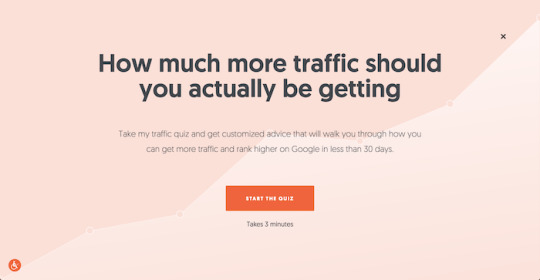
And it drives you to this quiz, which allows me to convert SEO visitors into customers.
You can easily copy me by using Hello Bar. It works for all industries including B2B and ecommerce and even lead generation sites.
Lesson #11: Brand queries affect rankings
Everyone talks about how you need links to boost rankings.
But very few people talk about brand queries.
As Google’s ex-CEO and ex-head of web spam both emphasized how brands are important.

One of the big reasons for my growth in SEO traffic is the growth in my brand. I’ve seen a direct correlation in which the more people who find me from my name, the more SEO traffic I get.
Just look at my brand growth over time:
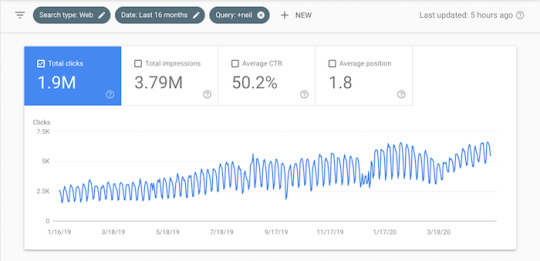
I’ve received over 1.9 million visitors over the last 16 months from people typing in variations of my name in Google.
Lesson #12: Don’t waste your money on paid links
I’ve been doing SEO since I was 16 years old. That’s a long time…
When I started off as a kid, I dabbled in paid links and I used to dominate Google for terms like online casino, online poker, web hosting, auto insurance, and even credit cards.
And I was making a killing off of affiliate income from these sites.
But it was all short lived.
Why?
Because I bought links. And eventually Google penalized all of those sites.
If I never purchased links, those sites would have taken longer to rank, but they would have been around today, and I would have generated more income overall.
Don’t buy links, it’s bad and shortsighted.
Lesson #13: Guest post to build a brand, not to build links
I already covered the importance of branding above.
A great way to build your brand and indirectly boost your SEO traffic is through guest posting.
But don’t use guest posting to build links.
Most sites that offer guest posts, nofollow them (which they should), and Google is smart enough to know what a guest post is, hence they ignore guest post links from sites like Forbes.
It’s pretty easy to spot a guest post for both a human and algorithm…
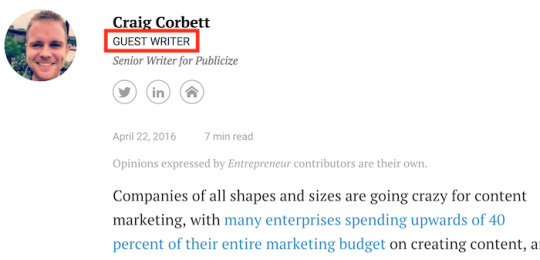
But if you are using it to build a brand, great. Focus on the content quality and not links.
Lesson #14: Don’t forget to interlink
Do you know what some of my highest ranked pages are?
The ones that are interlinked.
It takes anywhere from 6 months to a year for many of the interlinks to kick in, but it is still effective none-the-less.
Every time I wrote content, I used to make sure I link out to my older pieces of content when it made sense. But I made a big mistake… I wasn’t going into my older pieces of content and then adding links to my newer pieces of content.
That one change was game-changing for me. It took time to see the results but it worked exceptionally well.
It’s how I rank high for terms like “email marketing”.
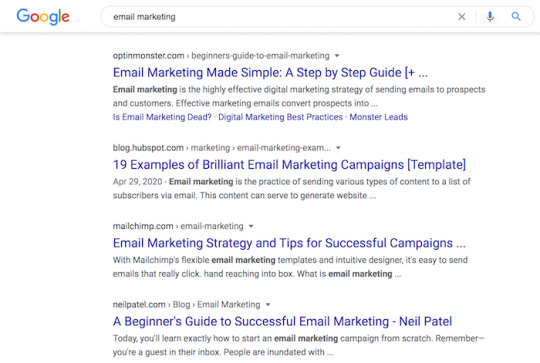
Lesson #15: Google isn’t the only game in town
Although Google is the most popular search engine, it isn’t the only one you need to focus on.
Did you know that YouTube is the second most popular search engine?
Even Bing gets a lot of traffic.
If you want to rank high on Bing, follow this.
Or if you prefer video, watch this:
As for YouTube, this guide will teach you YouTube SEO. It works really well, just look at my YouTube SEO traffic:
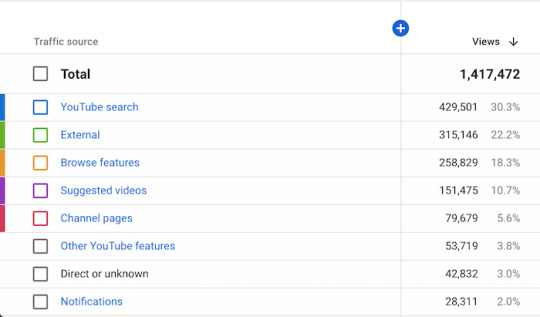
Over the last 28 days, I received 429,501 video views through YouTube SEO.
Lesson #16: Speed is everything
The faster your server and the more optimized your site, the more traffic you’ll get.
Years ago, my friend Otis added more servers to his site GoodReads.
Within a month, his SEO traffic went up over 20%.
Speed is part of Google’s algorithm, so optimize it for both web and mobile.
A quick way to see your site’s speed is to enter your URL here.
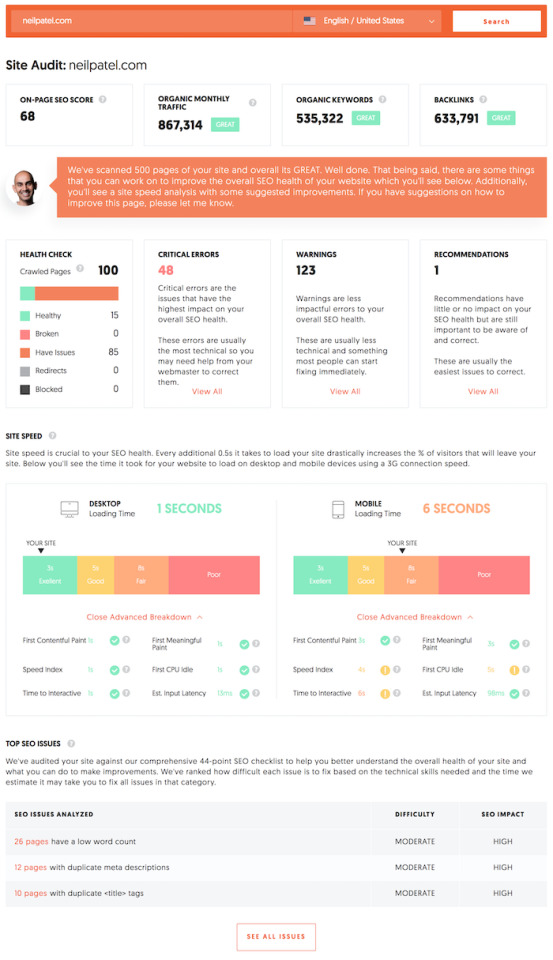
You’ll see a report that breaks down your mobile and desktop load times as well as what you can do to improve them.
Lesson #17: Quality over quantity
SEO used to be a game of quantity over quality.
That isn’t the case anymore. With over a billion blogs, Google has its fair share of sites to choose from.
Just look at About.com. Eventually they renamed it Dotdash and changed their strategy.
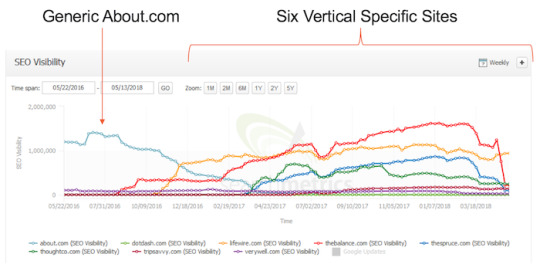
They took all of their About.com content and moved it over to 6 vertical based sites and deleted 900,000 pages of junk content.
This grew their traffic and revenue by a whopping 140%.
Focus on writing high-quality content. It’s why I blog less and try to make my content amazing.
Lesson #18: Tools are better than content marketing
I used to focus all of my energy on content marketing because it drove a lot of links and SEO traffic.
But over time, I realized that creating free tools builds more natural links than anything else I have ever tested.
Just look at Ubersuggest. I spent years creating it and look at how many links it has generated…
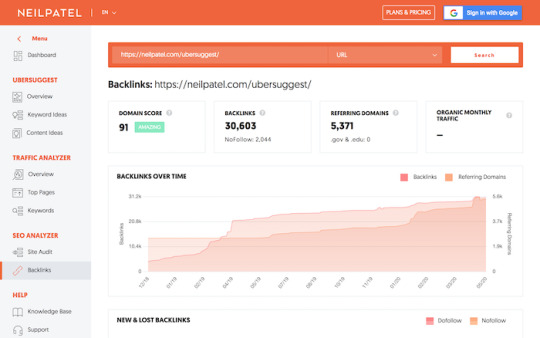
30,603 backlinks! That’s a lot of links.
If you don’t have the resources to build a custom tool like me, you can always start with buying a white label tool from Code Canyon for $10 or $20. They literally have tools for almost all industries.
Lesson #19: Don’t rely only on SEO
When I first got started in SEO, all I could think about was SEO.
To me, it was the best marketing channel out there because it allowed me to compete with large companies.
Even to this day, I still love SEO more than any other channel.
But it doesn’t stop me from leveraging other marketing channels.
See, years ago you could build a business off of one marketing channel.
Yelp was built through SEO. Dropbox through social media referrals. Facebook through email invites…
Those days don’t exist anymore. You can’t just build your traffic from one channel.
Although you should do SEO, you should also try paid ads, social media marketing, email marketing, push notifications, and anything else that comes out.
Diversify your traffic sources and don’t just rely solely on SEO.
Lesson #20: People love linking to data
Spending money and time to gather your own unique data is an easy way to build links.
Check out my posts on content marketing trends and social media trends.
I’ve added tons of unique data, stats, and charts to each of those posts.
The end result? Extra backlinks. ?

The content marketing trends post received 447 backlinks.
If you don’t have the time to gather custom data you can always find someone on Upwork to help you out.
Lesson #21: Don’t forget about Infographics
One of my favorite SEO strategies that still works well today is infographics.
I have tons of them on the NeilPatel.com blog.
I didn’t start off with infographics here… I used to do them on my old blog Quick Sprout and KISSmetrics.
Here’s an interesting stat for you when I used to crank out infographics on KISSmetrics.
Within a two-year period, from 2010 to 2012, 47 infographics generated 2,512,596 visitors and 41,142 backlinks from 3,741 unique domains. They also generated 41,359 tweets and 20,859 likes.
If you don’t have money to hire a designer, you can use Infogram or Canva to create one on your own.
Lesson #22: Google doesn’t penalize for duplicate content
You don’t want to post tons of duplicate content on your site as it’s not the best user experience, but keep in mind that Google doesn’t penalize you for duplication.
They may not just rank the duplicate content as well.
So, if you spend all of this time producing amazing, unique content, why not publish it FIRST on your own website.
Then after a few hours or days if you want to be safe, take that exact content and publish it on Facebook, LinkedIn, and anywhere else that will accept your content.
Literally, take all of the words and paste them onto those social channels.
It will get you extra awareness and branding. Plus, the content should already be indexed on your site, so Google knows it came from your first… and I doubt you care if the duplicated version on LinkedIn ranks. That’s still great branding.
In other words, don’t be afraid to repurpose your content even if it causes duplication.
Just look at this post, for example. I’m also repurposing it into a 4-part podcast series.
Lesson #23: Don’t recreate the wheel
I used to spend hours a week doing keyword research trying to figure out what new terms to rank for.
Eventually, I figured out an easier and better way to find new content topics and keywords to go after.
Go to Ubersuggest, type in your competitor’s domain name and hit search.
In the left-hand navigation click on Top Pages.
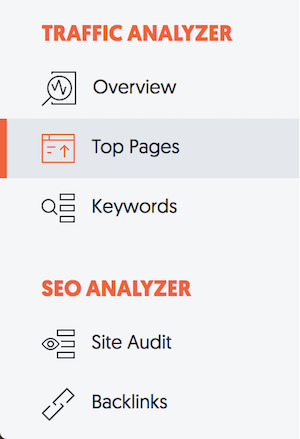
You’ll see a report that shows you all of the popular pages on your competition’s website. This will give you ideas for the type of pages you should create on your website.

Then I want you to click “View All” under Est. Visits (estimated visits). This will show you all of the keywords that drive traffic to that page.
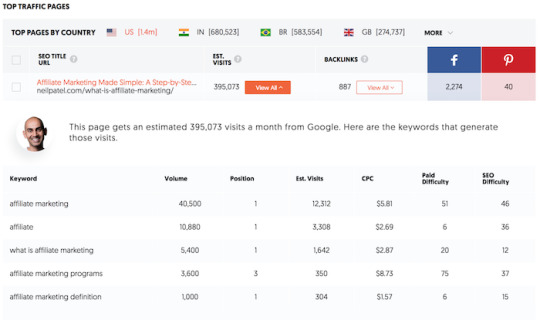
You now have a list of topics and keywords for each topic to go after.
Lesson #24: Don’t pick a generic domain name
Remember how in Lesson 11 I talked about brand queries and how they helped rankings?
After I learned that, I decided to go buy exact match domain names where the domain name was the keyword.
That way I would get lots of brand queries without trying.
Well, there’s an issue… even if you rank high, what you’ll find is you will have a low click-through rate in most cases.
If you have a low click-through rate, it tells Google your brand isn’t strong and people don’t prefer it, which can hurt your ranking.
So instead of focusing on exact match domains, unless you have millions to spend on branding like Hotels.com, focus on building a memorable brand.
Pick something that is unique, easy to spell, and easy to remember.
Lesson #25: Learn from blackhat SEOs, but don’t go over to the dark side
Blackhat SEOs come up with some interesting data and experiments.
Many of them don’t work for long, but they are interesting none-the-less.
Although I don’t recommend practicing blackhat SEO, I do recommend following them.
The easiest way you can learn from them is by reading Blackhat World.
People there share some interesting insights, especially every time there is a major Google algorithm update.
Again, I don’t recommend practicing blackhat SEO, but following them may help you uncover “white hat” techniques that can increase your rankings. Not everything they do is bad… many of them use legitimate tactics as well.
Lesson #26: Short URLs rank better than long ones
My URLs used to be the title of my blog post.
For example, with this post I would have used this URL in the past…
Neilpatel.com/blog/30-lessons-after-30-million-seo-visitors/
Eventually I switched to short URLs.
Google just prefers them. And I’ve seen it firsthand. That’s why I use short ones now.
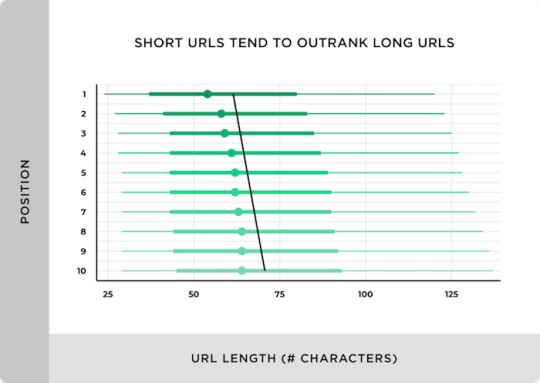
URLs at position #1 are on average 9.2 characters shorter than URLs that rank in position #10. So, keep them short.
Lesson #27: The power’s in the list
If you want your content to rank high on Google, you need more people to see it.
Whether it is from social shares, or from push notifications or email blasts… the more people that see your content, the more engagement it will get, and the more people that will link to it.
I used to do a ton of manual outreach every time I published a new blog post and I would email people asking them to link to me.
And it works, it’s just time consuming and a pain.
These days, I have a better strategy… send out an email blast every time I publish a new post.

I can now get anywhere from 20,000 to 50,000 clicks per email I send out.
Now of course you won’t get that from day one as it took me years to build up my email list.
But you can start today by collecting emails. You can easily do that through Hello Bar.
And as your list grows, so will the clicks to your blog and the number of links you get, which in turn will increase your rankings.
Lesson #28: Don’t let your foot off the peddle
This was one of the hardest lessons I learned.
It’s exhausting to continually blog and do your own SEO. Sometimes you just want a break.
With my old blog, Quick Sprout, I used to publish 12 blog posts a month and I did that consistently for 3 years.
One day I decided that I wanted to stop for a month. So, I took a 30-day break.
Guess what happened to my traffic?
It tanked by 32%.
So, then I started blogging again. And guessed what happened to my traffic after I started blogging?
It didn’t come right back.
It took me 3 months to get back to where I was.
When things are working for you, don’t slow down. Keep pushing harder, even if you are exhausted. Because the moment you stop, you’ll drop, and it is a lot of work to get back to where you were.
Lesson #29: The best SEO advice comes from conferences
The best SEO advice I have ever learned over the years has come from conferences.
And no, I don’t mean by sitting in on the sessions, although you can learn from those too.
The best SEO secrets and advice I learned came from networking. When you go to these conferences, hundreds if not thousands of other SEOs are there. And when you go to the bar after hours and mingle with people, you’ll quickly pick stuff up.
You’ll be shocked at what people tell you. It’s how I learned a lot of the good tactics that I still use today.
Lesson #30: Never stop learning
This one may sound obvious but when things are going well, people get complacent.
Google makes on average 3,234 updates per year and that count has been increasing over time.
Just think about that for a bit… that’s roughly 9 algorithm updates per day.
Because they are changing so quickly, you won’t survive if you don’t stay up to date.
Yes, the ideal strategy is to do what’s best for your users or visitors as in the long run, Google wants to promote those sites, but it doesn’t mean that you can ignore the changes happening in the industry.
Read all of the SEO blogs out there, attend conferences as I mentioned above… experiment on test sites… push yourself to be better.
That drive of always improving and always wanting to learn more has helped me tremendously. It’s one of the reasons for my growth in rankings over the years.
Conclusion
There are a lot of lessons that you will learn as your rankings grow and as you spend more time on SEO.
But hopefully, you don’t have to waste time and go through the same mistakes I made. You don’t want to learn these lessons the hard way.
That’s why I decided to share them. I want to save you the time and help you achieve your traffic goals faster.
Which SEO lessons have you learned?
The post 30 Lessons After 30 Million SEO Visitors appeared first on Neil Patel.
Original content source: https://neilpatel.com/blog/seo-visitors/ via https://neilpatel.com
See the original post, 30 Lessons After 30 Million SEO Visitors that is shared from https://imtrainingparadise.weebly.com/home/30-lessons-after-30-million-seo-visitors via https://imtrainingparadise.weebly.com/home
0 notes
Text
30 Lessons After 30 Million SEO Visitors
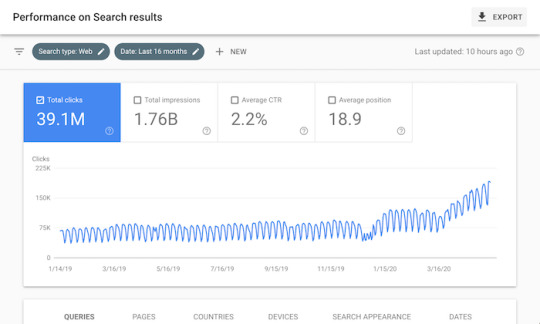
As you can see from the screenshot above, I’ve driven 30 million visitors to my website from SEO.
Technically it’s more, but who’s counting.
What’s funny, though, is I barely look at my traffic, even as Google continually rolls out algorithm updates.
I know that sounds contradictory because if you are an SEO, why wouldn’t you obsess about traffic, right?
Well, it’s because I’ve learned some hard lessons over the year… mainly because I’ve made a lot of mistakes.
So today, I wanted to share them with you so that you can learn from my mistakes… so here goes:
Lesson #1: Don’t obsess over rankings, obsess over conversions
I used to check my rankings every single day. Literally.
On top of that, I would log into Google Analytics 4 to 5 times a day and continually check my traffic.
That’s all I cared about back in the day… boosting my organic traffic.
But here is the thing: As my rankings and traffic went up over the years, my revenue didn’t go up proportionally.
For example, during one quarter in 2017, my SEO traffic went up 39.52%, but my revenue from SEO went up only 4.29%.
I quickly learned that traffic isn’t everything. If you can’t convert the traffic into revenue it doesn’t matter.
That taught me that you need to focus on the right keywords that drive conversions and continually optimize your site for conversions.
An easy first step for you to take is to install Crazy Egg and run a heatmap to see where people click so you adjust your design and copy to get more sales.

Lesson #2: The easiest way to grow your SEO traffic is international expansion
You already know that I get a lot of SEO traffic, but do you know what country drives most of my traffic?
If you guessed United States, you are wrong.
Brazil is my most popular region, followed by India.

International SEO is the easiest way to expand and grow your traffic. Here are a few posts that you should read before you expand your SEO globally:
How to create a global SEO strategy
Fundamentals of international SEO
How to correctly setup your site for international SEO
How to profitably expand your SEO globally
Lesson #3: Keywords are very, very, very, very important
When I used to write my content, I didn’t obsess about the keywords when I should have.
My team actually proved me wrong on this.
I used to focus on writing content for humans and didn’t worry about search engines. My team, on the other hand, obsesses about keywords.
Just look at the growth of our traffic in Brazil because of our obsession with the right keywords.
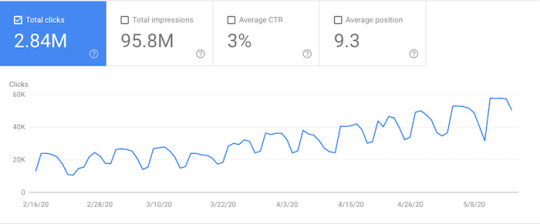
One simple thing I do before writing that has really helped is I head over to Ubersuggest and type in a few of the keywords that I want to go after.
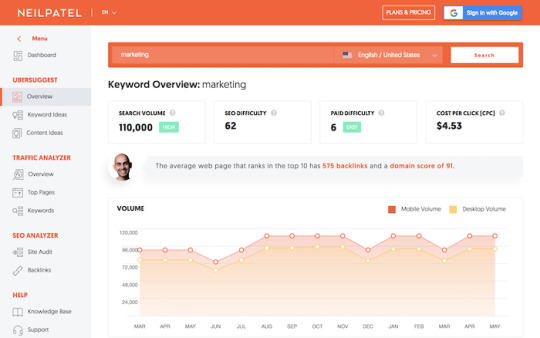
Once it loads, you’ll see a report like the one above. I want you to then click on “Keyword Ideas” in the left-hand navigation.

You’ll see a report that contains a list of keywords that you could potentially be targeting.
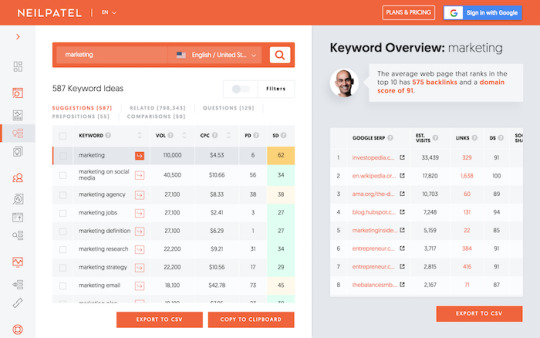
Make sure you click on the “Related” tab, as well as “Questions” and “Comparisons” … scroll through the list. You’ll see hundreds of keywords. Pick all of the ones that are relevant and ideally have a high cost per click (CPC). These are the keywords that’ll not only drive traffic but revenue as well.
Whenever I write a blog post, I go through this step. Every single time.
Lesson #4: AMP pages can drive more SEO traffic
AMP pages load faster on mobile devices than non-AMP pages.
If you aren’t familiar with the AMP framework, read this.
What most people won’t tell you about AMP pages is that:
In regions like the United States, Canada, and the United Kingdom, countries with decent Internet infrastructure, you won’t see much of an increase in traffic.
In regions with poor Internet infrastructure, like Brazil, you’ll see a 10 to 15% lift in mobile SEO traffic by having AMP pages.
AMP pages don’t convert visitors into customers as well as normal responsive web design. So, you’ll have to work on testing your AMP pages so you can boost your conversion rates.
Lesson #5: SEO will never convert as well as paid ads
When I started off with SEO, I would run projections on how much the traffic would make me.
But the numbers were always off, even if I was able to get the rankings.
Here’s the main reason: If you are bidding on terms like auto insurance through ads, you can drive people to a landing page that looks like this:
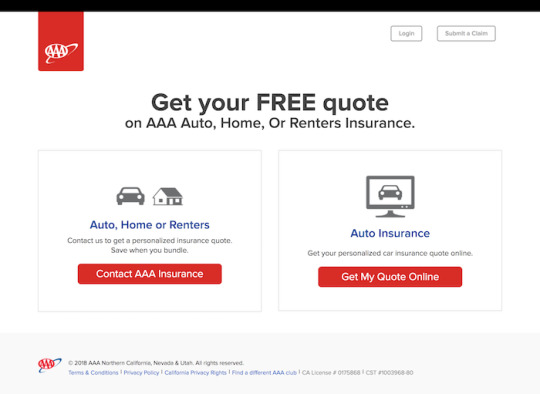
But if you want to rank organically, you’ll have to do it through content. So, your page that ranks well will look more like this and convert less…
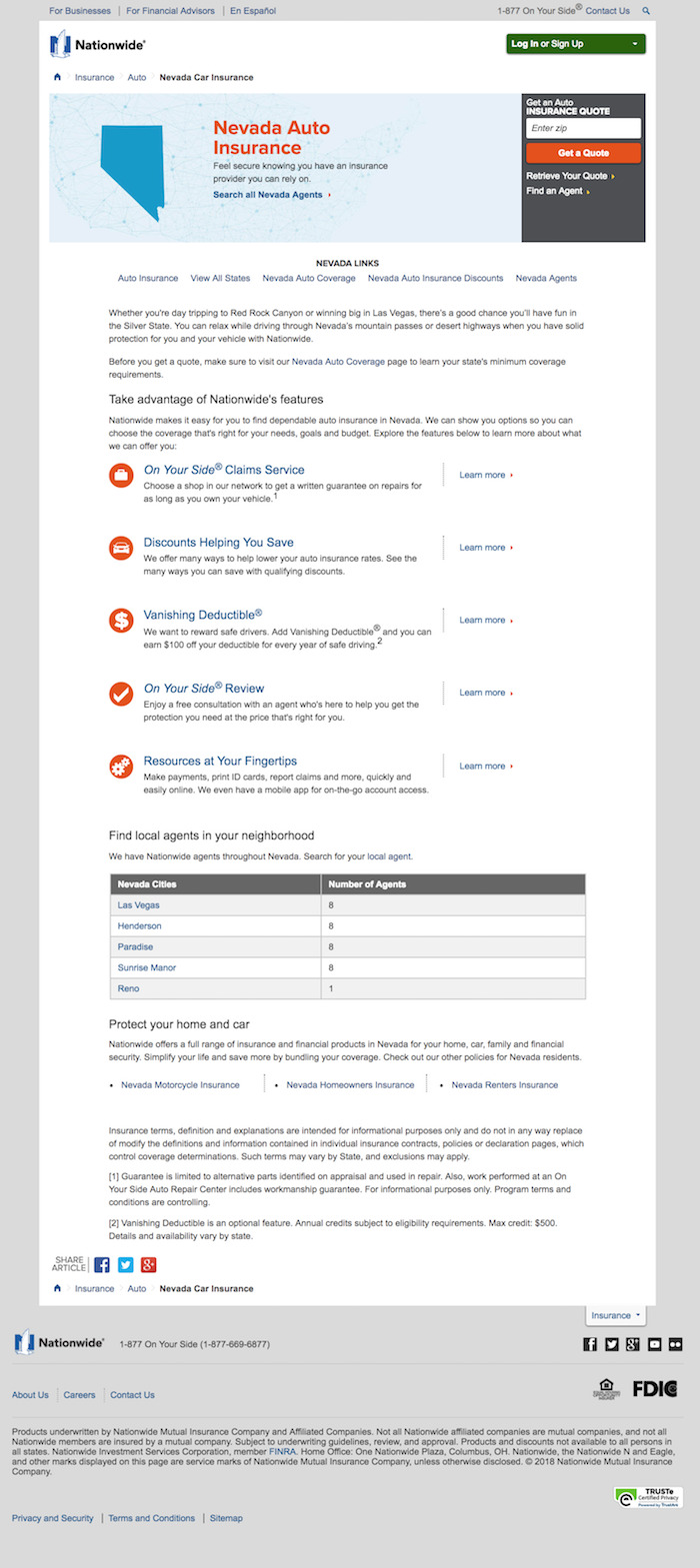
It doesn’t mean SEO is bad. In reality, it’s much cheaper in the long run than paid ads and will produce a better ROI. But don’t just assume that if you get 100 visitors from paid ads and 3 purchases that you’ll have the same conversion rate with your SEO traffic.
Chances are it will be significantly lower by maybe 2 or 3x, but because SEO is cheaper, it will be much more profitable.
Lesson #6: Remarketing is one of the best ways to generate an ROI from SEO
If you get a ton of traffic from SEO, there is a simple strategy you can implement to boost your conversions.
Remarket everyone on Facebook, Google, and YouTube.
That way people come to your site, read your content, and build trust with you and your brand.
Then you remarket them throughout the web with ads that prompt your products or services and send them to a landing page that will drive sales.
I’ve been doing this for years, just look at my old remarketing ad…

For the regions I use remarketing in, it is responsible for 46% of my leads.
Lesson #7: Don’t forget to update your old content
I publish one new blog post a week. I’m working on increasing this as I get more time, but for now, it is one a week.
Can you guess how many blog posts I update on a daily basis? Technically it is 0 (me at least), but my team focuses on updating at least 3 old blog posts per day. That’s roughly 90 a month.
Once you have a few hundred pages, make sure you focus on updating your old content or else your traffic will quickly drop.
You can use this content decay tool to see which posts you should update first.
This will help you continually grow your SEO traffic instead of hitting plateaus or seeing your traffic take massive drops.
Lesson #8: Don’t forget to optimize your title tags
One of the easiest ways to grow your rankings is to optimize your title tags.
If you can write persuasive copy and get more clicks, you’ll quickly move up on Google.
In Brazil, we spend more time doing this than we do in the United States.
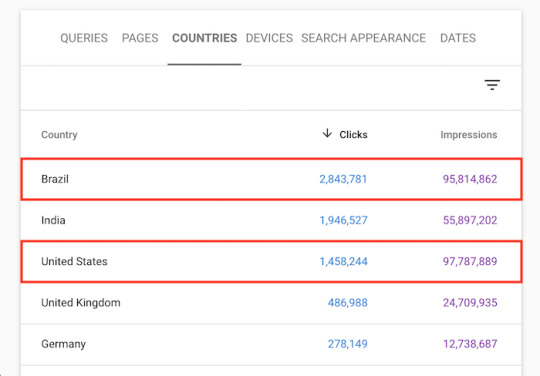
We get a similar amount of impressions in Brazil, but we have more people focusing on improving our title tags and testing. Hence, we get 95% more SEO traffic in Brazil.
If you want tips on boosting your clicks, check out this article.
Another simple hack is to use the “Content Ideas” report in Ubersuggest.
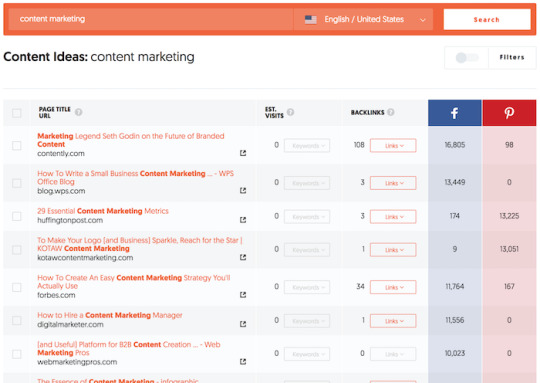
On the right side of that report, you can see social share counts from Facebook and Pinterest. And on the left side, you see titles of articles.
Typically, if people like a title they share it more. So, look for titles that have a lot of shares as it will give you ideas on what you can use on your website to get more clicks and boost your rankings.
Lesson #9: Don’t put dates in your URL
I used to put dates in my URLs like:
Neilpatel.com/2017/12/title-of-post/
This causes search engines to assume that your content is related to a specific date. And after that date gets old, search engines assume your content is irrelevant and outdated.
The moment I removed the date from my URLs, I grew my SEO traffic by 58% in 30 days.
youtube
If you have dates in your URL, make sure you 301 redirect your old URLs to your new ones once you make that change, or else your rankings will drop.
Lesson #10: Don’t be afraid to use popups
Don’t you hate popups? Well, who doesn’t?
But people use them because they work.
The majority of your pages that will rank are blog-related content. And blog posts tend to drive fewer direct conversions because people are on your site to read the content.
In order to maximize your conversions from SEO, you should consider using exit popups so you can convert more of those visitors into customers as they leave.
When you leave this site in most cases, you’ll see a popup that looks like:
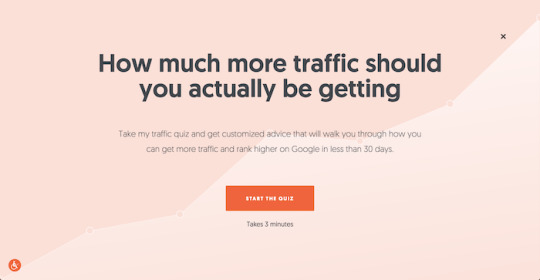
And it drives you to this quiz, which allows me to convert SEO visitors into customers.
You can easily copy me by using Hello Bar. It works for all industries including B2B and ecommerce and even lead generation sites.
Lesson #11: Brand queries affect rankings
Everyone talks about how you need links to boost rankings.
But very few people talk about brand queries.
As Google’s ex-CEO and ex-head of web spam both emphasized how brands are important.

One of the big reasons for my growth in SEO traffic is the growth in my brand. I’ve seen a direct correlation in which the more people who find me from my name, the more SEO traffic I get.
Just look at my brand growth over time:
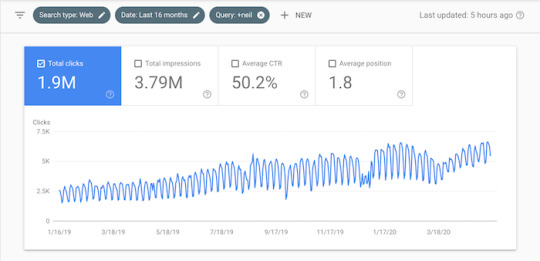
I’ve received over 1.9 million visitors over the last 16 months from people typing in variations of my name in Google.
Lesson #12: Don’t waste your money on paid links
I’ve been doing SEO since I was 16 years old. That’s a long time…
When I started off as a kid, I dabbled in paid links and I used to dominate Google for terms like online casino, online poker, web hosting, auto insurance, and even credit cards.
And I was making a killing off of affiliate income from these sites.
But it was all short lived.
Why?
Because I bought links. And eventually Google penalized all of those sites.
If I never purchased links, those sites would have taken longer to rank, but they would have been around today, and I would have generated more income overall.
Don’t buy links, it’s bad and shortsighted.
Lesson #13: Guest post to build a brand, not to build links
I already covered the importance of branding above.
A great way to build your brand and indirectly boost your SEO traffic is through guest posting.
But don’t use guest posting to build links.
Most sites that offer guest posts, nofollow them (which they should), and Google is smart enough to know what a guest post is, hence they ignore guest post links from sites like Forbes.
It’s pretty easy to spot a guest post for both a human and algorithm…

But if you are using it to build a brand, great. Focus on the content quality and not links.
Lesson #14: Don’t forget to interlink
Do you know what some of my highest ranked pages are?
The ones that are interlinked.
It takes anywhere from 6 months to a year for many of the interlinks to kick in, but it is still effective none-the-less.
Every time I wrote content, I used to make sure I link out to my older pieces of content when it made sense. But I made a big mistake… I wasn’t going into my older pieces of content and then adding links to my newer pieces of content.
That one change was game-changing for me. It took time to see the results but it worked exceptionally well.
It’s how I rank high for terms like “email marketing”.

Lesson #15: Google isn’t the only game in town
Although Google is the most popular search engine, it isn’t the only one you need to focus on.
Did you know that YouTube is the second most popular search engine?
Even Bing gets a lot of traffic.
If you want to rank high on Bing, follow this.
Or if you prefer video, watch this:
youtube
As for YouTube, this guide will teach you YouTube SEO. It works really well, just look at my YouTube SEO traffic:

Over the last 28 days, I received 429,501 video views through YouTube SEO.
Lesson #16: Speed is everything
The faster your server and the more optimized your site, the more traffic you’ll get.
Years ago, my friend Otis added more servers to his site GoodReads.
Within a month, his SEO traffic went up over 20%.
Speed is part of Google’s algorithm, so optimize it for both web and mobile.
A quick way to see your site’s speed is to enter your URL here.
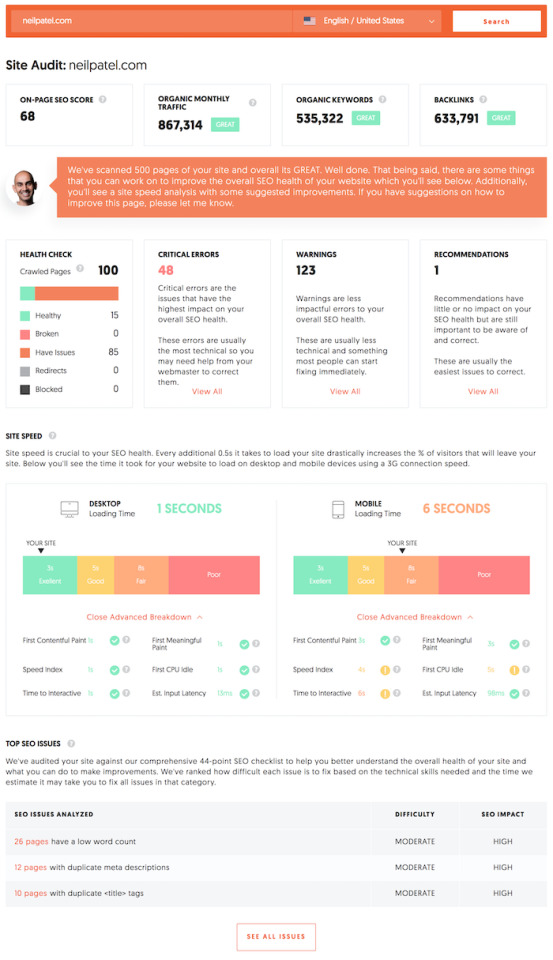
You’ll see a report that breaks down your mobile and desktop load times as well as what you can do to improve them.
Lesson #17: Quality over quantity
SEO used to be a game of quantity over quality.
That isn’t the case anymore. With over a billion blogs, Google has its fair share of sites to choose from.
Just look at About.com. Eventually they renamed it Dotdash and changed their strategy.
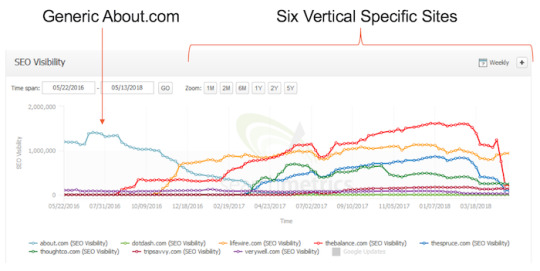
They took all of their About.com content and moved it over to 6 vertical based sites and deleted 900,000 pages of junk content.
This grew their traffic and revenue by a whopping 140%.
Focus on writing high-quality content. It’s why I blog less and try to make my content amazing.
Lesson #18: Tools are better than content marketing
I used to focus all of my energy on content marketing because it drove a lot of links and SEO traffic.
But over time, I realized that creating free tools builds more natural links than anything else I have ever tested.
Just look at Ubersuggest. I spent years creating it and look at how many links it has generated…
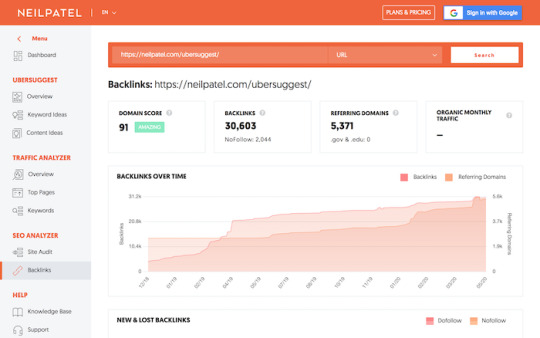
30,603 backlinks! That’s a lot of links.
If you don’t have the resources to build a custom tool like me, you can always start with buying a white label tool from Code Canyon for $10 or $20. They literally have tools for almost all industries.
Lesson #19: Don’t rely only on SEO
When I first got started in SEO, all I could think about was SEO.
To me, it was the best marketing channel out there because it allowed me to compete with large companies.
Even to this day, I still love SEO more than any other channel.
But it doesn’t stop me from leveraging other marketing channels.
See, years ago you could build a business off of one marketing channel.
Yelp was built through SEO. Dropbox through social media referrals. Facebook through email invites…
Those days don’t exist anymore. You can’t just build your traffic from one channel.
Although you should do SEO, you should also try paid ads, social media marketing, email marketing, push notifications, and anything else that comes out.
Diversify your traffic sources and don’t just rely solely on SEO.
Lesson #20: People love linking to data
Spending money and time to gather your own unique data is an easy way to build links.
Check out my posts on content marketing trends and social media trends.
I’ve added tons of unique data, stats, and charts to each of those posts.
The end result? Extra backlinks.

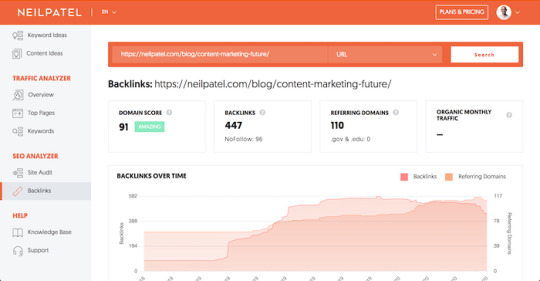
The content marketing trends post received 447 backlinks.
If you don’t have the time to gather custom data you can always find someone on Upwork to help you out.
Lesson #21: Don’t forget about Infographics
One of my favorite SEO strategies that still works well today is infographics.
I have tons of them on the NeilPatel.com blog.
I didn’t start off with infographics here… I used to do them on my old blog Quick Sprout and KISSmetrics.
Here’s an interesting stat for you when I used to crank out infographics on KISSmetrics.
Within a two-year period, from 2010 to 2012, 47 infographics generated 2,512,596 visitors and 41,142 backlinks from 3,741 unique domains. They also generated 41,359 tweets and 20,859 likes.
If you don’t have money to hire a designer, you can use Infogram or Canva to create one on your own.
Lesson #22: Google doesn’t penalize for duplicate content
You don’t want to post tons of duplicate content on your site as it’s not the best user experience, but keep in mind that Google doesn’t penalize you for duplication.
They may not just rank the duplicate content as well.
So, if you spend all of this time producing amazing, unique content, why not publish it FIRST on your own website.
Then after a few hours or days if you want to be safe, take that exact content and publish it on Facebook, LinkedIn, and anywhere else that will accept your content.
Literally, take all of the words and paste them onto those social channels.
It will get you extra awareness and branding. Plus, the content should already be indexed on your site, so Google knows it came from your first… and I doubt you care if the duplicated version on LinkedIn ranks. That’s still great branding.
In other words, don’t be afraid to repurpose your content even if it causes duplication.
Just look at this post, for example. I’m also repurposing it into a 4-part podcast series.
Lesson #23: Don’t recreate the wheel
I used to spend hours a week doing keyword research trying to figure out what new terms to rank for.
Eventually, I figured out an easier and better way to find new content topics and keywords to go after.
Go to Ubersuggest, type in your competitor’s domain name and hit search.
In the left-hand navigation click on Top Pages.

You’ll see a report that shows you all of the popular pages on your competition’s website. This will give you ideas for the type of pages you should create on your website.

Then I want you to click “View All” under Est. Visits (estimated visits). This will show you all of the keywords that drive traffic to that page.

You now have a list of topics and keywords for each topic to go after.
Lesson #24: Don’t pick a generic domain name
Remember how in Lesson 11 I talked about brand queries and how they helped rankings?
After I learned that, I decided to go buy exact match domain names where the domain name was the keyword.
That way I would get lots of brand queries without trying.
Well, there’s an issue… even if you rank high, what you’ll find is you will have a low click-through rate in most cases.
If you have a low click-through rate, it tells Google your brand isn’t strong and people don’t prefer it, which can hurt your ranking.
So instead of focusing on exact match domains, unless you have millions to spend on branding like Hotels.com, focus on building a memorable brand.
youtube
Pick something that is unique, easy to spell, and easy to remember.
Lesson #25: Learn from blackhat SEOs, but don’t go over to the dark side
Blackhat SEOs come up with some interesting data and experiments.
Many of them don’t work for long, but they are interesting none-the-less.
Although I don’t recommend practicing blackhat SEO, I do recommend following them.
The easiest way you can learn from them is by reading Blackhat World.
People there share some interesting insights, especially every time there is a major Google algorithm update.
Again, I don’t recommend practicing blackhat SEO, but following them may help you uncover “white hat” techniques that can increase your rankings. Not everything they do is bad… many of them use legitimate tactics as well.
Lesson #26: Short URLs rank better than long ones
My URLs used to be the title of my blog post.
For example, with this post I would have used this URL in the past…
Neilpatel.com/blog/30-lessons-after-30-million-seo-visitors/
Eventually I switched to short URLs.
Google just prefers them. And I’ve seen it firsthand. That’s why I use short ones now.
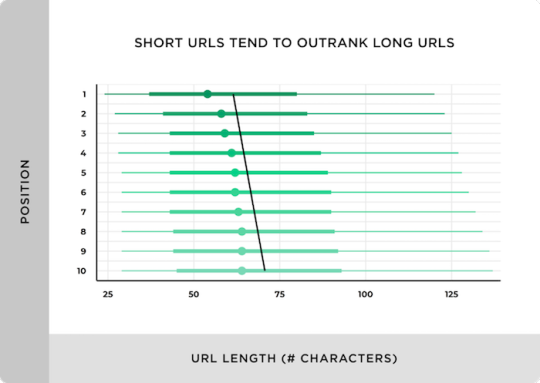
URLs at position #1 are on average 9.2 characters shorter than URLs that rank in position #10. So, keep them short.
Lesson #27: The power’s in the list
If you want your content to rank high on Google, you need more people to see it.
Whether it is from social shares, or from push notifications or email blasts… the more people that see your content, the more engagement it will get, and the more people that will link to it.
I used to do a ton of manual outreach every time I published a new blog post and I would email people asking them to link to me.
And it works, it’s just time consuming and a pain.
These days, I have a better strategy… send out an email blast every time I publish a new post.

I can now get anywhere from 20,000 to 50,000 clicks per email I send out.
Now of course you won’t get that from day one as it took me years to build up my email list.
But you can start today by collecting emails. You can easily do that through Hello Bar.
And as your list grows, so will the clicks to your blog and the number of links you get, which in turn will increase your rankings.
Lesson #28: Don’t let your foot off the peddle
This was one of the hardest lessons I learned.
It’s exhausting to continually blog and do your own SEO. Sometimes you just want a break.
With my old blog, Quick Sprout, I used to publish 12 blog posts a month and I did that consistently for 3 years.
One day I decided that I wanted to stop for a month. So, I took a 30-day break.
Guess what happened to my traffic?
It tanked by 32%.
So, then I started blogging again. And guessed what happened to my traffic after I started blogging?
It didn’t come right back.
It took me 3 months to get back to where I was.
When things are working for you, don’t slow down. Keep pushing harder, even if you are exhausted. Because the moment you stop, you’ll drop, and it is a lot of work to get back to where you were.
Lesson #29: The best SEO advice comes from conferences
The best SEO advice I have ever learned over the years has come from conferences.
And no, I don’t mean by sitting in on the sessions, although you can learn from those too.
The best SEO secrets and advice I learned came from networking. When you go to these conferences, hundreds if not thousands of other SEOs are there. And when you go to the bar after hours and mingle with people, you’ll quickly pick stuff up.
You’ll be shocked at what people tell you. It’s how I learned a lot of the good tactics that I still use today.
Lesson #30: Never stop learning
This one may sound obvious but when things are going well, people get complacent.
Google makes on average 3,234 updates per year and that count has been increasing over time.
Just think about that for a bit… that’s roughly 9 algorithm updates per day.
Because they are changing so quickly, you won’t survive if you don’t stay up to date.
Yes, the ideal strategy is to do what’s best for your users or visitors as in the long run, Google wants to promote those sites, but it doesn’t mean that you can ignore the changes happening in the industry.
Read all of the SEO blogs out there, attend conferences as I mentioned above… experiment on test sites… push yourself to be better.
That drive of always improving and always wanting to learn more has helped me tremendously. It’s one of the reasons for my growth in rankings over the years.
Conclusion
There are a lot of lessons that you will learn as your rankings grow and as you spend more time on SEO.
But hopefully, you don’t have to waste time and go through the same mistakes I made. You don’t want to learn these lessons the hard way.
That’s why I decided to share them. I want to save you the time and help you achieve your traffic goals faster.
Which SEO lessons have you learned?
The post 30 Lessons After 30 Million SEO Visitors appeared first on Neil Patel.
Original content source: https://neilpatel.com/blog/seo-visitors/ via https://neilpatel.com
The original post, 30 Lessons After 30 Million SEO Visitors, has been shared from https://imtrainingparadise.wordpress.com/2020/05/19/30-lessons-after-30-million-seo-visitors/ via https://imtrainingparadise.wordpress.com
0 notes
Text
30 Lessons After 30 Million SEO Visitors

As you can see from the screenshot above, I’ve driven 30 million visitors to my website from SEO.
Technically it’s more, but who’s counting.
What’s funny, though, is I barely look at my traffic, even as Google continually rolls out algorithm updates.
I know that sounds contradictory because if you are an SEO, why wouldn’t you obsess about traffic, right?
Well, it’s because I’ve learned some hard lessons over the year… mainly because I’ve made a lot of mistakes.
So today, I wanted to share them with you so that you can learn from my mistakes… so here goes:
Lesson #1: Don’t obsess over rankings, obsess over conversions
I used to check my rankings every single day. Literally.
On top of that, I would log into Google Analytics 4 to 5 times a day and continually check my traffic.
That’s all I cared about back in the day… boosting my organic traffic.
But here is the thing: As my rankings and traffic went up over the years, my revenue didn’t go up proportionally.
For example, during one quarter in 2017, my SEO traffic went up 39.52%, but my revenue from SEO went up only 4.29%.
I quickly learned that traffic isn’t everything. If you can’t convert the traffic into revenue it doesn’t matter.
That taught me that you need to focus on the right keywords that drive conversions and continually optimize your site for conversions.
An easy first step for you to take is to install Crazy Egg and run a heatmap to see where people click so you adjust your design and copy to get more sales.

Lesson #2: The easiest way to grow your SEO traffic is international expansion
You already know that I get a lot of SEO traffic, but do you know what country drives most of my traffic?
If you guessed United States, you are wrong.
Brazil is my most popular region, followed by India.

International SEO is the easiest way to expand and grow your traffic. Here are a few posts that you should read before you expand your SEO globally:
How to create a global SEO strategy
Fundamentals of international SEO
How to correctly setup your site for international SEO
How to profitably expand your SEO globally
Lesson #3: Keywords are very, very, very, very important
When I used to write my content, I didn’t obsess about the keywords when I should have.
My team actually proved me wrong on this.
I used to focus on writing content for humans and didn’t worry about search engines. My team, on the other hand, obsesses about keywords.
Just look at the growth of our traffic in Brazil because of our obsession with the right keywords.

One simple thing I do before writing that has really helped is I head over to Ubersuggest and type in a few of the keywords that I want to go after.

Once it loads, you’ll see a report like the one above. I want you to then click on “Keyword Ideas” in the left-hand navigation.

You’ll see a report that contains a list of keywords that you could potentially be targeting.

Make sure you click on the “Related” tab, as well as “Questions” and “Comparisons” … scroll through the list. You’ll see hundreds of keywords. Pick all of the ones that are relevant and ideally have a high cost per click (CPC). These are the keywords that’ll not only drive traffic but revenue as well.
Whenever I write a blog post, I go through this step. Every single time.
Lesson #4: AMP pages can drive more SEO traffic
AMP pages load faster on mobile devices than non-AMP pages.
If you aren’t familiar with the AMP framework, read this.
What most people won’t tell you about AMP pages is that:
In regions like the United States, Canada, and the United Kingdom, countries with decent Internet infrastructure, you won’t see much of an increase in traffic.
In regions with poor Internet infrastructure, like Brazil, you’ll see a 10 to 15% lift in mobile SEO traffic by having AMP pages.
AMP pages don’t convert visitors into customers as well as normal responsive web design. So, you’ll have to work on testing your AMP pages so you can boost your conversion rates.
Lesson #5: SEO will never convert as well as paid ads
When I started off with SEO, I would run projections on how much the traffic would make me.
But the numbers were always off, even if I was able to get the rankings.
Here’s the main reason: If you are bidding on terms like auto insurance through ads, you can drive people to a landing page that looks like this:

But if you want to rank organically, you’ll have to do it through content. So, your page that ranks well will look more like this and convert less…

It doesn’t mean SEO is bad. In reality, it’s much cheaper in the long run than paid ads and will produce a better ROI. But don’t just assume that if you get 100 visitors from paid ads and 3 purchases that you’ll have the same conversion rate with your SEO traffic.
Chances are it will be significantly lower by maybe 2 or 3x, but because SEO is cheaper, it will be much more profitable.
Lesson #6: Remarketing is one of the best ways to generate an ROI from SEO
If you get a ton of traffic from SEO, there is a simple strategy you can implement to boost your conversions.
Remarket everyone on Facebook, Google, and YouTube.
That way people come to your site, read your content, and build trust with you and your brand.
Then you remarket them throughout the web with ads that prompt your products or services and send them to a landing page that will drive sales.
I’ve been doing this for years, just look at my old remarketing ad…

For the regions I use remarketing in, it is responsible for 46% of my leads.
Lesson #7: Don’t forget to update your old content
I publish one new blog post a week. I’m working on increasing this as I get more time, but for now, it is one a week.
Can you guess how many blog posts I update on a daily basis? Technically it is 0 (me at least), but my team focuses on updating at least 3 old blog posts per day. That’s roughly 90 a month.
Once you have a few hundred pages, make sure you focus on updating your old content or else your traffic will quickly drop.
You can use this content decay tool to see which posts you should update first.
This will help you continually grow your SEO traffic instead of hitting plateaus or seeing your traffic take massive drops.
Lesson #8: Don’t forget to optimize your title tags
One of the easiest ways to grow your rankings is to optimize your title tags.
If you can write persuasive copy and get more clicks, you’ll quickly move up on Google.
In Brazil, we spend more time doing this than we do in the United States.

We get a similar amount of impressions in Brazil, but we have more people focusing on improving our title tags and testing. Hence, we get 95% more SEO traffic in Brazil.
If you want tips on boosting your clicks, check out this article.
Another simple hack is to use the “Content Ideas” report in Ubersuggest.

On the right side of that report, you can see social share counts from Facebook and Pinterest. And on the left side, you see titles of articles.
Typically, if people like a title they share it more. So, look for titles that have a lot of shares as it will give you ideas on what you can use on your website to get more clicks and boost your rankings.
Lesson #9: Don’t put dates in your URL
I used to put dates in my URLs like:
Neilpatel.com/2017/12/title-of-post/
This causes search engines to assume that your content is related to a specific date. And after that date gets old, search engines assume your content is irrelevant and outdated.
The moment I removed the date from my URLs, I grew my SEO traffic by 58% in 30 days.
youtube
If you have dates in your URL, make sure you 301 redirect your old URLs to your new ones once you make that change, or else your rankings will drop.
Lesson #10: Don’t be afraid to use popups
Don’t you hate popups? Well, who doesn’t?
But people use them because they work.
The majority of your pages that will rank are blog-related content. And blog posts tend to drive fewer direct conversions because people are on your site to read the content.
In order to maximize your conversions from SEO, you should consider using exit popups so you can convert more of those visitors into customers as they leave.
When you leave this site in most cases, you’ll see a popup that looks like:

And it drives you to this quiz, which allows me to convert SEO visitors into customers.
You can easily copy me by using Hello Bar. It works for all industries including B2B and ecommerce and even lead generation sites.
Lesson #11: Brand queries affect rankings
Everyone talks about how you need links to boost rankings.
But very few people talk about brand queries.
As Google’s ex-CEO and ex-head of web spam both emphasized how brands are important.

One of the big reasons for my growth in SEO traffic is the growth in my brand. I’ve seen a direct correlation in which the more people who find me from my name, the more SEO traffic I get.
Just look at my brand growth over time:

I’ve received over 1.9 million visitors over the last 16 months from people typing in variations of my name in Google.
Lesson #12: Don’t waste your money on paid links
I’ve been doing SEO since I was 16 years old. That’s a long time…
When I started off as a kid, I dabbled in paid links and I used to dominate Google for terms like online casino, online poker, web hosting, auto insurance, and even credit cards.
And I was making a killing off of affiliate income from these sites.
But it was all short lived.
Why?
Because I bought links. And eventually Google penalized all of those sites.
If I never purchased links, those sites would have taken longer to rank, but they would have been around today, and I would have generated more income overall.
Don’t buy links, it’s bad and shortsighted.
Lesson #13: Guest post to build a brand, not to build links
I already covered the importance of branding above.
A great way to build your brand and indirectly boost your SEO traffic is through guest posting.
But don’t use guest posting to build links.
Most sites that offer guest posts, nofollow them (which they should), and Google is smart enough to know what a guest post is, hence they ignore guest post links from sites like Forbes.
It’s pretty easy to spot a guest post for both a human and algorithm…

But if you are using it to build a brand, great. Focus on the content quality and not links.
Lesson #14: Don’t forget to interlink
Do you know what some of my highest ranked pages are?
The ones that are interlinked.
It takes anywhere from 6 months to a year for many of the interlinks to kick in, but it is still effective none-the-less.
Every time I wrote content, I used to make sure I link out to my older pieces of content when it made sense. But I made a big mistake… I wasn’t going into my older pieces of content and then adding links to my newer pieces of content.
That one change was game-changing for me. It took time to see the results but it worked exceptionally well.
It’s how I rank high for terms like “email marketing”.

Lesson #15: Google isn’t the only game in town
Although Google is the most popular search engine, it isn’t the only one you need to focus on.
Did you know that YouTube is the second most popular search engine?
Even Bing gets a lot of traffic.
If you want to rank high on Bing, follow this.
Or if you prefer video, watch this:
youtube
As for YouTube, this guide will teach you YouTube SEO. It works really well, just look at my YouTube SEO traffic:

Over the last 28 days, I received 429,501 video views through YouTube SEO.
Lesson #16: Speed is everything
The faster your server and the more optimized your site, the more traffic you’ll get.
Years ago, my friend Otis added more servers to his site GoodReads.
Within a month, his SEO traffic went up over 20%.
Speed is part of Google’s algorithm, so optimize it for both web and mobile.
A quick way to see your site’s speed is to enter your URL here.

You’ll see a report that breaks down your mobile and desktop load times as well as what you can do to improve them.
Lesson #17: Quality over quantity
SEO used to be a game of quantity over quality.
That isn’t the case anymore. With over a billion blogs, Google has its fair share of sites to choose from.
Just look at About.com. Eventually they renamed it Dotdash and changed their strategy.

They took all of their About.com content and moved it over to 6 vertical based sites and deleted 900,000 pages of junk content.
This grew their traffic and revenue by a whopping 140%.
Focus on writing high-quality content. It’s why I blog less and try to make my content amazing.
Lesson #18: Tools are better than content marketing
I used to focus all of my energy on content marketing because it drove a lot of links and SEO traffic.
But over time, I realized that creating free tools builds more natural links than anything else I have ever tested.
Just look at Ubersuggest. I spent years creating it and look at how many links it has generated…

30,603 backlinks! That’s a lot of links.
If you don’t have the resources to build a custom tool like me, you can always start with buying a white label tool from Code Canyon for $10 or $20. They literally have tools for almost all industries.
Lesson #19: Don’t rely only on SEO
When I first got started in SEO, all I could think about was SEO.
To me, it was the best marketing channel out there because it allowed me to compete with large companies.
Even to this day, I still love SEO more than any other channel.
But it doesn’t stop me from leveraging other marketing channels.
See, years ago you could build a business off of one marketing channel.
Yelp was built through SEO. Dropbox through social media referrals. Facebook through email invites…
Those days don’t exist anymore. You can’t just build your traffic from one channel.
Although you should do SEO, you should also try paid ads, social media marketing, email marketing, push notifications, and anything else that comes out.
Diversify your traffic sources and don’t just rely solely on SEO.
Lesson #20: People love linking to data
Spending money and time to gather your own unique data is an easy way to build links.
Check out my posts on content marketing trends and social media trends.
I’ve added tons of unique data, stats, and charts to each of those posts.
The end result? Extra backlinks. 🙂

The content marketing trends post received 447 backlinks.
If you don’t have the time to gather custom data you can always find someone on Upwork to help you out.
Lesson #21: Don’t forget about Infographics
One of my favorite SEO strategies that still works well today is infographics.
I have tons of them on the NeilPatel.com blog.
I didn’t start off with infographics here… I used to do them on my old blog Quick Sprout and KISSmetrics.
Here’s an interesting stat for you when I used to crank out infographics on KISSmetrics.
Within a two-year period, from 2010 to 2012, 47 infographics generated 2,512,596 visitors and 41,142 backlinks from 3,741 unique domains. They also generated 41,359 tweets and 20,859 likes.
If you don’t have money to hire a designer, you can use Infogram or Canva to create one on your own.
Lesson #22: Google doesn’t penalize for duplicate content
You don’t want to post tons of duplicate content on your site as it’s not the best user experience, but keep in mind that Google doesn’t penalize you for duplication.
They may not just rank the duplicate content as well.
So, if you spend all of this time producing amazing, unique content, why not publish it FIRST on your own website.
Then after a few hours or days if you want to be safe, take that exact content and publish it on Facebook, LinkedIn, and anywhere else that will accept your content.
Literally, take all of the words and paste them onto those social channels.
It will get you extra awareness and branding. Plus, the content should already be indexed on your site, so Google knows it came from your first… and I doubt you care if the duplicated version on LinkedIn ranks. That’s still great branding.
In other words, don’t be afraid to repurpose your content even if it causes duplication.
Just look at this post, for example. I’m also repurposing it into a 4-part podcast series.
Lesson #23: Don’t recreate the wheel
I used to spend hours a week doing keyword research trying to figure out what new terms to rank for.
Eventually, I figured out an easier and better way to find new content topics and keywords to go after.
Go to Ubersuggest, type in your competitor’s domain name and hit search.
In the left-hand navigation click on Top Pages.

You’ll see a report that shows you all of the popular pages on your competition’s website. This will give you ideas for the type of pages you should create on your website.
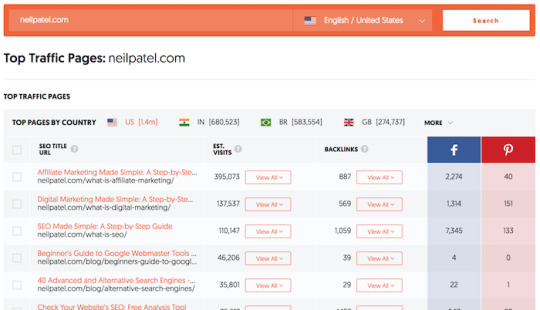
Then I want you to click “View All” under Est. Visits (estimated visits). This will show you all of the keywords that drive traffic to that page.

You now have a list of topics and keywords for each topic to go after.
Lesson #24: Don’t pick a generic domain name
Remember how in Lesson 11 I talked about brand queries and how they helped rankings?
After I learned that, I decided to go buy exact match domain names where the domain name was the keyword.
That way I would get lots of brand queries without trying.
Well, there’s an issue… even if you rank high, what you’ll find is you will have a low click-through rate in most cases.
If you have a low click-through rate, it tells Google your brand isn’t strong and people don’t prefer it, which can hurt your ranking.
So instead of focusing on exact match domains, unless you have millions to spend on branding like Hotels.com, focus on building a memorable brand.
youtube
Pick something that is unique, easy to spell, and easy to remember.
Lesson #25: Learn from blackhat SEOs, but don’t go over to the dark side
Blackhat SEOs come up with some interesting data and experiments.
Many of them don’t work for long, but they are interesting none-the-less.
Although I don’t recommend practicing blackhat SEO, I do recommend following them.
The easiest way you can learn from them is by reading Blackhat World.
People there share some interesting insights, especially every time there is a major Google algorithm update.
Again, I don’t recommend practicing blackhat SEO, but following them may help you uncover “white hat” techniques that can increase your rankings. Not everything they do is bad… many of them use legitimate tactics as well.
Lesson #26: Short URLs rank better than long ones
My URLs used to be the title of my blog post.
For example, with this post I would have used this URL in the past…
Neilpatel.com/blog/30-lessons-after-30-million-seo-visitors/
Eventually I switched to short URLs.
Google just prefers them. And I’ve seen it firsthand. That’s why I use short ones now.

URLs at position #1 are on average 9.2 characters shorter than URLs that rank in position #10. So, keep them short.
Lesson #27: The power’s in the list
If you want your content to rank high on Google, you need more people to see it.
Whether it is from social shares, or from push notifications or email blasts… the more people that see your content, the more engagement it will get, and the more people that will link to it.
I used to do a ton of manual outreach every time I published a new blog post and I would email people asking them to link to me.
And it works, it’s just time consuming and a pain.
These days, I have a better strategy… send out an email blast every time I publish a new post.

I can now get anywhere from 20,000 to 50,000 clicks per email I send out.
Now of course you won’t get that from day one as it took me years to build up my email list.
But you can start today by collecting emails. You can easily do that through Hello Bar.
And as your list grows, so will the clicks to your blog and the number of links you get, which in turn will increase your rankings.
Lesson #28: Don’t let your foot off the peddle
This was one of the hardest lessons I learned.
It’s exhausting to continually blog and do your own SEO. Sometimes you just want a break.
With my old blog, Quick Sprout, I used to publish 12 blog posts a month and I did that consistently for 3 years.
One day I decided that I wanted to stop for a month. So, I took a 30-day break.
Guess what happened to my traffic?
It tanked by 32%.
So, then I started blogging again. And guessed what happened to my traffic after I started blogging?
It didn’t come right back.
It took me 3 months to get back to where I was.
When things are working for you, don’t slow down. Keep pushing harder, even if you are exhausted. Because the moment you stop, you’ll drop, and it is a lot of work to get back to where you were.
Lesson #29: The best SEO advice comes from conferences
The best SEO advice I have ever learned over the years has come from conferences.
And no, I don’t mean by sitting in on the sessions, although you can learn from those too.
The best SEO secrets and advice I learned came from networking. When you go to these conferences, hundreds if not thousands of other SEOs are there. And when you go to the bar after hours and mingle with people, you’ll quickly pick stuff up.
You’ll be shocked at what people tell you. It’s how I learned a lot of the good tactics that I still use today.
Lesson #30: Never stop learning
This one may sound obvious but when things are going well, people get complacent.
Google makes on average 3,234 updates per year and that count has been increasing over time.
Just think about that for a bit… that’s roughly 9 algorithm updates per day.
Because they are changing so quickly, you won’t survive if you don’t stay up to date.
Yes, the ideal strategy is to do what’s best for your users or visitors as in the long run, Google wants to promote those sites, but it doesn’t mean that you can ignore the changes happening in the industry.
Read all of the SEO blogs out there, attend conferences as I mentioned above… experiment on test sites… push yourself to be better.
That drive of always improving and always wanting to learn more has helped me tremendously. It’s one of the reasons for my growth in rankings over the years.
Conclusion
There are a lot of lessons that you will learn as your rankings grow and as you spend more time on SEO.
But hopefully, you don’t have to waste time and go through the same mistakes I made. You don’t want to learn these lessons the hard way.
That’s why I decided to share them. I want to save you the time and help you achieve your traffic goals faster.
Which SEO lessons have you learned?
The post 30 Lessons After 30 Million SEO Visitors appeared first on Neil Patel.
Original content source: https://ift.tt/2zcTaTl via https://neilpatel.com The post, 30 Lessons After 30 Million SEO Visitors, has been shared from https://ift.tt/2WJNUQh via https://ift.tt/2r0Go64
0 notes
Text
Landing a Public School/University Job in a Tier 1 City in China with Zero Professional Classroom Teaching Experience - Is it Possible? via /r/China
Landing a Public School/University Job in a Tier 1 City in China with Zero Professional Classroom Teaching Experience - Is it Possible?
What's up, everybody!
I'm reaching out because I've been thinking about making the move to China for a little while, but I only recently started getting serious about making the move. Apologies if all of this comes off long-winded, but I want to provide as much relevant background as possible (in order to, hopefully, avoid coming off like a total schmuck).
With my research on job opportunities in China, I stumbled across the inevitable TESL career path. At first, I was somewhat turned off by this, as I've been focusing my efforts heavily in a B2B sales job in IT staffing in the United States for the past few years, and I wanted to keep my career experience as relevant as possible.
However, after doing some research across various forums and websites, I came across an interesting phenomenon: I noticed that there were opportunities to teach English in public school/university in China for around 20-25 hours per week with minimal-to-no office hours. With that being said, my interest shifted: What if I worked in a teaching job like this for 2+ years and focused the majority of my remaining time in intense Mandarin learning and cultural immersion? In addition, I could focus on networking once I got on the ground in China and explore other non-teaching opportunities in my spare time (assuming I get my Mandarin skills where they need to be).
I love Asian culture, and I've been excited to continue to learn more about it. I've been studying Mandarin for a bit now, and a big goal of mine has been to develop enough fluency in Mandarin to focus my efforts on landing international sales jobs, whether that's in China full-time or in another World City in the US where I'm traveling back-and-forth to China to do B2B sales on an enterprise level. Of course, I love the idea of teaching and helping people grow in this area--not trying to come too self-centered and pompous.
Here's some context:
I'm a native English speaker from the United States
I'm 26 years old
I have a BSBA in Economics from a State University (ranked roughly 550 in the world, not 100 unfortunately lol)
I have around 3 years experience in a B2B sales/staffing role. This involves a heavy emphasis on communication, where I'm regularly client-facing, delivering presentations, mentoring junior sales people, and educating my clients in business meetings about the market vs what they perceive it to be.
My timeline to get to China is about 2 years from now, so I'll have roughly 5 years of solid business experience by then.
Outside of the above, I've taught swim lessons as a life guard and served as a teaching assistant in high school, but I have zero years of professional post-grad classroom teaching experience.
I will plan to obtain TESOL cert to help offset my lack of teaching experience.
I am around HSK 2 Mandarin proficiency. I plan to be level 3 or 4 by the time I get to China.
I'm planning to save up as much money as possible over the next couple years. I won't be dependent upon a comfortable salary of 15-25K RMB.
Here are my questions:
-Given my background, is it possible for me to get a public school or university teaching job in a Tier 1 City in China? I'd REALLY love to get to a place like Shanghai as soon as possible. I've read up on training centers quite a bit, where you're expected to work 40+ hours per week at odd hours, which is why I've been largely wanting to avoid them... The last thing I want to do is spend all my time in a classroom teaching kindergarten.
-Are there other non-teaching opportunities with 20-25 hour work weeks that exist and will allow me to obtain a Z Visa? Again, the big goal is a low hour work schedule. Money is not the biggest concern. The biggest concern is having plenty of time to immerse myself in the language, network, and enjoy China.
-My absolute #1 preference would be to teach Business English, as I think it'd be perfect for my background. Are there 20-25/hr work week opportunities that offer this on a Z Visa? Or do you have to have x amount of teaching experience to even break into these?
Moving Forward:
Truly appreciate all the help in advance. Love this community, and I've learned WAY more about how to navigate these complexities from the Reddit community than I could have ever dreamed. Please feel free to PM me anytime if you have common goals or just want to network.
Also, despite the devilish Chinese recruiters I've heard about (there's a lot of bad ones in the US, too), I, myself, am a recruiter in the United States, and I'm always happy to help anyone out who needs some career/resume advice in the US. Free of charge and solely as a favor, so please, feel free to PM me (especially if you have good advice).
Wes
WeChat: WesDogg
Submitted November 11, 2019 at 05:49PM by WesDogg54 via reddit https://ift.tt/2Ke0JLV
0 notes
Photo
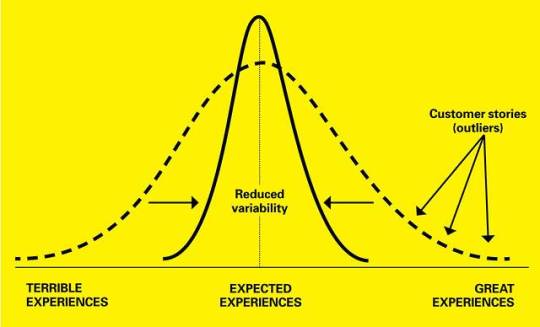
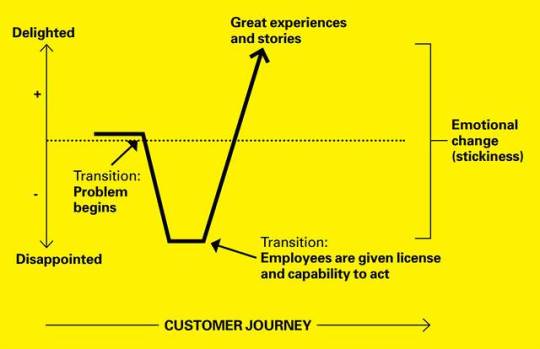

(via The Magic That Makes Customer Experiences Stick)
By Stefan Thomke
The most memorable experiences are suffused with emotion — not extra features or value for money.
advertisement
A participant in one of my Harvard Business School executive education classes told a story about a family trip to Walt Disney World in Orlando, Florida. She lost her purse in the park on the very first day: tickets, money, IDs, all gone. The highly anticipated vacation seemed all but over before it had begun. But when the family turned to a Disney employee for help, he gave them food vouchers and park tickets for the next day. And while the relieved family was enjoying the park, Disney employees searched for the purse — and found it. The executive enthused to my class: “Wow, what a company!”
Over the years I have heard hundreds of such stories in my classes. I ask students to tell them as part of an effort to develop principles that can be applied to the design of great customer experiences. This field of customer experience (CX) design — which aims to ensure that customers have positive touch points with companies while buying and consuming their products and services — has grown quickly in recent years. Research has shown that memorable experiences, and the ensuing positive word of mouth, can drive customer decisions as much as, if not more than, price and functionality.1 To that end, consultants have created thoughtful tools and frameworks such as journey mapping, service blueprinting, and problem-solving mindsets. Academics have studied customer engagement models that focus on managerial variables such as employee selection, training, rewards, and service culture. Yet recent research reports suggest that there have been few, if any, meaningful improvements in customer experience over time.2 Despite the insights gleaned about customers through advanced technologies and data analysis, something still seems to be missing for most companies.
My classroom experience points to the missing ingredient: emotion. Years ago, when I first asked students for their most memorable experiences as customers, I was surprised by the language they chose: Made me feel special. Showed empathy. Really cared. Personalized the process. Trusted me. Didn’t argue or delay. Killed us with kindness. Owned the problem. Surprised us. Made things simple. These executives weren’t using the standard language of business. They weren’t using terms like functional value, efficiency, and cost-value analysis. Instead, they were describing emotional impact. Their feelings of surprise, delight, happiness, relief, empathy, and more defined their most memorable experiences.
The stories they shared — along with a deep dive into research on the many components of decision-making — led me to a critical insight: Customers want their choices to align as much with their feelings and senses as with their values and ethics. The rational approaches taught at most business schools — offer customers more value for money, add features, make service more efficient — are not enough. Creating memorable experiences for customers also requires a bit of emotional magic. This article explores how that can work, drawing on several company cases to illustrate. People like to think of themselves as logical, but the truth is that emotions inspire decisions.
Research on human cognition and behavior supports the idea that customer experiences should be as infused with emotion as they are with logic and rationality. “The essential difference between emotion and reason is that emotion leads to action while reason leads to conclusions,” writes neurologist Donald Calne in Within Reason: Rationality and Human Behavior. Psychologist Richard Lazarus clarifies this idea in his book Emotion and Adaptation, where he argues that cognition (thinking), emotions (feeling), and motivation (acting) work as a system, with emotions serving as the critical go-between. Lazarus says that events — and by events he means everything from experiencing an earthquake to shopping for shoes — trigger a cognitive appraisal and an emotional reaction before we come to a decision on what to do. This process helps explain the many studies described in behavioral economist Dan Ariely’s book Predictably Irrational in which people behaved irrationally. We overpay, underestimate, procrastinate, and so on because we are emotional beings, not rational automatons.
The behaviorists’ theories and results are borne out by quantitative research. A Forrester Research study found that customer loyalty is driven more by emotional factors than by rational ones.3 Another study, by CEB Marketing Leadership Council and Google, suggests that this may also be true in B2B decisions. They surveyed 3,000 B2B buyers across 36 brands and interviewed 50 B2B marketing organizations, and found that personal value (appeal to emotions) has twice the impact of business value (appeal to logic and reason) on favorable decisions.4
The payoff can be huge. A report from Gallup suggests that organizations that optimize emotional connections outperform rivals by 26% in terms of gross margin and 85% in terms of sales growth.5 They cultivate emotionally engaged customers who are less price sensitive, less likely to buy from competitors, and three times more likely to recommend and repurchase.
Celebrate the Outliers
Ask yourself this: Is your company trying to minimize complaints or maximize customer delight? Given the research I’ve cited, you might think that every company would be trying to create dynamic, delightful customer journeys infused with emotion. You’d be wrong. Many focus almost solely on complaints. Their goal: Eliminate the customer’s pain at every point where the consumer and the company intersect. It’s a myopic strategy that leads to consistent mediocrity, because companies miss much of what the customer experiences on his or her journey.
Today’s customer journey is not just a matter of a few touch points as the consumer systematically narrows choices. Instead, most consumers take an iterative and expansive journey. They consider multiple perspectives, often through the use of social media. They interact with other people and other products and services. The journey between visiting a company’s website, say, and making an actual purchase is an emotional, cognitive, and motivational process. It’s the mix of those forces that creates feelings, memories, and stories about an organization, whether positive, negative, or ambivalent. It’s this variability that creates opportunities for companies to deliver memorable experiences. Rules and standardization can get in the way (see “Reducing Variability Can Eliminate Terrible and Great Experiences”), because sameness is forgettable.
Reducing Variability Can Eliminate Terrible and Great Experiences
When companies focus on reducing variance in customer experience, eliminating outliers, they make sure that, statistically speaking, as many customers as possible occupy the middle of a normal distribution curve. Terrible customer experiences get a lot of attention, which reinforces the strategy of standardizing operating procedures and laying down more rules. Imposing controls helps bring experiences closer to expectations. While eliminating bad experiences may reduce complaints, result in fewer angry customers, and trim costs, the unanticipated consequence of moving most customers to the middle of distributions is that it will also result in consistent mediocrity. They will have undifferentiated, average experiences, which will leave them with few, if any, memories.
For that reason, positively varied emotional journeys can have the richest payoff. They leave indelible memories, increase customer loyalty, and have multiplier effects in a world where customers are closely connected.6 For companies that embrace variability, even terrible experiences that spawn negative emotions — such as that lost purse at Disney World — are an opportunity.7 If the company surprises and delights the customer by efficiently and innovatively resolving his or her problem, the dominant emotion, the one that lasts in memory, will be positive. The managerial challenge is clear: how to infuse customer journeys with emotion.
Building Emotion Into Customer Experiences
Bringing emotion into customer journeys isn’t easy. Triggering a specific emotion at a particular touch point doesn’t guarantee anything. Instead, companies must address the customer journey holistically, understanding that people may remember emotions generated anywhere along the way. In my work over the last few years, I’ve identified five ways to do this.
1. Stimulate the senses. Sensory stimulation triggers emotions such as surprise, trust, joy, and even anticipation. Through products from cars to smartphones, clever companies use the senses to create emotional experiences.
At Ferrari, for example, automobile design is more than an exercise in efficient engineering. It’s also a process that taps into the driver’s senses to create an emotionally rich experience, from the pleasing sight of the car’s body to the exhilarating roar of the engine.8 Ferrari uses plush interior materials such as fine leather, even though this gives lighter, faster competitors a 5- to 10-kilogram advantage. The company also experiments with advanced technology, engine placement, tire dimensions, and the nuances of wheel movement to impart a feeling of control as you steer through tight corners or accelerate laterally. Compared with the fear you might feel in other sports cars as your back wheels fishtail, there’s a sense of power and achievement here, of believing that you are an exceptional driver steering the car to new heights of performance.
The story of how Ferrari struggled to get the sound right for its turbocharged 488 also illustrates how much attention it pays to emotions. For years, Ferrari worried that turbocharged engines, which can flatten intake and exhaust sounds while introducing annoying tones such as whistling, would detract from the pleasure of driving. At Ferrari, sound is a critical component of what a car buyer expects and enjoys. Indeed, there’s real evidence that customers associate sound with performance. Could Ferrari engineer turbo engines for an emotionally pleasing driving experience?
Using a proprietary sound simulator, the equivalent of three Ferrari engineers and drivers worked full time for two years on the problem. One of the team’s recommendations — increase the exhaust diameter from 63 to 70 millimeters — had extensive ripple effects for engineers and company managers. Implementation was difficult and time-consuming.
That kind of investment might seem excessive at other companies, but not at Ferrari, which places great value on the emotions behind the driving experience. The 488 has garnered praise and prizes for its sound and performance, winning the 2018 International Engine of the Year award in Stuttgart, Germany (rival Porsche’s hometown), and being hailed as Robb Report’s Car of the Year in 2016. Ferraris may not be the fastest or the most comfortable cars, but the company focuses on producing the best combination of the two, making their cars among the world’s most thrilling and luxurious.
Stimulating the senses doesn’t mean creating sensory overload. Some of the best examples of sensory appeal are ones where complexity gives way to simplicity. Apple products are known for this. From the original Mac to AirPods and iPhones, the company repeatedly hides cutting-edge technology behind a simple user interface that customers love. Few competitors have been able to achieve that. Samsung, for example, trails Apple in user experience even though, feature by feature, its products are often superior.
The power of sensory simplicity is at work at HappyOrNot (HON), a small Finnish startup that measures businesses’ customer satisfaction through polling.9 The central challenge is how to gather enough responses to support meaningful conclusions. Few customers have the time or inclination to fill out long, boring surveys.
advertisement
HON tackles this problem with radical visual and tactile simplicity. Near the exits of department stores, airports, dining halls, drugstores, supermarkets, and other establishments, HON installs a terminal with four big push buttons. The green ones have smiley faces, and the red ones have frowny faces. The shades of the most smiley and most frowny are darker than the other two. A small sign asks customers to rate their experience by pressing one of the buttons. A HON terminal can prompt thousands of reactions in a single day. In fact, with terminals in over 100 countries, HappyOrNot’s buttons have prompted well over 600 million responses from customers. That’s more than all the customer ratings posted to sites like Yelp, TripAdvisor, or Amazon. The clarity of the colors is important, but the company believes that the satisfying tactile experience of pressing a button is the primary driver of this extraordinary participation.
2. Turn disappointment into delight. If your company is going to value the outliers, it must be ready to transform negative experiences into positives, as the hotel manager did in this story:
After a long transcontinental flight, my tired family arrived at a Taj Group hotel in India in the middle of the night. The front desk couldn’t find our reservation. Still, the night manager immediately took us to a room so we could go to bed right away, and even gave us an upgrade for the inconvenience (we waited less than five minutes!). He didn’t ask for a credit card or anything. When we woke up, the problem had been solved — and it wasn’t the hotel’s fault. Our booking agent had made a mistake.
I’ve heard many variations of this story (you may have, too), but the gist is always the same. By resolving a problem that he didn’t cause, the night manager delivered an experience that was remembered for years. When employees are taught to be in tune with the customer’s emotions, they can notice changes in emotional state and respond quickly. As their alacrity accelerates the shift from disappointment to delight, the intervention creates a sudden contrast that makes experiences sticky. (See “Capitalizing on Emotional Transitions.”)
Capitalizing on Emotional Transitions
By turning disappointment into delight, companies can create emotionally memorable experiences and win customers who will sing their praises.
Magicians, who constantly think about the audience experience, understand the emotional value of rapid shifts from disappointment and confusion to happy resolution. They have developed techniques to change people’s emotional states. For instance, a magician may allow members of the audience to believe that they have figured out the trick or caught him in a mistake, only to end it in a way that shows the audience had no idea what was really going on. Their momentary disappointment at their failure to “catch” the magician quickly transforms into delight in his excellence. Disappointment to delight: Magicians know that this emotional transition will wow audiences more than a constant flow of technically perfect tricks. The former creates memorable moments, while the latter may cause eyes to glaze over.
3. Plan to surprise. Good magic also upends expectations in order to engage people emotionally. For instance, the well-known magician Doug Henning developed an illusion in which an assistant would float on water, with a fountain providing cover for the support mechanism. But then magician David Copperfield, aware that audiences may have figured that out, took the trick further. Anticipating their reaction, he turned off the fountain, and the assistant remained floating — which surprised and impressed even people who knew of Henning’s show.
Like magicians, companies can thrill customers again and again through continual innovation and unexpected solutions to problems, building a loyal, delighted following for their products and services.
Creating those moments of surprise is often the result of paying attention to the smallest detail. When former Sony CEO Kazuo Hirai set out to turn around the company’s TV business in 2011, for instance, he discovered a fundamental problem.10 While the designs for Sony’s new TVs were beautiful, some customers said they found their sets ugly because the cables couldn’t be concealed. Armed with that knowledge, Hirai started responding in the same way to every new design: “I’m still seeing cables, and I don’t want to see the cables.” It took three years for the engineers to truly get the message. Hirai was teaching them that details matter to the customer, and that Sony would never develop winning products if it didn’t pay attention to the feelings its products evoked.
Sony eventually found a way of concealing the cables. As Hirai expected, customers were delighted by the surprise of not seeing the wires they had grown so accustomed to disliking and tolerating. Hirai, who recently retired as Sony’s chairman, told me: “Everything we do at Sony needs to have that ‘Wow, this is pretty cool’ element. … We don’t compete on functional specifications [anymore], but on people’s emotional experiences.”
Some companies try to inspire a desire to surprise in their employees. The Oberoi Group, a global hotel chain based in Delhi, India, gives its employees funding to surprise guests by turning problems into opportunities.11 Team members get funding to create such moments of delight; in 2013, employees logged more than 30,000 examples of this kind of problem-solving. Similarly, an equipment company has given its front-line employees a considerable budget to solve customer problems — without having to ask for approval. Company leaders call it the memorable experiences budget. Empowering employees with resources can extend your ability to surprise and delight your customers.
4. Tell compelling stories. A good story, well told and repeated often, is a powerful way to create an emotional connection between customer and company. For most of our existence, oral narratives have been a primary means of learning, socializing, and transmitting knowledge, so we are conditioned to understand, remember, and tell stories. Companies that infuse them into the customer’s brand experience can provoke an emotional response and create sticky memories.
Consider A. Lange & Söhne (Lange), a watchmaker with East German roots and a fascinating history.12 In 1990, after the fall of the Berlin Wall, Walter Lange resurrected the company started by his great-grandfather, F.A. Lange, which had all but disappeared during the previous decades. Instituting a focus on innovation and craftsmanship, he propelled Lange into the ranks of the world’s finest brands with the launch of its first wristwatches in 1994.
Research Updates from MIT SMR
Get semi-monthly updates on how global companies are managing in a changing world.
Privacy Policy
With products that can cost hundreds of thousands of dollars, Lange knows it must position itself as a paragon of innovation, excellence, and diligence. One story it tells to reinforce that image is about the assembly of its watches. Every Lange timepiece is put together by hand — twice. When the first assembly is complete, the watch is taken apart. Every part is cleaned, and the watch is then assembled anew. During the second assembly, the watchmaker can make small adjustments based on the first assembly. The tangible result may improve the watch’s accuracy by perhaps one or two seconds a day. The intangible result, arguably, is more important. Lange’s double assembly process communicates the essence of the company and its products. It tells the world that Lange cares so much about creating perfect products that it routinely does something that rivals regard as inefficient. Even though few customers can discern any difference between a watch assembled once and another assembled twice, the story is told and retold in Lange’s marketing materials, in personal interactions with customers, and, most powerfully, through word of mouth.
Storytelling techniques have played an important role in the reemergence of the mechanical watch industry more broadly, after battery-powered quartz watches made mechanical ones nearly obsolete. In a study that included 136 interviews with senior executives, watchmakers, distributors, retailers, historians, and museum curators and a review of extensive archival data, my Harvard Business School colleague Ryan Raffaelli found that the reemergence “involved a cognitive process of redefining both the meanings and values associated with the legacy technology.”13 Mechanical watchmakers used literary devices — metaphors and analogies — to distance their products from the negative perceptions most people had of cheap quartz watches. Said one executive, “We don’t sell watches. We sell dreams.” Others compared the watch to the human body, creating an empathic connection between customers and the mechanical parts of the product they were eyeing. Raffaelli writes, “Several people likened the oscillating balance wheel of the mechanical watch to a ‘beating heart,’ describing the watch’s gears as part of a ‘living organism’ that needed to be ‘fed’ with daily winding. A CEO stated, ‘A mechanical watch has a soul, it has a heart, it has life, it has something breathing inside of it.’” Described in this way, the watch essentially becomes a protagonist, which encourages customers to connect with the brand on a human level.
This kind of storytelling is yet another form of emotional magic that companies can perform. Before a trick culminates, magicians often walk an audience through the various steps just taken (“You picked a card, I turned around, you placed the card in the deck ... ”). The purpose is to focus the audience on what they should remember, omitting anything that might be inconsistent with the intended effect. The reframing becomes the new reality, shaping people’s memory of and feelings about the trick in a positive way. Good storytelling can do the same for companies, reinforcing positive emotions that cement the relationship between a customer and a brand.
5. Run controlled experiments. Even companies intent on infusing emotion into their customers’ journeys have a terribly hard time predicting which triggers will prompt customers to act. The question companies must ask is not simply “What works?” but “What works where, when, and for whom?” And more often than not, they should be prepared for dead ends in their search for answers. To give just one example, only 10% to 20% of the web experience improvements attempted by Google and Bing yield positive results.14 Scoffing at those percentages would be a mistake. Smart companies in businesses as diverse as high tech, media, retail, financial services, and travel know that controlled experiments and learning from those that don’t pan out are necessary components of designing emotionally powerful customer experiences.
Booking.com, the travel accommodations aggregator, is relentless in its focus on optimizing user experiences and in its experimentation to that end. At any point in time, Booking.com’s staff may be running more than 1,000 live tests. (About three-fourths of the company’s 1,800 core product and technology employees are involved in testing.) Most are so-called A/B tests, where the company sets up two experiences for users: A, the control, is usually the current system, and B, the treatment, is a modification — such as a new layout, a new pricing model, or new wording for a customer communication — that attempts to improve something for customers. Customers are randomly steered to one of the two experiences, and the resulting metrics are compared. The test’s winner then becomes the current system — until a future modification, tested in the same way, replaces it.
Read Related Articles
Four Challenges to Overcome for AI-Driven Customer Experience
How Customer Obsession Creates Accountability for Change | Charlene Li
Make Your Communication Technology Work for Customers
The goal of some tests is to discover tactics that elicit emotions such as surprise and joy (from getting a terrific deal), fear (of missing out on a deal or a room), or a feeling of accomplishment (for successfully organizing a trip).15 These experiments have taught Booking.com a lot. For instance, “please book now or you will lose this reservation” and “only three rooms left” are appeals that spur more customers to make Booking.com reservations. Such messages may play on users’ fears, but the end result is that they replace the uncertainty customers feel when they log on with the satisfaction of finding a place to stay at a good price. The experiments are far from perfect — 9 out of 10 tests fail to have an impact on key performance metrics (for example, conversion rates) — but they inch the company closer to fulfilling its mission: taking the friction out of travel.
About a decade ago, magician Jason Randal was teaching a protégé, Kevin Viner, how to deliver memorable experiences. They tell me their conversation went something like this:
JR: “What are you doing at a party or show?” KV: “I am entertaining people.”
JR: “What are you really doing?” KV: “I am doing magic.”
JR: “What are you really doing?” KV: “Card tricks, rope tricks, coin tricks. …”
JR: “What are you really doing?” KV: “Now I am confused.”
JR: “When I perform at a show or a party, my goal always is to change how people feel, for the better. Magic is just a way to get me there. If I keep that goal in mind, I find that I am much more effective than if I go to a show just to do magic tricks or to make money.”
Viner, who now performs all over the world, says that this insight about changing people’s emotional state was so profound that it transformed the way he approaches performances. Like Viner, companies that go the extra mile to change how customers feel are more likely to create great experiences that will never be forgotten.
0 notes
Text
Sales & Marketing Basics
)WIth a good foundation set, its now time to discuss the tactics and strategy in your Sales/Marketing process. In the businesses, your process of identifying, qualifying, and closing, is called your funnel. Your system you use to managing your potential and current customers is your Customer Relationship Management or CRM. Your funnel and CRM are your overall Sales and Marketing strategy. How you engage with potential new customers, is your sales process or your tactics.
For some background, a general Sales funnel looks like this: ( Photo citiation “Sales Funnel.jpg.” Sandler Training, www.sandler.com/file/3010. )

Your strategy is important because how you located and pull potential customers through your funnel is what sales and marketing are about. Understanding how to make your sales and marketing teams work together efficiently is key. Your marketing team will help with your branding and getting soft leads that will help fill the top of your sales team funnel (the Lead Generation section). Casting a wide net to ensure your Lead Generation is enough to support your business will make or break you. You cant convert everyone into a customer so you need to figure out your conversion rates as soon as possible so that you have an idea of what percentage of leads you can convert to customers on average, and then use that to forecast your numbers.
NOTE: if your conversion rate is really low, it might be time to look into your sales process, or to get a better understanding of what expectations are being created by your marketing.
The next steps in your funnel are heavily reliant on your sales team and the processes they use, whether its company taught or previous experience driven. Knowing this, it is usually worth the money and effort to align your sales team’s sales process. This alignment will make sure everyone is on the same page in terms of methods and skills needed to perform and make them aware of all the tools and resources at their disposal. Having some way for your sales team to share advice and tips may also be beneficial as “tribal knowledge” often forms in sales teams and can usually help other sales teams if they have not figured that piece of advice out.
With that being said, let's get back to the funnel. How your sales team qualifies leads and sales is varied and depend on your industry, but a good start is using the internet and existing tools like linked in and company websites. In certain businesses, your sales qualifying will occur during the sales process, but you should always qualify leads first, and if a sales potential is not sufficient to leave! Don’t waste your time on bad leads and small sale potentials, time is limited and you want to maximize your sales teams’ time.
Finally, let’s discuss your sales process. The importance of having a sales process cannot be stressed enough. If your sales team doesn’t have a process, then they are operating on your buyer's process which doesn’t allow your sales team to do their job efficiently. A process will also allow your team to make sure they are qualifying effectively and not wasting their time on customers with low or no sales potential. A great example of a sales process is the Sandler Method Sales process which looks like this: (photo citation “Sandler Sales Submarine” https://www.lucidchart.com/blog/sandler-sales-methodology)

The Sandler process is used by starting at “Bonding & Rapport” step and moving to the right till you get to the “Post-Sell” step. Based on the type of sales your team does (i.g. B2B, B2C, D2C, high-cost or low-cost sales) you will change the amount of time you spend in the Pain, Budget, and Decision steps, but the key thing here is to find out if all three of these things that the steps are named after exist. If anyone of them does not exist, you will not be able to make a sale, so it is best to ease out of the sales process and move on to another lead. Some more info on these steps can be found here:(https://www.lucidchart.com/blog/sandler-sales-methodology)
I hope this post gives you a better understanding of how to develop and hone your sales and marketing strategies and tactics. If you would like more advice on these topics, feel free to reach out to me!
“Prospecting – find the man with the problem.” – Ben Friedman
Sources: Personal Experience, Sandler Training, “You Can’t Teach a Kid to Ride a Bike at a Seminar” by Sandler
#sales#marketing#startupguide#startup#advice#strategy#consullting#sandlertraining#sandler#sandler training#entrepreneur#entrepreneurship#investing#investment#learning#Angel investing#angel investor#angelinvestors#angelinvesting#vc#technology#innovation#grit#network#mentorship#mentor#mentee
0 notes
Text
Why You Need a Sales & Marketing Process Flow to Achieve Alignment
In the year that I’ve been with Marketo, I’ve gained some interesting insights into enterprise organizations’ challenges around sales and marketing alignment. My background is fairly unique for an enterprise account executive. Before joining this team, I established and grew marketing divisions for two separate organizations. I’ve also implemented multiple marketing automation systems, the last of which was Marketo. In my previous role, I simultaneously implemented Marketo and Salesforce CRM. This experience taught me a lot because It forced me to create an alignment between the sales and marketing teams, which doesn’t come naturally to most companies.
As part of that process, I found myself continually having conversations with questions like:
When will a lead get passed off to sales?
Which factors go into qualifying a lead?
What opportunity stages should we have?
What qualifies someone to move from one opportunity stage to the next?
When should we mark something as closed/lost and pass the contact back off to marketing to nurture and eventually re-qualify?
Even in the relatively short amount of time I’ve been here, I’ve learned that these same types of questions come up across most of the enterprise companies I engage with. What’s even more challenging is that most sales and marketing departments are almost entirely siloed.
In this blog, I’ll explain to you my findings and why I believe that creating a sales and marketing process flow chart will give your organization alignment.
Having learned this, the very first thing I do when engaging with a new prospect is sit down with them to understand how they make money, how they acquire and engage leads, how they pass those leads off to the sales organization, and what happens to the lead after the warm handoff. Nine times out of ten, there’s no efficient processes in place to pass those leads off to sales. And when asked what happens after the handoff, there are quite a few shoulder shrugs. I get a lot of, “You’ll have to talk to our sales team, Alex.”
In prior roles, I’ve solved this issue by creating a visualization that mapped out our sales and marketing flow. I then introduced it to each department, adjusted as needed, and scheduled a joint meeting to gain buy-in from both departments in the same room. Once this was completed, there was absolutely zero confusion as to what was supposed to happen and who was responsible for making it happen. After this was memorialized, people would approach me with questions about processes and all I had to do was ask them if they looked at the flowchart because the answer was probably there. Doing this also stopped people from incorrectly remembering what we all agreed to, which saved everyone a lot of headaches.
Now I’m in a role where I’m advising customers and prospects on how to maximize revenue through engagement.
Guess what? When your sales and marketing teams are aligned, you have the absolute best chance at maximizing revenue. Click To Tweet
This is why I choose to invest the time in visually mapping out their sales and marketing flow on their behalf. Again, I then get buy-in from both departments and we all move forward. It adds significant value 100% of the time, without exception.
Here’s a sample flow I put together for the purpose of this post. This example would be for a B2B software company.
Of course, I could get more detailed and granular, but I think this is a nice representation of what this type of exercise should result in.
Have you done this for your company? If not, why haven’t you? Do you face similar challenges when it comes to attempting to align the sales & marketing teams? Let’s keep the conversation going in the comments.
The post Why You Need a Sales & Marketing Process Flow to Achieve Alignment appeared first on Marketo Marketing Blog - Best Practices and Thought Leadership.
from Marketo Marketing Blog https://blog.marketo.com/2018/03/need-sales-marketing-process-flow-achieve-alignment.html
0 notes
Text
How We Scaled a Startup from 0 Organic Traffic to 100,000 Visitors/Mo (In About One Year)
BY TYLER HAKES
About two years ago, I was tapped for an amazing opportunity.
My friends at College Raptor had just raised a Series A round for their incredible college matching technology. And the CEO asked me to help them figure out how to make it scale.
It was a consumer platform, offered for free, with the main objective being to scale traffic and drive user growth.
I was pumped.
I was ready.
Actually, I was terrified.
I had never done this before.
I had worked in marketing for my entire career and helped a lot of different companies grow their traffic and sales. But I never had to start at 0 and figure out how to get to a million.
The climb seemed daunting.
I knew that content marketing was super effective at growing and scaling a website’s traffic. I’d done that in the past and I knew it worked–somehow.
But, like a lot of people, my approach to content marketing up to this point was basically just to “blog and pray.” I knew that creating content could drive a lot of high-value traffic and generate leads and sales, but I didn’t really know how to track, measure, or control that growth in any meaningful way.
With such a big target, I had to figure out what was working for everyone else and put together a plan that we could measure and rely upon.
“Blog and pray” wasn’t going to be a good approach when I had to talk to the board of directors and investors.
We needed a plan and we needed results.
So, I started reading–a lot.
I found so many incredible resources on the web that taught me everything from how to do really in-depth keyword research to how to use competitive analysis to get to great content more quickly.
I was introduced to the Skyscraper Technique and learned about the absolute necessity of manual outreach and link building.
Together, these articles became my base of knowledge which I used to form the strategy that we would go on to use at College Raptor.

And that strategy turned out to be incredibly effective.
Just over one year after launching, we had generated well over a million visitors to the website and were bringing in over 100,000 organic sessions per month. And still growing.

In this case study, I’m going to tell you exactly how we did it.
I won’t rehash all of the specific tactical steps about how to do keyword research or send outreach emails–these have been thoroughly covered by a number of other sources.
Instead, I’ll focus on the big picture.
I’ll walk you through the strategy that we used to achieve these results and the logic behind why it works.
I’ll also share some key transition points that occur and help you really hit hockey-stick growth as well as a few lessons learned along the way and what we could have done differently to get even better results.
Let’s get into it.
Assumptions and Objectives
When we started this journey, we knew a few things to be true about what we were trying to accomplish.
I’ll call these our assumptions:
Much of our audience was using search to find information related to the college search, admissions, and financial aid process
In order to generate search traffic, we needed both content and domain authority (backlinks)
Our audience was also using social media to find information on colleges
With these assumptions in mind, we knew that our strategy had to meet our needs for reaching our target audience.
Here were our stated objectives:
Create content that attracts relevant search traffic from our target audience (college-bound students, their parents, etc)
Generate links to the website to help us improve our rankings and search visibility
Gain traction and authority in the space, grow our brand presence through social
One of the biggest realizations for me seems pretty obvious in retrospect, but at the time it felt like as huge revelation. And it became the basis for much of our strategy moving forward.
Here it is: Each piece of content doesn’t have to meet all 3 objectives.
Obvious, right?
It seems like it now.
But at the time, I was so focused on figuring out how to check all the boxes that it didn’t immediately dawn on me that each piece of content we produced could meet just one objective and that together they would generate the same outcome.
I think a lot of companies get stuck right on this point.
They understand the intrinsic roles of content, but when it comes time to actually creating it and coming up with topics, they get stuck because they can’t think of any topics that serve every single purpose.

The answer is: You probably don’t!
And this realization became the basis for our strategy.
Sure, sometimes you nail all of these objectives. Every once in awhile, you land on the perfect piece of content that feels like it fires on all cylinders. But most of the long-term growth and planning shouldn’t be spent wracking your brain for this single, golden unicorn.
Instead, break it down.
Rather than expecting every piece of content to accomplish everything, create three separate pieces of content, each one serving a purpose within the bigger strategy.
So that’s what we did.
The Trifecta: Our Content Marketing Strategy
Here’s how our content marketing strategy was structured:
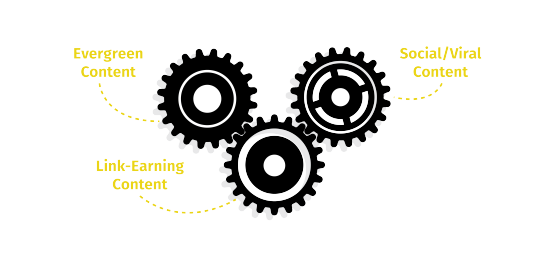
I call this our “Trifecta Strategy” because it has three basic components.
Here’s how we broke down each piece:
1. Evergreen content
This content was built for search. It was topical and keyword-focused.
Think of it like the meat and potatoes of the site. It answered questions like, “what’s a good ACT score?,” or, “what do colleges look for from students who apply?”
We knew that the people searching for these topics were our target market. We wanted them to find the answer with us so that we could then encourage them to check out the product we had to offer.

But this stuff wasn’t super sexy.
Not every post is bound for viral greatness or worthy of a million backlinks. And that’s okay.
In many cases, we barely even promoted this content–if at all. We let Google do all the heavy lifting and generate traffic over time.
By building out a huge library of this kind of topical, focused, evergreen content, we were able to cast a wide net–bringing in students and parents who were at different stages in the college search and admissions process.
2. Social-viral content
This content was designed specifically to play well within our target demographic market on social media. It was created to generate likes, shares, and traffic.
It didn’t have to be super informative. It didn’t have to be keyword optimized or meaty enough to get links.
Think like Buzzfeed.
“13 Owl Photos that Look Like Celebrities,” probably doesn’t get a lot of search traffic or earn a bunch of links.
But it goes gangbusters on Facebook.
And that drives a ton of traffic and creates brand awareness.
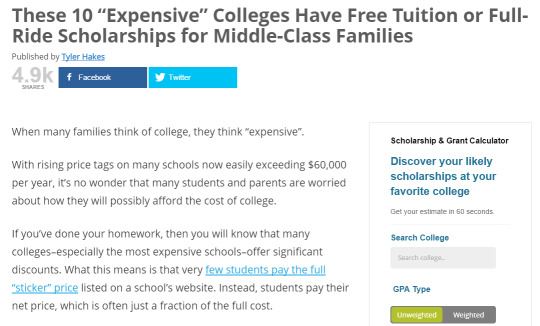
Using elements of surprise, fun, or intrigue make content go viral–but that’s an entire post unto itself.
We used social-viral content as a way to get our target market familiar with our site, to build awareness, and to start to earn trust.
You might also use this kind of content in a more traditional funnel to start to qualify prospects. You could use social-viral content to generate traffic and then use retargeting or other tactics to convert those visitors into leads.
3. Link-building content
Last, but certainly not least, we needed links to our site in order to put the evergreen content to work. Without strong domain authority, all of those articles were just lost out in the sea of Google results, probably somewhere around page 20.
By creating separate content assets that were specifically aimed at earning links, we were able to “raise the ship,” providing authority to our entire domain and raising the Google ranking of all of our pages.
This kind of content requires you to often times take off your marketing hat for a minute.
Forget about your target audience.
Instead, think about other sites, writers, or publishers.
What kind of content do they link to?
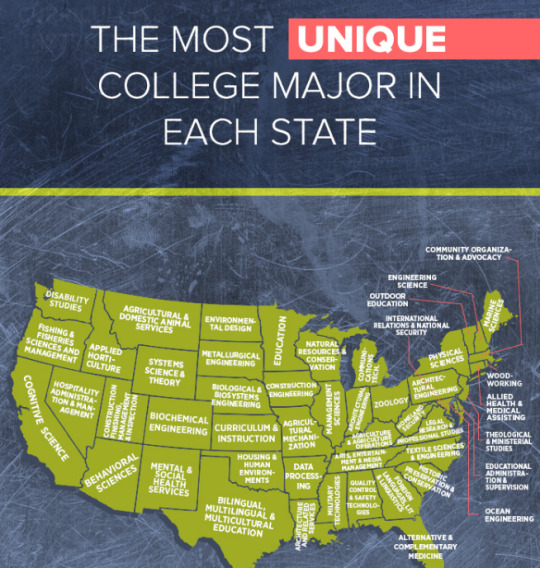
If you study this, you’ll realize that the kind of content that earns links from reputable websites is often not your run-of-the-mill blog post. It’s an engaging graphic, a new study, or an especially valuable resource.
But it’s also not as easy as simply publishing great content and waiting around for links. You need to do promotion and outreach to get the content in front of the right people. And that’s what we did.
For every piece of link-building content that we created, we spent about twice as much time doing research, compiling contacts, and doing email outreach.
Now you may be thinking that this Trifecta Strategy means you’ll have to create three times as much content. But that’s not really true. You don’t need 1,000 articles to generate 1,000 links–you only need one great resource with the right promotional strategy.
This is why the Trifecta Strategy is so effective.
It’s about creating a strategic mix of content, with each piece serving a purpose. It’s about making every piece of content work as hard as possible.
In our case, we did end up producing a lot of content in order to achieve the end result–because our addressable market was huge and there are a lot of different topics to cover. But in a smaller market, this strategy may only mean having a few really strong, product-focused landing pages that are propped up by content that’s used to earn links.
Either way, the main point remains true: Your content should work together to achieve the stated objectives. Each piece should have a purpose.
But each piece doesn’t have to serve every purpose.
Note: If this were a B2B company or you wanted to generate leads or email subs, we would also add content assets that are designed to generate leads like white papers, ebooks, email courses, etc. That would make it a “Quadfecta,” I suppose.
Using Public Data to Score Early Wins
One of the recurring things we noticed when studying different kinds of content was that most of the companies that really crushed it at building links were using data to do so.
Interesting studies, analysis, or maps–they’re everywhere. We all love a nice graphic or a data visualization. And unexpected facts and figures make for sexy headlines.
So, we set out to try to capture a piece of that success for ourselves.
One of our early successes was so simple, it seems crazy in retrospect.
We spent a few days coming up with ideas and putting together a piece of content–a nice infographic, backed by some data. Then we put together an outreach plan where we targeted news media and bloggers who we thought would be interested in what we had found.
We hit publish and sent out some basic outreach emails sharing the content with the writers we identified.
And we waited.
Was this going to work?
It was really our first attempt to grab some big attention and build links. We weren’t sure what the expect.
But just a few minutes after we sent out our emails, we got a big break.
I got this email:
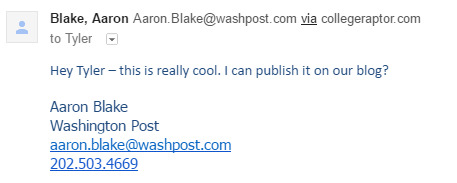
Holy shit.
We got picked up by the Washington Post.
But from there, things really took off.
Once the post went up on WaPo, our content got picked up by dozens of outlets.
The Houston Chronicle in Texas. The Deseret News in Utah. Minnesota Public Radio. Time magazine. We found out later that the content was even cited before the U.S. Supreme Court.
So what was this groundbreaking piece of content?
What compelled all of these news outlets to take heed and post us on their website?
It was a map of the United States. With some college logos. And a bit of analysis.
Seriously, here’s the post: Where the 114th U.S. Senate Went to College.
We literally looked up the list of U.S. senators on Wikipedia and researched each one to figure out where they went to school. Then we made it into a map and did some basic analysis.
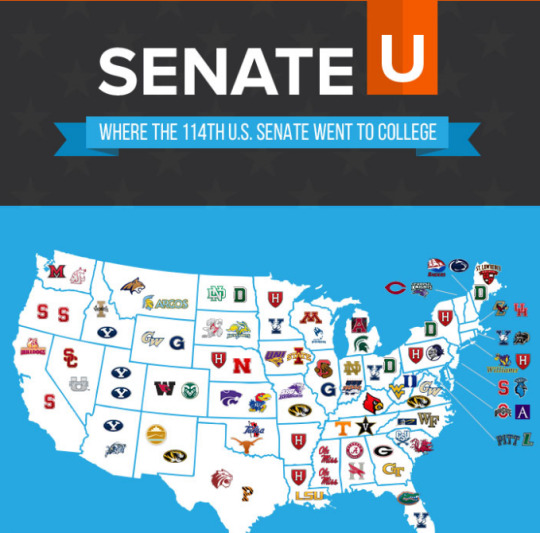
Trust me, it was not rocket science.
The biggest lesson to take away from our victory here is that you can totally use publicly available data to make cool content.
You don’t need to fund some expensive research study if you use the data that’s already out there. And there’s a ton of it.
We used other public data sources time and time again throughout the year to create rankings, infographics, maps, and other content and resources.
You can find data from a number of sources, but here are some ideas of where to look:
Public/government databases (we used IPEDS data extensively)
Manual research (like our data on the senators)
Google trends/keyword data (regional interests, trends over time, etc)
Published research and reports from academic journals
Trade publications and industry studies
Facebook advertising/page data
All of this data is out there–and it’s free.
The key to using it is to find new and interesting ways to approach the data. Take something that exists in the world and make it better, sexier, or easier to understand.
You can use this data to create things like:
Static infographics or data visualizations
Interactive data tools or resources
Maps, charts, and graphs
Ratings or rankings
Layered research based on data from multiple sources
Once you have something cool and interesting, then it’s just a matter of showing it to the right people. Email it to writers who cover the beat. Make it simple for them to pull it down and use it in their own stories.
Keep in mind that this content doesn’t necessarily have to be created for your primary audience. It should be related to your market, for sure. But the real goal here is to get links.
Writers and publishers in your industry are your target audience, not your average user.
Our infographic wasn’t really going to appeal to a 16-18-year-old high school kid. It didn’t really help them find the right college. But it helped us get links, which helped us bring traffic to all of our content that was aimed at our main audience.
Remember, the strategy is about putting together the pieces, not trying to make every piece of content meet all of your goals at once.
Our First Viral Success & What We Learned
Early on, we saw a lot of wins like the infographic from above. Little victories here, spikes in traffic there.
But nothing compared to our first big success.
In the last week of May, we published something new and different. At the time, we honestly weren’t sure how it would go.
We knew that we wanted to go after the world of college rankings, which are big game for many major publishers. But we couldn’t compete head-to-head on a list of “Best Colleges.” We didn’t have the authority to get traction there (yet).
So, we improvised. We put our own spin on things.
And we came up with the idea to create a ranking of “Hidden Gems.” These were colleges that, according to our methodology, were being overlooked by students when compared to other colleges of similar quality.
For the sake of simplicity, let me just say that this was a different kind of college ranking.
One of the things that we got right (in retrospect) was that many of the colleges we honored were not your typical “Best Of” colleges. They were still good schools, but they generally weren’t on a list of the top 100.
Fast forward to the day of the launch.
After spending a few days compiling all of the data, creating some graphics, and putting together the final post, we clicked publish. Then we got to work on outreach.
We had a plan to promote the content and put in front of people who mattered most. We sent out hundreds of emails and messages to colleges, newspapers, counselors, and anyone else we could think of who might help us spread the word about the ranking.
I spent the better part of the day drafting and sending emails.
Then we started to see results.
We watched as traffic started to pour into the site. 10 people. 20 people. 100 people. Pretty soon we had a steady stream–hundreds of people on the site at once for hours on end.

The colleges on our list were sharing the content on their social channels and their students and alumni were sharing it from there.
We were going viral.
When the dust had settled, we had the biggest spike in traffic to date.
250,000 visitors in just one week. That’s huge.
We also generated a ton of links–many from reputable news websites and EDU domains.
From this success, we learned a lot about what factors would help push our content over the top:
1. People love sharing maps
As you may be able to tell from our first big successes, people really, really love maps. Seriously, they do. And we figured out early that we could use them effectively. I think it plays on both our sense of identity and our sense of being different from other people in the country.
We would go on to use this as a cornerstone of our link-building strategy, segmenting data geographically whenever possible.
2. Vested interest helps expand reach
We were posting about colleges and shining a spotlight on their institutions. So, by including these colleges in the actual content, they had a vested interest in promoting the piece.
In total, we had a college from every state–or a base of 50 targets for outreach.
To boot, since we took a different approach in our rankings, many of the colleges on the list were not used to receiving national accolades. These weren’t the same 50 schools that are on the U.S. News list of top colleges every single year. But they were still good institutions.
This taught us the power of vested interest. Any time our content could help promote another entity, we could work with them to expand our reach and grow our audience.
3. Self-affirmation and positive social proof encourage sharing
The effect was amplified even further because each of these colleges had an audience of alumni and current students. All of them had their own vested interest in the positive social proof of having attended a “Hidden Gem” college. So many of them shared it and helped spread it far and wide.
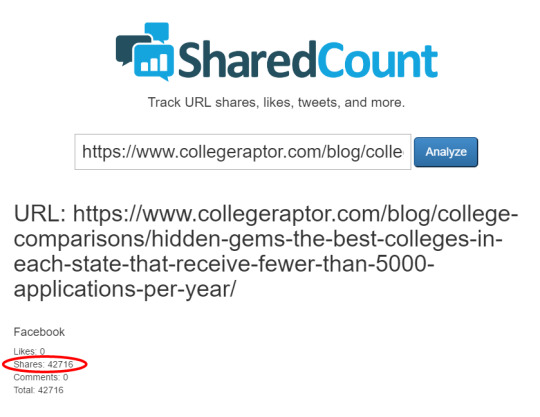
Our content ended up with tens of thousands of shares, likes, and comments. (Note: The numbers here don’t seem to be displaying likes/comments correctly, but the share count lines up with what we saw a few months after publishing the post.)
We learned that one of the keys to going viral is to create content that plays on our desire for self-affirmation. People love to share things from reputable, third-party sources that seem to confirm a belief they already have (e.g., they made a great choice by attending the college they chose.)
4. Coordinated outreach is critical
Outreach is ultimately what made this piece work.
We gathered hundreds of contacts. We wanted to make sure that someone saw it at each college. We wanted to send it to their respective local media. And we wanted other influencers to take note of a new type of college ranking that didn’t have the same 20 schools at the top.
Our team spent way more time doing outreach and follow-up to ensure the success of this piece than we did actually creating it.
That proved to be a big lesson for us moving forward.
Great content is great, but it ultimately doesn’t matter if noone sees it.
Although we had already focused on outreach, this caused us to realize the magnitude of the outreach we needed to do to achieve these kind of results.
5. Comprehensive promotional materials make it easy for people to help you
If you want people to promote your content, you need to give them everything they need to do it.
Make it so simple they can’t say no.
When we did outreach to colleges about this recognition, we didn’t just send them a link to our post.
Oh, no. We did way more than that.
We prepared a press release template. We created a visual badge. We gave them specific materials and instructions on how to promote and publicize the achievement.
And it worked.
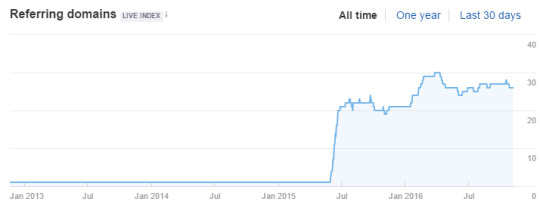
Dozens of colleges used the materials we put together and helped promote this piece, sending it viral, and generating tons of links back to our site–almost all of them from high-authority EDU domains.
Rinse & Repeat
Okay, so we had some big wins under our belt. I mean, we had just driven a quarter of a million people to our website in 7 days.
We made it. Right?
Well, not exactly. In fact, that was dead wrong.
We learned quickly that although we celebrated every win as a huge victory, the traffic quickly died down. Just as quickly as the Internet shines its light on you, it moves on to the next thing.
And that’s another big lesson to learn. Sustained growth for a website like this doesn’t come through a single flash of brilliance or a viral success. It almost never works that way.
It’s incremental. It’s slow–sometimes painfully so.
Keep in mind that what you’re doing is basically trying to assemble an airplane in mid-flight. You’re trying to create content that will rank well in search, while at the same time also earning the links that you need for that content to rank.
It’s not an overnight process.
And you will fail at times. You’ll spend too much time creating something you think is great, only to have it fall flat when it’s finally pushed out into the world. That’s okay.
The key is consistency and process.
Keep moving forward.
Hitting Explosive Growth
At this point, we were on a solid growth path. We were seeing steady increases in traffic and all of our existing content was rising in the SERPs.
We were about 8 months in and had about 150-200 linking domains.
But we didn’t set out to achieve slow and steady. We wanted big-time, hockey-stick growth.
So, we changed course.
When we got to this point, we knew we had an opportunity to really turn up the dial.
If each new piece of content that you publish lands pretty high on SERPs, then it becomes a question of how many pieces of content you can load up–how many unique search terms you can rank for.
This is because the domain authority that you’ve built helps lift each piece of content on your website.
More pages = more keywords = more traffic.
So, we slowed down our production of content aimed at generating links and social traffic and focused more on heads-down production of evergreen content targeted at relevant keywords.
We brainstormed hundreds of article ideas, digging into all of the topics related to the college search and admissions process.
We came up with content ideas by:
Looking at our competitors and identifying gaps
Doing extensive keyword research
Joining forums and communities with our audience asking questions
Sourcing questions from our existing audience
Over the course of a few months, we published about 200 articles.
This propelled us to the next level. Up until this point, we had seen a slow and steady growth in traffic.
But this step changed our trajectory.
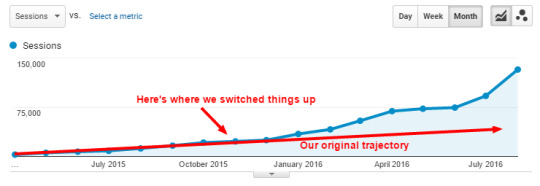
Now, we had over 300 articles on the site that were all working to bring in search traffic from our target audience on a huge range of relevant topics. Our traffic started to explode. We were growing at 20%-50% per month.
This worked because we had spent the first 8 months focusing almost entirely on earning links. We had generated enough domain authority that each new piece of evergreen content was almost certain to land somewhere on the first page of Google for the target keywords.
It’s worth noting that we didn’t have to do it in this order. We could have spent the first months doing a production sprint and building out a huge catalog of content. Then we could have spent the latter half of the year building links to “raise the ship” on the content that already existed.
The order doesn’t really matter, ultimately. And the results should have been ostensibly the same.
But there can be some strategic advantages to your order of operations.
In this case, we opted to build links first and then focus on building out more content. Since College Raptor had a number of data-driven, programmatic pages, building authority early started to show results right away, even if we didn’t have a lot of search-focused content.
What I Would Have Done Differently
Looking back over this year of work, it’s obvious that we accomplished something that many companies and startups only dream of achieving.
But that doesn’t mean we did everything perfectly right.
Although we had a lot of success, this was ultimately one giant learning experience. And I learned a lot.
Here are some of the things I would do differently:
1. Work smart(er), not hard(er)
Like many others, we started out with the assumption that our content really needed to be something special–something no one had ever done before, seen before, or even dreamed of.
We spent hours wracking our brains for ways to twist or layer data to make something new.
What I know now is that you don’t need to try to reinvent the wheel every time. There are easy wins to be had by simply looking for what’s been done and making incremental improvements or changes. In some cases, you can even take the exact same premise and put your own spin on it or create your own version. If you’re after links, you might simply do outreach to a different audience.
This doesn’t give you a pass to be lazy. You still need to create great content.
But you can be smart about it and learn from the experience of others.
2. Repurpose more
Another way to make better use of time and resources is to build repurposing into the core of your strategy.
This can take a lot of forms. It may mean creating a series of graphics that work as a big, long infographic and also can be broken down into smaller graphics that are used in a series of text-based posts. It might mean collecting a series of content that’s already published on your site and packaging it up into something “new.”
But, repurposing is a great way to get extra mileage from the work you’ve already done.
Look for opportunities to tie things together or use your assets in different ways or for different audiences.
Remember that just because you’ve read something on your site doesn’t mean everyone has. So there’s no shame in giving it a second, third, or fourth life.
3. Curate content where it works
It’s tempting to think that if there’s good content out there, you need to set out to make something better–bigger, sexier, more helpful.
But sometimes you should just take what’s already been given.
Notice that I didn’t use this case study to explain to details of how to craft a nice outreach letter or use a tool like Ahrefs to identify link opportunities. That’s because it’s already been done–a lot. So rather than simply rehashing what’s already been created, I just put together a collection of prerequisite resources.
In an age of so much content, sometimes the best thing you can do to add value is to simply serve as a filter.
Curate a list of the best of what’s already out there.
Many of the great content marketing and SEO experts of the world rely heavily on curating lists of other people’s content to provide value to their readers. And they can still use it to generate traffic and links.
Don’t underestimate the power of curation.
4. Focus more on design and presentation
Another thing to keep in mind is that looks matter a lot–probably more than you think.
Beyond just having a reasonably designed page, design can play a big role in the success of your outreach and link building. Many times, people won’t even read your content. They’ll skim and try to pick up some of the key points.
They’re busy and they just want to know, “is this a valuable resource of just some spammy junk?”
Having a page with a nice design can set their mind at ease quickly. A wall of text may contain the same information, but it doesn’t feel quite as nice as a well-designed guide with clear bullet points, section headings, and useful graphics.
Content is ultimately only useful it’s also usable.
Using the “Trifecta Strategy”
I wanted to share this experience not just to brag about the numbers (although they’re pretty impressive, if I do say so myself). But, because what we learned through this process was that this model–this content marketing strategy–could be applied to almost any business.
Let me be the first to say that it’s not easy.
In fact, it’s damn hard. It takes a ton of work.
But with focus and the right team, this same framework can be applied in nearly any industry–the three (or four) content types are universal.
What changes is the strategic mix of content that you need in order to achieve results.
Here are some tips for adapting this strategy:
1. Plan for SEO from the beginning
This strategy was ultimately so effective at generating huge amounts of search traffic because we went wide and shallow in terms of SEO. We had a huge number of pages related to a broad range of college topics.
If your business relies on ranking highly for a few specific keywords–like, say, an eCommerce store, for example–then your strategy will likely be different. Evergreen content may not be valuable in terms of bringing in traffic that actually converts. So your strategy may focus almost entirely on building links and driving social traffic.
Whatever the case, you must consider the SEO landscape of your industry and then adapt the strategy to help you compete there and achieve your goals.
2. Set a benchmark (the 7% rule)
The general rule for achieving the all-mighty hockey stick is that you should aim for 7% growth, week over week.
The same benchmark generally applies here. We used 7% weekly growth in organic traffic as a goal and it gave us something to chase after and also a way to project what our growth would look like into the future.
You probably won’t hit 7% every week, but if you’re seeing about 7% on average, then you’re probably in good shape.
3. Stay strategic
One of the reasons so many people fail at content marketing is because they lose sight of their strategy.
Instead of focusing on results, they just worry about publishing content–any content. Just to meet some arbitrary schedule or quota. But this is ridiculous.
Content takes time, money, and effort. And if you’re not using it strategically–if you’re blogging just to blog–then it’s simply an expense that isn’t generating a return.
Do what you need to focus on the strategy and make sure that every piece of content that you create and publish is being put to use as an asset. Everything you create should be focused on one of the core objectives of your strategy.
If you can’t immediately say what the purpose of a post would be, then scrap it.
Essential Reading
As I mentioned at the beginning of this post, most of our strategy was built on the teachings of many SEO and content marketing experts who generously share their time and knowledge.
People like Neil Patel, Noah Kagan, Robbie Richards, and Brian Dean were all hugely helpful in teaching me some of the fundamental laws of scaling traffic.
Since I didn’t have the opportunity here to rehash all of the specific strategies and tactics that I learned from them, I’ve packaged them up into a collection of essential ideas, strategies, and tactics for anyone who wants to apply this strategy or achieve similar results.
Grab a free copy of this collection of essential reading, tools, and know-how by email.

0 notes
Text
30 Lessons After 30 Million SEO Visitors
email marketing para windows 8
As you can see from the screenshot above, I’ve driven 30 million visitors to my website from SEO.
Technically it’s more, but who’s counting.
What’s funny, though, is I barely look at my traffic, even as Google continually rolls out algorithm updates.
I know that sounds contradictory because if you are an SEO, why wouldn’t you obsess about traffic, right?
Well, it’s because I’ve learned some hard lessons over the year… mainly because I’ve made a lot of mistakes.
So today, I wanted to share them with you so that you can learn from my mistakes… so here goes:
Lesson #1: Don’t obsess over rankings, obsess over conversions
I used to check my rankings every single day. Literally.
On top of that, I would log into Google Analytics 4 to 5 times a day and continually check my traffic.
That’s all I cared about back in the day… boosting my organic traffic.
But here is the thing: As my rankings and traffic went up over the years, my revenue didn’t go up proportionally.
For example, during one quarter in 2017, my SEO traffic went up 39.52%, but my revenue from SEO went up only 4.29%.
I quickly learned that traffic isn’t everything. If you can’t convert the traffic into revenue it doesn’t matter.
That taught me that you need to focus on the right keywords that drive conversions and continually optimize your site for conversions.
An easy first step for you to take is to install Crazy Egg and run a heatmap to see where people click so you adjust your design and copy to get more sales.
Lesson #2: The easiest way to grow your SEO traffic is international expansion
You already know that I get a lot of SEO traffic, but do you know what country drives most of my traffic?
If you guessed United States, you are wrong.
Brazil is my most popular region, followed by India.
International SEO is the easiest way to expand and grow your traffic. Here are a few posts that you should read before you expand your SEO globally:
How to create a global SEO strategy
Fundamentals of international SEO
How to correctly setup your site for international SEO
How to profitably expand your SEO globally
Lesson #3: Keywords are very, very, very, very important
When I used to write my content, I didn’t obsess about the keywords when I should have.
My team actually proved me wrong on this.
I used to focus on writing content for humans and didn’t worry about search engines. My team, on the other hand, obsesses about keywords.
Just look at the growth of our traffic in Brazil because of our obsession with the right keywords.
One simple thing I do before writing that has really helped is I head over to Ubersuggest and type in a few of the keywords that I want to go after.
Once it loads, you’ll see a report like the one above. I want you to then click on “Keyword Ideas” in the left-hand navigation.
You’ll see a report that contains a list of keywords that you could potentially be targeting.
Make sure you click on the “Related” tab, as well as “Questions” and “Comparisons” … scroll through the list. You’ll see hundreds of keywords. Pick all of the ones that are relevant and ideally have a high cost per click (CPC). These are the keywords that’ll not only drive traffic but revenue as well.
Whenever I write a blog post, I go through this step. Every single time.
Lesson #4: AMP pages can drive more SEO traffic
AMP pages load faster on mobile devices than non-AMP pages.
If you aren’t familiar with the AMP framework, read this.
What most people won’t tell you about AMP pages is that:
In regions like the United States, Canada, and the United Kingdom, countries with decent Internet infrastructure, you won’t see much of an increase in traffic.
In regions with poor Internet infrastructure, like Brazil, you’ll see a 10 to 15% lift in mobile SEO traffic by having AMP pages.
AMP pages don’t convert visitors into customers as well as normal responsive web design. So, you’ll have to work on testing your AMP pages so you can boost your conversion rates.
Lesson #5: SEO will never convert as well as paid ads
When I started off with SEO, I would run projections on how much the traffic would make me.
But the numbers were always off, even if I was able to get the rankings.
Here’s the main reason: If you are bidding on terms like auto insurance through ads, you can drive people to a landing page that looks like this:
But if you want to rank organically, you’ll have to do it through content. So, your page that ranks well will look more like this and convert less…
It doesn’t mean SEO is bad. In reality, it’s much cheaper in the long run than paid ads and will produce a better ROI. But don’t just assume that if you get 100 visitors from paid ads and 3 purchases that you’ll have the same conversion rate with your SEO traffic.
Chances are it will be significantly lower by maybe 2 or 3x, but because SEO is cheaper, it will be much more profitable.
Lesson #6: Remarketing is one of the best ways to generate an ROI from SEO
If you get a ton of traffic from SEO, there is a simple strategy you can implement to boost your conversions.
Remarket everyone on Facebook, Google, and YouTube.
That way people come to your site, read your content, and build trust with you and your brand.
Then you remarket them throughout the web with ads that prompt your products or services and send them to a landing page that will drive sales.
I’ve been doing this for years, just look at my old remarketing ad…
For the regions I use remarketing in, it is responsible for 46% of my leads.
Lesson #7: Don’t forget to update your old content
I publish one new blog post a week. I’m working on increasing this as I get more time, but for now, it is one a week.
Can you guess how many blog posts I update on a daily basis? Technically it is 0 (me at least), but my team focuses on updating at least 3 old blog posts per day. That’s roughly 90 a month.
Once you have a few hundred pages, make sure you focus on updating your old content or else your traffic will quickly drop.
You can use this content decay tool to see which posts you should update first.
This will help you continually grow your SEO traffic instead of hitting plateaus or seeing your traffic take massive drops.
Lesson #8: Don’t forget to optimize your title tags
One of the easiest ways to grow your rankings is to optimize your title tags.
If you can write persuasive copy and get more clicks, you’ll quickly move up on Google.
In Brazil, we spend more time doing this than we do in the United States.
We get a similar amount of impressions in Brazil, but we have more people focusing on improving our title tags and testing. Hence, we get 95% more SEO traffic in Brazil.
If you want tips on boosting your clicks, check out this article.
Another simple hack is to use the “Content Ideas” report in Ubersuggest.
On the right side of that report, you can see social share counts from Facebook and Pinterest. And on the left side, you see titles of articles.
Typically, if people like a title they share it more. So, look for titles that have a lot of shares as it will give you ideas on what you can use on your website to get more clicks and boost your rankings.
Lesson #9: Don’t put dates in your URL
I used to put dates in my URLs like:
Neilpatel.com/2017/12/title-of-post/
This causes search engines to assume that your content is related to a specific date. And after that date gets old, search engines assume your content is irrelevant and outdated.
The moment I removed the date from my URLs, I grew my SEO traffic by 58% in 30 days.
youtube
If you have dates in your URL, make sure you 301 redirect your old URLs to your new ones once you make that change, or else your rankings will drop.
Lesson #10: Don’t be afraid to use popups
Don’t you hate popups? Well, who doesn’t?
But people use them because they work.
The majority of your pages that will rank are blog-related content. And blog posts tend to drive fewer direct conversions because people are on your site to read the content.
In order to maximize your conversions from SEO, you should consider using exit popups so you can convert more of those visitors into customers as they leave.
When you leave this site in most cases, you’ll see a popup that looks like:
And it drives you to this quiz, which allows me to convert SEO visitors into customers.
You can easily copy me by using Hello Bar. It works for all industries including B2B and ecommerce and even lead generation sites.
Lesson #11: Brand queries affect rankings
Everyone talks about how you need links to boost rankings.
But very few people talk about brand queries.
As Google’s ex-CEO and ex-head of web spam both emphasized how brands are important.
One of the big reasons for my growth in SEO traffic is the growth in my brand. I’ve seen a direct correlation in which the more people who find me from my name, the more SEO traffic I get.
Just look at my brand growth over time:
I’ve received over 1.9 million visitors over the last 16 months from people typing in variations of my name in Google.
Lesson #12: Don’t waste your money on paid links
I’ve been doing SEO since I was 16 years old. That’s a long time…
When I started off as a kid, I dabbled in paid links and I used to dominate Google for terms like online casino, online poker, web hosting, auto insurance, and even credit cards.
And I was making a killing off of affiliate income from these sites.
But it was all short lived.
Why?
Because I bought links. And eventually Google penalized all of those sites.
If I never purchased links, those sites would have taken longer to rank, but they would have been around today, and I would have generated more income overall.
Don’t buy links, it’s bad and shortsighted.
Lesson #13: Guest post to build a brand, not to build links
I already covered the importance of branding above.
A great way to build your brand and indirectly boost your SEO traffic is through guest posting.
But don’t use guest posting to build links.
Most sites that offer guest posts, nofollow them (which they should), and Google is smart enough to know what a guest post is, hence they ignore guest post links from sites like Forbes.
It’s pretty easy to spot a guest post for both a human and algorithm…
But if you are using it to build a brand, great. Focus on the content quality and not links.
Lesson #14: Don’t forget to interlink
Do you know what some of my highest ranked pages are?
The ones that are interlinked.
It takes anywhere from 6 months to a year for many of the interlinks to kick in, but it is still effective none-the-less.
Every time I wrote content, I used to make sure I link out to my older pieces of content when it made sense. But I made a big mistake… I wasn’t going into my older pieces of content and then adding links to my newer pieces of content.
That one change was game-changing for me. It took time to see the results but it worked exceptionally well.
It’s how I rank high for terms like “email marketing”.
Lesson #15: Google isn’t the only game in town
Although Google is the most popular search engine, it isn’t the only one you need to focus on.
Did you know that YouTube is the second most popular search engine?
Even Bing gets a lot of traffic.
If you want to rank high on Bing, follow this.
Or if you prefer video, watch this:
youtube
As for YouTube, this guide will teach you YouTube SEO. It works really well, just look at my YouTube SEO traffic:
Over the last 28 days, I received 429,501 video views through YouTube SEO.
Lesson #16: Speed is everything
The faster your server and the more optimized your site, the more traffic you’ll get.
Years ago, my friend Otis added more servers to his site GoodReads.
Within a month, his SEO traffic went up over 20%.
Speed is part of Google’s algorithm, so optimize it for both web and mobile.
A quick way to see your site’s speed is to enter your URL here.
You’ll see a report that breaks down your mobile and desktop load times as well as what you can do to improve them.
Lesson #17: Quality over quantity
SEO used to be a game of quantity over quality.
That isn’t the case anymore. With over a billion blogs, Google has its fair share of sites to choose from.
Just look at About.com. Eventually they renamed it Dotdash and changed their strategy.
They took all of their About.com content and moved it over to 6 vertical based sites and deleted 900,000 pages of junk content.
This grew their traffic and revenue by a whopping 140%.
Focus on writing high-quality content. It’s why I blog less and try to make my content amazing.
Lesson #18: Tools are better than content marketing
I used to focus all of my energy on content marketing because it drove a lot of links and SEO traffic.
But over time, I realized that creating free tools builds more natural links than anything else I have ever tested.
Just look at Ubersuggest. I spent years creating it and look at how many links it has generated…
30,603 backlinks! That’s a lot of links.
If you don’t have the resources to build a custom tool like me, you can always start with buying a white label tool from Code Canyon for $10 or $20. They literally have tools for almost all industries.
Lesson #19: Don’t rely only on SEO
When I first got started in SEO, all I could think about was SEO.
To me, it was the best marketing channel out there because it allowed me to compete with large companies.
Even to this day, I still love SEO more than any other channel.
But it doesn’t stop me from leveraging other marketing channels.
See, years ago you could build a business off of one marketing channel.
Yelp was built through SEO. Dropbox through social media referrals. Facebook through email invites…
Those days don’t exist anymore. You can’t just build your traffic from one channel.
Although you should do SEO, you should also try paid ads, social media marketing, email marketing, push notifications, and anything else that comes out.
Diversify your traffic sources and don’t just rely solely on SEO.
Lesson #20: People love linking to data
Spending money and time to gather your own unique data is an easy way to build links.
Check out my posts on content marketing trends and social media trends.
I’ve added tons of unique data, stats, and charts to each of those posts.
The end result? Extra backlinks. 🙂
The content marketing trends post received 447 backlinks.
If you don’t have the time to gather custom data you can always find someone on Upwork to help you out.
Lesson #21: Don’t forget about Infographics
One of my favorite SEO strategies that still works well today is infographics.
I have tons of them on the NeilPatel.com blog.
I didn’t start off with infographics here… I used to do them on my old blog Quick Sprout and KISSmetrics.
Here’s an interesting stat for you when I used to crank out infographics on KISSmetrics.
Within a two-year period, from 2010 to 2012, 47 infographics generated 2,512,596 visitors and 41,142 backlinks from 3,741 unique domains. They also generated 41,359 tweets and 20,859 likes.
If you don’t have money to hire a designer, you can use Infogram or Canva to create one on your own.
Lesson #22: Google doesn’t penalize for duplicate content
You don’t want to post tons of duplicate content on your site as it’s not the best user experience, but keep in mind that Google doesn’t penalize you for duplication.
They may not just rank the duplicate content as well.
So, if you spend all of this time producing amazing, unique content, why not publish it FIRST on your own website.
Then after a few hours or days if you want to be safe, take that exact content and publish it on Facebook, LinkedIn, and anywhere else that will accept your content.
Literally, take all of the words and paste them onto those social channels.
It will get you extra awareness and branding. Plus, the content should already be indexed on your site, so Google knows it came from your first… and I doubt you care if the duplicated version on LinkedIn ranks. That’s still great branding.
In other words, don’t be afraid to repurpose your content even if it causes duplication.
Just look at this post, for example. I’m also repurposing it into a 4-part podcast series.
Lesson #23: Don’t recreate the wheel
I used to spend hours a week doing keyword research trying to figure out what new terms to rank for.
Eventually, I figured out an easier and better way to find new content topics and keywords to go after.
Go to Ubersuggest, type in your competitor’s domain name and hit search.
In the left-hand navigation click on Top Pages.
You’ll see a report that shows you all of the popular pages on your competition’s website. This will give you ideas for the type of pages you should create on your website.
Then I want you to click “View All” under Est. Visits (estimated visits). This will show you all of the keywords that drive traffic to that page.
You now have a list of topics and keywords for each topic to go after.
Lesson #24: Don’t pick a generic domain name
Remember how in Lesson 11 I talked about brand queries and how they helped rankings?
After I learned that, I decided to go buy exact match domain names where the domain name was the keyword.
That way I would get lots of brand queries without trying.
Well, there’s an issue… even if you rank high, what you’ll find is you will have a low click-through rate in most cases.
If you have a low click-through rate, it tells Google your brand isn’t strong and people don’t prefer it, which can hurt your ranking.
So instead of focusing on exact match domains, unless you have millions to spend on branding like Hotels.com, focus on building a memorable brand.
youtube
Pick something that is unique, easy to spell, and easy to remember.
Lesson #25: Learn from blackhat SEOs, but don’t go over to the dark side
Blackhat SEOs come up with some interesting data and experiments.
Many of them don’t work for long, but they are interesting none-the-less.
Although I don’t recommend practicing blackhat SEO, I do recommend following them.
The easiest way you can learn from them is by reading Blackhat World.
People there share some interesting insights, especially every time there is a major Google algorithm update.
Again, I don’t recommend practicing blackhat SEO, but following them may help you uncover “white hat” techniques that can increase your rankings. Not everything they do is bad… many of them use legitimate tactics as well.
Lesson #26: Short URLs rank better than long ones
My URLs used to be the title of my blog post.
For example, with this post I would have used this URL in the past…
Neilpatel.com/blog/30-lessons-after-30-million-seo-visitors/
Eventually I switched to short URLs.
Google just prefers them. And I’ve seen it firsthand. That’s why I use short ones now.
URLs at position #1 are on average 9.2 characters shorter than URLs that rank in position #10. So, keep them short.
Lesson #27: The power’s in the list
If you want your content to rank high on Google, you need more people to see it.
Whether it is from social shares, or from push notifications or email blasts… the more people that see your content, the more engagement it will get, and the more people that will link to it.
I used to do a ton of manual outreach every time I published a new blog post and I would email people asking them to link to me.
And it works, it’s just time consuming and a pain.
These days, I have a better strategy… send out an email blast every time I publish a new post.
I can now get anywhere from 20,000 to 50,000 clicks per email I send out.
Now of course you won’t get that from day one as it took me years to build up my email list.
But you can start today by collecting emails. You can easily do that through Hello Bar.
And as your list grows, so will the clicks to your blog and the number of links you get, which in turn will increase your rankings.
Lesson #28: Don’t let your foot off the peddle
This was one of the hardest lessons I learned.
It’s exhausting to continually blog and do your own SEO. Sometimes you just want a break.
With my old blog, Quick Sprout, I used to publish 12 blog posts a month and I did that consistently for 3 years.
One day I decided that I wanted to stop for a month. So, I took a 30-day break.
Guess what happened to my traffic?
It tanked by 32%.
So, then I started blogging again. And guessed what happened to my traffic after I started blogging?
It didn’t come right back.
It took me 3 months to get back to where I was.
When things are working for you, don’t slow down. Keep pushing harder, even if you are exhausted. Because the moment you stop, you’ll drop, and it is a lot of work to get back to where you were.
Lesson #29: The best SEO advice comes from conferences
The best SEO advice I have ever learned over the years has come from conferences.
And no, I don’t mean by sitting in on the sessions, although you can learn from those too.
The best SEO secrets and advice I learned came from networking. When you go to these conferences, hundreds if not thousands of other SEOs are there. And when you go to the bar after hours and mingle with people, you’ll quickly pick stuff up.
You’ll be shocked at what people tell you. It’s how I learned a lot of the good tactics that I still use today.
Lesson #30: Never stop learning
This one may sound obvious but when things are going well, people get complacent.
Google makes on average 3,234 updates per year and that count has been increasing over time.
Just think about that for a bit… that’s roughly 9 algorithm updates per day.
Because they are changing so quickly, you won’t survive if you don’t stay up to date.
Yes, the ideal strategy is to do what’s best for your users or visitors as in the long run, Google wants to promote those sites, but it doesn’t mean that you can ignore the changes happening in the industry.
Read all of the SEO blogs out there, attend conferences as I mentioned above… experiment on test sites… push yourself to be better.
That drive of always improving and always wanting to learn more has helped me tremendously. It’s one of the reasons for my growth in rankings over the years.
Conclusion
There are a lot of lessons that you will learn as your rankings grow and as you spend more time on SEO.
But hopefully, you don’t have to waste time and go through the same mistakes I made. You don’t want to learn these lessons the hard way.
That’s why I decided to share them. I want to save you the time and help you achieve your traffic goals faster.
Which SEO lessons have you learned?
Youtobe
0 notes
Text
Break Free B2B Marketing: Latane Conant of 6sense on Reinventing the CMO Role
What’s in a job title? In my tenure as a marketer, I’ve met gurus who don’t live on mountaintops, ninjas who don’t know martial arts, and evangelists who don’t preach on Sunday. At worst, these creative job titles are pure puffery. But at best, they serve as a statement of purpose. I’m thinking of titles like Shep Hyken’s Chief Amazement Officer, or Ann Handley as Chief Content Officer: They tell us something about what the person — and their organization — values. Latne Conant from 6sense has a subtly unusual job title: Chief Market Officer. She dropped the ‘ing’ from ‘Marketing,’ and that tiny change signals a major shift in the way she approaches her job. Instead of focusing on the verb of marketing — what tactics to deploy to reach an audience — her job is to deeply understand the market, the people her brand is trying to reach. For Latane, getting rid of that ‘ing’ makes all the difference in turning marketers into revenue-generating dynamos. In her Break Free B2B interview with our president and co-founder Susan Misukanis, Latane elaborated on how 6sense’s approach is unique, what technologies they use, and how they’ve achieved some truly impressive results. [bctt tweet="“If I am engaging accounts more effectively than my competition, I will generate more pipeline, I'll win more often, I'll have bigger deals, and I will set my relationship off with those customers better.” #B2BMarketing @LataneConant @6senseInc" username="toprank"]
Break Free B2B Interview with Latane Conant
youtube
Timeline and Highlights :58 - How can CMOs better understand customer insight in the age of the “dark funnel?” 2:52 - Changing focus from the tactics of marketing to knowing your audience 4:00 - The Chief Market Officer - losing the “ing” 6:45 - Not accepting limitations in pursuing a career 7:29 - Getting what you want is easy; knowing what you want is hard 8:30 - The Fun Factor in managing a team 9:00 - V2MOM and organization 10:15 - If you’re not effing up, you’re not pushing the envelope hard enough 12:21 - Inverting the org chart — leading from the bottom 13:45 - Leads are not the primary measure of success 16:10 - Marketing is a revenue team 17:25 - Engagement is the new oil 18:45 - The new standard for marketing executives Susan: You were recently quoted saying that today's CMOs need to be the masters of understanding customer insights and putting them to use. So are CMOs progressing in this area of insights, or is it just still a massive black hole, and that's why you're preaching? Latane: Well, first of all, I hope I would never seem preachy, because we are all in this together, we're all in the black hole together. I think the challenge that we have is only 13% of sales and marketing teams have any confidence in their data, because it's primarily opportunity data in CRM, or it's map data, which is basically lead-based. And if you think about the buying journey, most of it happens anonymously, or what we at 6sense call your “dark funnel.” So that's where all the rich research is really happening. No one's coming to your website and downloading your content anymore. It's also a buying team. It's not a lead or contact, and buyer journeys aren't linear. So you think about this new modern buying journey, which is anonymous. It's a buying team, not a leader contact, and it's not linear. And you look at the tools that we have at our disposal as CMOs, and it's sort of like we are a Model T trying to get to the moon. And so thinking about the black hole, it's really looking for platforms that are AI and big data based. Because at the end of the day, even if you're amazing, your data is gonna suck, and it's okay. So I think admit that all our data sucks. Yeah, we've got to marry our data up with a much bigger platform and be able to understand that anonymous activity so we have a true picture of this nonlinear buying journey. Once you have that, you can start to re-imagine a better what I call prospect experience. Susan: How do you manage your teams and get them motivated? How do you hold the bar where you hold it? Latane: I would say the first thing is I'm clear that my expectations are high. And I'm very clear in the interview process, that my expectations are going to be very, very high. And you have to want that! Some people don't want that. So the first thing is, do you want to do good work or do you want to do great work? And it is okay if this is not the gig for you. So I think that's the first level of it. The second level of it is, I really believe in having fun. So my old CEO, Chris Barban, taught me this: He said, eight out of 10 working days, you must be having fun. And that’s we call the fun factor. And so everyone on my team, what's your fun factor? And if it's not an eight, what's going on, but it's also up to me to bring the fun, right? To say, hey, let's go grab a soulcycle class or let's go for a run or let's — you know what, we're all strung out — let's do something fun together. So, I think having fun and enjoying each other is allowed. We laugh a lot. We joke around a lot. And then the third really key thing for me is a strategic planning process that I use called V2MOM. And it originated with Salesforce. But it's now really popular — a lot of tech companies use it and I've used it at two companies now, and two of the boards that I work on have adopted it, and it's all about prioritization. I don't know if I can cuss on this show, but I consulted The CMOs that I work with, from an advisory perspective, I say you have to know what you give an F about. And know what you don't give an F about, because you can't give an F about everything. So what V2MOM forces is everything is time-bound, and everything is prioritized. So I have high expectations for these things. I don't care. Don't wait. Like, if you're spending one second over there — that's not going to be an excuse for missing on this. And we all agree to those priorities every single quarter. So it's very clear what we're doing and we're gonna do it right. Latane: I actually just changed my title to Chief Market Officer. And it's an important distinction that a lady who was actually on our board — who's amazing, her name is Christine Heckard, And she's been a CMO. And now she's the CEO. And she's talked a lot about the role of the CMO. And we have gotten ourselves really mired down in ‘ing.’ “I did a blog, I did webinars, look at all these MQLs I pass to sales, here's my funnel, here's my tech stack.” That is all ing ing ing. Her challenge to CMOs is to redefine that. We are the seat at the table that needs to understand the market. That is customers today and customers tomorrow. That's why this audience-first approach and understanding the market, then you can apply the ing. But it's not a cheap financing offer sir or cheap selling officer. We sort of diminished our role by not taking that seat at the table. Stay tuned to the TopRank Marketing Blog and subscribe to our YouTube channel for more Break Free B2B interviews. Here are a few more highlights from this season:
Danny Nail of SAP on Creating a Global ABM Platform
Beyond the MQL with 6sense’s Lisa Sharapata
Enterprise-Level ABM with Oracle’s Kelvin Gee
Break Free B2B Marketing: Latane Conant of 6sense on Reinventing the CMO Role published first on yhttps://improfitninja.blogspot.com/
0 notes